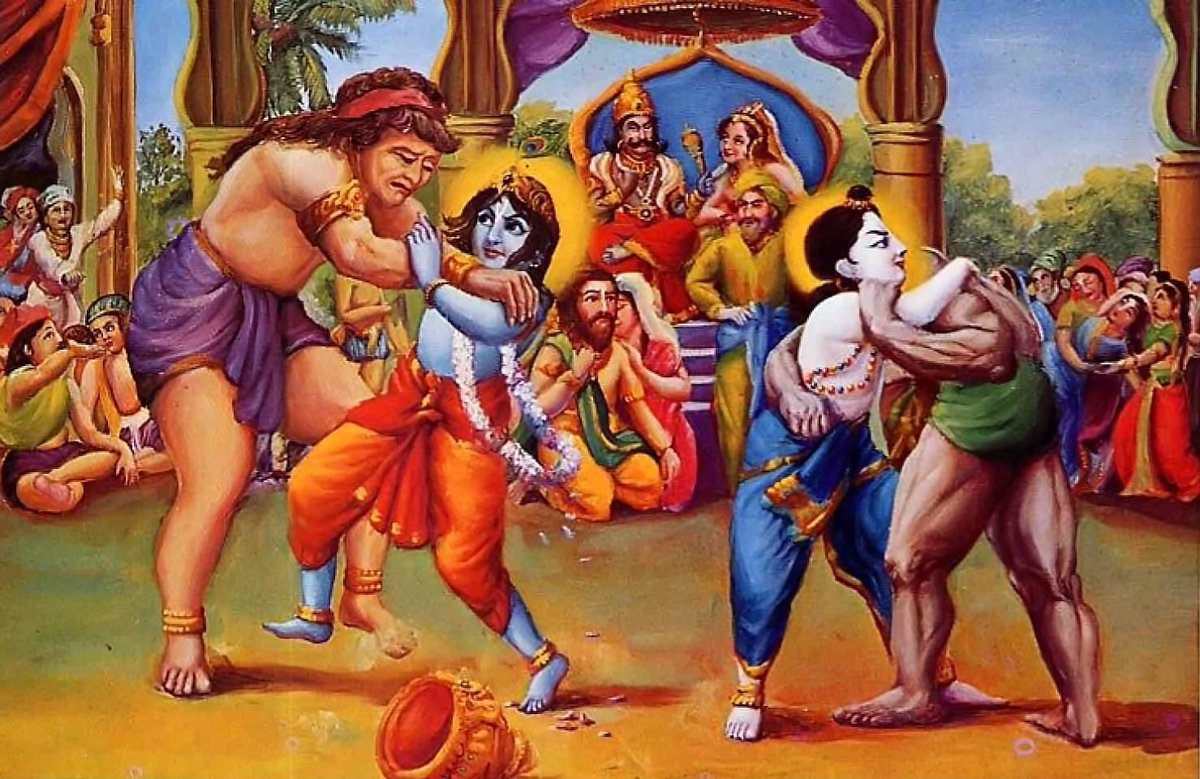The month of Margazhi begins today.
For these 30 days, temples and devotees celebrate the glory of the Lord in the month of Margashira.
Why this month?
Krishna says in Bhagvad Gita, among months He is Maargashira.
Maasanaam Maargasirsoham - BG 10:35 #Thiruppavai
For these 30 days, temples and devotees celebrate the glory of the Lord in the month of Margashira.
Why this month?
Krishna says in Bhagvad Gita, among months He is Maargashira.
Maasanaam Maargasirsoham - BG 10:35 #Thiruppavai
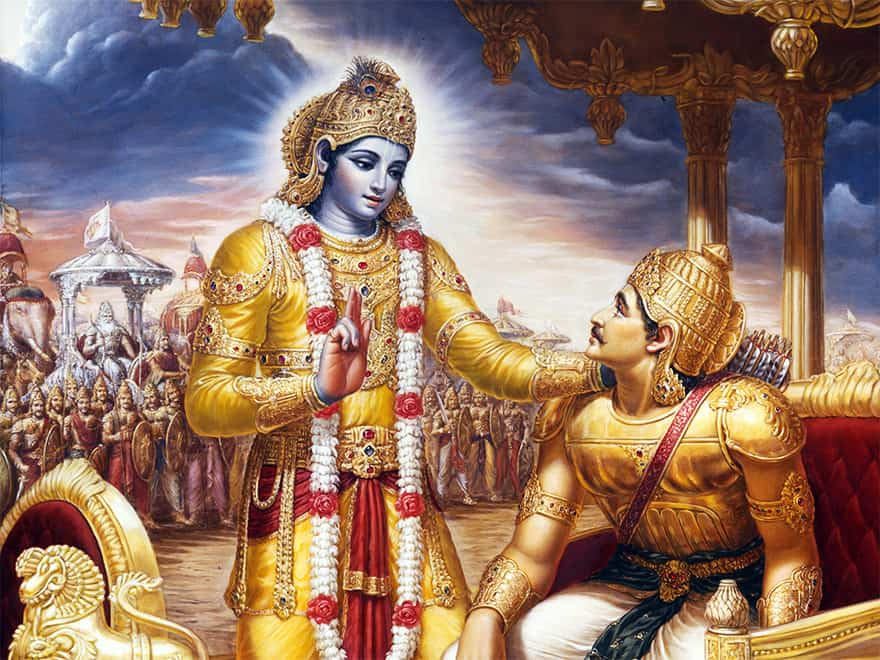
The millenia-old Bhakti movement in the Tamil land found its supreme manifestation in the form of the 12 Azhvars and 63 Nayanmars.
Their literary contribution to Tamil, through the Tirumurais and NalayiraDivyaPrabhandham remains unparalleled.

Their literary contribution to Tamil, through the Tirumurais and NalayiraDivyaPrabhandham remains unparalleled.
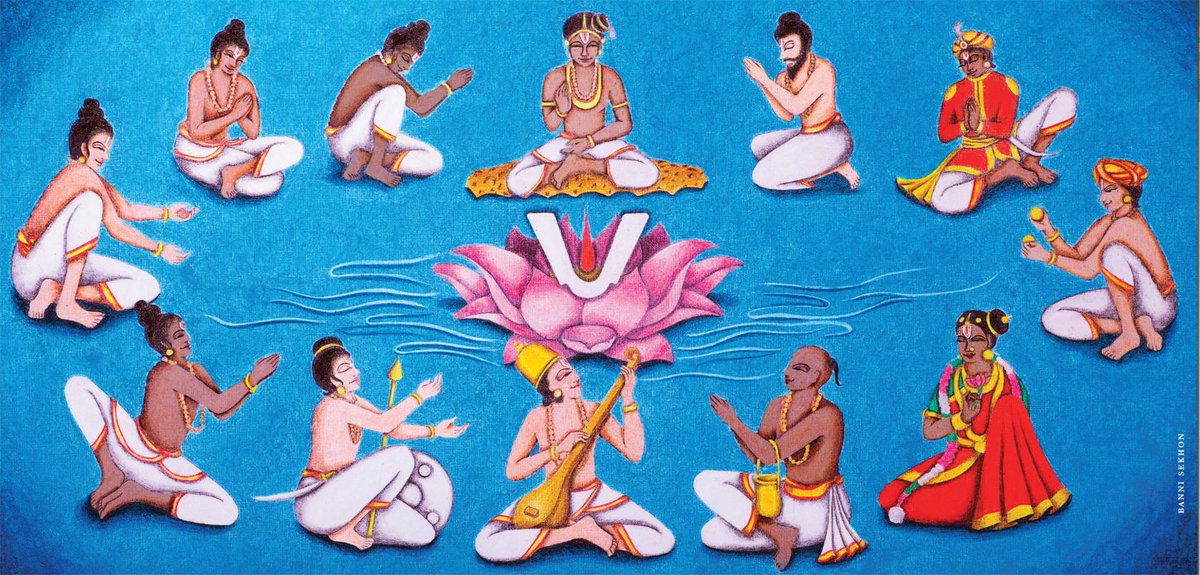

Andal was one of the 12 Azhvars, devoted to Vishnu, more specifically His form as Krishna.
She was the daughter of Vishnu Chithar, a devotee who is venerated as Periazhvar!
She was the daughter of Vishnu Chithar, a devotee who is venerated as Periazhvar!

Periazhvar would pick flowers from the gardens and make garlands out of them for the murti of Vishnu at the Vadapathrasayee temple in Srivilliputhur, Tamil Nadu.
All this when Andal was a young girl! With young girls and their fathers, can chaos be far behind?
All this when Andal was a young girl! With young girls and their fathers, can chaos be far behind?

So, one day, Periazhvar spent his early morning picking flowers and making garlands out of them. Before leaving for the temple, he placed the garlands near the door, and stepped out for a moment.
Enter Andal! She picked up the garland and tried it on.
Enter Andal! She picked up the garland and tried it on.

Hearing her father's footsteps, she immediately placed it back and went back to playing.
Oblivious to everything that happened, Periazhvar took the garlands to the temple.
Oblivious to everything that happened, Periazhvar took the garlands to the temple.
The next day Andal got a little more curious. She wore the garland and admired her reflection in the mirror for quite a while before her father returned.
The next day was even better, she set her hair before trying on the garland.
Periazhvar knew nothing about any of this.
The next day was even better, she set her hair before trying on the garland.
Periazhvar knew nothing about any of this.

This had become a bit of a daily habit.
Until one day!
Andal had gotten too carried away and not heard Periazhvar returning.
Or perhaps, the reflection in the mirror was no longer her own, but her beloved Krishna's!
Until one day!
Andal had gotten too carried away and not heard Periazhvar returning.
Or perhaps, the reflection in the mirror was no longer her own, but her beloved Krishna's!
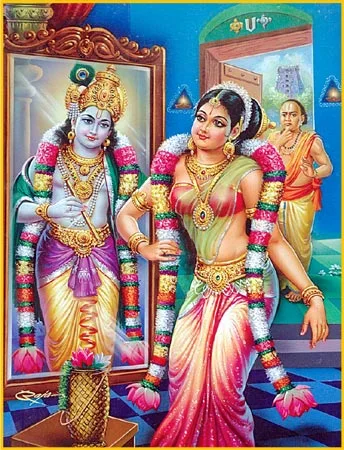
But that wasn't what Periazhvar saw!
He saw his young girl playing with flowers meant for the Lord of the Universe!
Periazhvar was beyond himself!
How could she taint them by wearing them before He did?
What grave sin!
He saw his young girl playing with flowers meant for the Lord of the Universe!
Periazhvar was beyond himself!
How could she taint them by wearing them before He did?
What grave sin!

Periazhvar snatched the garland from Andal's hands and chided her on the misdemeanor.
Her crying eyes told him he had gone too far.
She was after all a mere child! What would she know?
But... Periazhvar stood frozen.
It was his fault after all.
Her crying eyes told him he had gone too far.
She was after all a mere child! What would she know?
But... Periazhvar stood frozen.
It was his fault after all.
After all, it was Periazhvar who had sat Andal on his lap and told her all the stories about Krishna.
If Andal got interested in the garland, it was because of him.
(This thread will have several paintings by the blessed @keshav61! Thank you, Svamin!)
If Andal got interested in the garland, it was because of him.
(This thread will have several paintings by the blessed @keshav61! Thank you, Svamin!)

Periazhvar shook off his confusion, and rushed into the garden.
He picked fresh flowers and sat down to making another garland.
Just as he was about to finish, the temple bells rang.
He picked fresh flowers and sat down to making another garland.
Just as he was about to finish, the temple bells rang.
It was time.
Periazhvar placed the garland on a plate and rushed to the temple, begging for the Lord's forgiveness all the way.
The priest saw him entering sweaty and tense, and snatched the plate from his hands.
"Why are you late? Don't you know the time for the pooja?"
Periazhvar placed the garland on a plate and rushed to the temple, begging for the Lord's forgiveness all the way.
The priest saw him entering sweaty and tense, and snatched the plate from his hands.
"Why are you late? Don't you know the time for the pooja?"

Periazhvar apologised profusely and watched as the priest placed the new garland around the Lord.
You'd think the issue would be over.
Nope.
The Lord had other plans. He always does, doesn't He?
You'd think the issue would be over.
Nope.
The Lord had other plans. He always does, doesn't He?

The thread of the garland broke and it fell down.
The priest picked it up, knotted&placed it again.
Again it fell. After a few more attempts, the priest pursed his lips and turned towards Periazhvar.
Periazhvar was melting in a pool of his own sweat, eyes laden with tears.
The priest picked it up, knotted&placed it again.
Again it fell. After a few more attempts, the priest pursed his lips and turned towards Periazhvar.
Periazhvar was melting in a pool of his own sweat, eyes laden with tears.
"Looks like Bhagavan does not want this garland today. May be you can make another one and bring back in time for the next pooja?"
"Yes, svamin!" Periyazhvar muttered and left quietly.
"Yes, svamin!" Periyazhvar muttered and left quietly.
He went back home, ignored Andal sitting in the corner still crying, and picked up his basket to go collect flowers again.
In a trance, chanting "Narayana" continuously for forgiveness, he made a garland and took it to the temple.
In a trance, chanting "Narayana" continuously for forgiveness, he made a garland and took it to the temple.
But there, it's deja vu all over again!
The priest once again turned to Periyazhvar,standing there head bowed, hands in prayer.
Before the priest spoke, a voice filled the hall.
"I do not want this mala. Bring me the one Andal wore!"
The priest once again turned to Periyazhvar,standing there head bowed, hands in prayer.
Before the priest spoke, a voice filled the hall.
"I do not want this mala. Bring me the one Andal wore!"

Periyazhvar may have seen Andal wearing the garland that morning, but the Lord had been watching it from Day One!
After all, the One with a thousand eyes, sees all!
After all, the One with a thousand eyes, sees all!

Before the priest could even gasp at the voice, Periazhvar was home, picking up the garland in one hand, and dragging Andal in another.
She followed, not knowing what had happened.
He brought them both to the temple, as the priest still stood fixed to the spot.
She followed, not knowing what had happened.
He brought them both to the temple, as the priest still stood fixed to the spot.
Periazhvar offered the garland to the priest, who pointed at it and then at Andal.
Periazhvar nodded. The priest took the garland and placed it on the murti.
The thread did not break. Instead, a bright glow enveloped the murti.
Periazhvar nodded. The priest took the garland and placed it on the murti.
The thread did not break. Instead, a bright glow enveloped the murti.
The Lord spoke. "From now, I shall wear only those garlands that Andal has worn"
Periazhvar picked his daughter up in his arms and placed his teary eyes on her feet.
"My daughter! Soodi kodutha Sudarkkodi!The one who wore and gave it to the Lord!" he said.
Periazhvar picked his daughter up in his arms and placed his teary eyes on her feet.
"My daughter! Soodi kodutha Sudarkkodi!The one who wore and gave it to the Lord!" he said.
Having already been blessed by the Lord, Andal spent her time in bhakti, singing her father's compositions with him.
In those songs, she learnt about the Gopis of Gokula, the ones who sang, danced and became one with Krishna.
In those songs, she learnt about the Gopis of Gokula, the ones who sang, danced and became one with Krishna.

The bhakti of the Gopis overwhelmed her. She wondered if she too could be a gopi.
She decided that she would follow the Katyayini Vratam, as the Gopis had done.
But instead of dedicating it to Katyayini, she would dedicate it to Krishna Himself.
Why?
She decided that she would follow the Katyayini Vratam, as the Gopis had done.
But instead of dedicating it to Katyayini, she would dedicate it to Krishna Himself.
Why?
Because Andal had already concluded that Krishna is both the Upayam (the means) and the Upeyam (the goal).
Her dedication is to Krishnanubhavam, and the means for that will also be Krishna Himself!
Her dedication is to Krishnanubhavam, and the means for that will also be Krishna Himself!
So, for her vrata, Andal picks the month of Margazhi (which is dear to Krishna as we discussed before).
For the 30 days of the month, she sings a Pasuram ( a poetic hymn in 8 verses) a day, dedicated to Krishna.
For the 30 days of the month, she sings a Pasuram ( a poetic hymn in 8 verses) a day, dedicated to Krishna.

We'll be looking at the 30 Pasurams of #Thiruppavai , one a day.
May Andal, the one who wore and gave it to the Lord, bless us in this endeavour!
May Andal, the one who wore and gave it to the Lord, bless us in this endeavour!

The 1st word of the 1st Pasuram of #Thiruppavai is the month of Margazhi itself.
Andal starts by saying that it is an auspicious day.
And how auspicious?
It is the full moon of the sacred month of Margazhi (the full moon is day after tomorrow this year).
Pic: Srirangam
Andal starts by saying that it is an auspicious day.
And how auspicious?
It is the full moon of the sacred month of Margazhi (the full moon is day after tomorrow this year).
Pic: Srirangam

Since the day is so auspicious, Andal invites the bejewelled maidens of the village to join her in going to the river for the bath.
Maidens? Where are they?
Maidens? Where are they?

Remember Andal is following the Gopis of Gokula in observing the vrata, so she pictures herself and her friends in the village as the Gopis.
So, she invites them all in joining her in the vrata.
So, she invites them all in joining her in the vrata.

And who are these friends?
They are the rich girls (remember how the previous verse said they wear jewelry) of the village of Ayppaadi (again, identical to Gokula), prosperous with the wealth of cows.
They are the rich girls (remember how the previous verse said they wear jewelry) of the village of Ayppaadi (again, identical to Gokula), prosperous with the wealth of cows.

"Ok, Andal! We're all here at the river. What do we do now?"
"We pray to Him!"
"Whom?"
"Oh, don't you know? Let me tell you!"
"We pray to Him!"
"Whom?"
"Oh, don't you know? Let me tell you!"

"You girls know Yashodha aunty? The one with the charming eyes?"
"Oh yes, yes! How could we not?"
"Her son, the young lion Krishna is whom we're praying to!"
"Oh yes, yes! How could we not?"
"Her son, the young lion Krishna is whom we're praying to!"

"Oh! What does He look like? Describe him for us, Andal!"
"He is black as the cloud, with eyes as red as the lotus, and face as bright as the Sun and the Moon!"
This description of "red eyes" is interesting.
Why?
"He is black as the cloud, with eyes as red as the lotus, and face as bright as the Sun and the Moon!"
This description of "red eyes" is interesting.
Why?

Andal's description of Krishna, as the deity with red eyes has an earlier antecedent in two different Upanishads.
The first one is from the Chandogya Upanishad 1.6.7, where the eyes of the Lord are compared to the lotus flower blossomed by the rays of the sun.
The first one is from the Chandogya Upanishad 1.6.7, where the eyes of the Lord are compared to the lotus flower blossomed by the rays of the sun.

There's an interesting story on that translation of Chandogya Upanishad 1.6.7, involving Yadavaprakasa and Ramanuja on how Kapyasam becomes the water-drinker, to mean the sun.
But we'll keep that for another day 😅
But we'll keep that for another day 😅

"So, Andal! This dark guy, with lotus eyes and face as bright as the sun and moon. What does he do?"
"He, the son of Nandagopa, carries out frightful deeds with a sharp spear"
Andal says Krishna carries a Vel. But that's Skanda, you ask?
"He, the son of Nandagopa, carries out frightful deeds with a sharp spear"
Andal says Krishna carries a Vel. But that's Skanda, you ask?

Krishna says in the Bhagvad Gita 10.24, "Senaaninaam Aham Skandah"- Among military commanders, I am Skanda. 

"So, Andal, why should we worship this Krishna?"
"Oh, my maidens! He is the Narayana, the one who provides (பறை தரும் - படி அளக்கும்) for us.
Let us observe this vrata, celebrated by the world!
"Oh, my maidens! He is the Narayana, the one who provides (பறை தரும் - படி அளக்கும்) for us.
Let us observe this vrata, celebrated by the world!

Thus, we come to the end of the 1st Pasuram.
We'll look at the 2nd Pasuram tomorrow.
Thank you for reading!
We'll look at the 2nd Pasuram tomorrow.
Thank you for reading!
Continuing with #Thiruppavai thread.
So, as we discussed yesterday, the means and goal of the Paavai nombu vrata of Andal is Krishnanubhava.
So, she has gathered around her friends, (and us!) to join her in the vrata.
But how do we go about it?
Andal tells us!
So, as we discussed yesterday, the means and goal of the Paavai nombu vrata of Andal is Krishnanubhava.
So, she has gathered around her friends, (and us!) to join her in the vrata.
But how do we go about it?
Andal tells us!

That's what the 2nd Pasuram of #Thiruppavai is all about.
How to go about the vrata? What are the rules? What are the dos and don'ts?
How to go about the vrata? What are the rules? What are the dos and don'ts?

As we are aware, a deed is not born when committed.
A deed is born in the mind when contemplated (manasa), is given shape when spoken about (vacha) and then committed (karmana).
So, Andal classifies the rules of the vrata based on this premise.
A deed is born in the mind when contemplated (manasa), is given shape when spoken about (vacha) and then committed (karmana).
So, Andal classifies the rules of the vrata based on this premise.
She gathers around her friends and addresses them as "those living in the world".
After all, only those who strive for Krishnanubhava are those LIVING in the world.
The others, well, Andal doesn't count them in வையத்து வாழ்வீர்காள்!
After all, only those who strive for Krishnanubhava are those LIVING in the world.
The others, well, Andal doesn't count them in வையத்து வாழ்வீர்காள்!

Since it's a vrata, let's look at what has to be avoided.
We shall not utter bad things or talk ill of anyone (and by extension, not think either)
Seems quite easy for a start, right?
Andal continues.
We shall not utter bad things or talk ill of anyone (and by extension, not think either)
Seems quite easy for a start, right?
Andal continues.
We will not take milk or ghee.
Remember that Andal has visualised herself and friends as Gopis of Gokula, a strong milk-based society.
After all, what's difficult in abstaining from much rarer items?
They will refrain from more commonplace items like milk and ghee as well!
Remember that Andal has visualised herself and friends as Gopis of Gokula, a strong milk-based society.
After all, what's difficult in abstaining from much rarer items?
They will refrain from more commonplace items like milk and ghee as well!

Since it's a vrata with the goal of Krishnanubhava, cosmetic embellishments seem frivolous to them.
Andal says that they will not apply kajal to their eyes, and will not adorn their hair with flowers.
Remember that wearing a flower garland was what started this!
Andal says that they will not apply kajal to their eyes, and will not adorn their hair with flowers.
Remember that wearing a flower garland was what started this!

Andal rounds up the list of don'ts by saying that they won't do anything at all that's prohibited, or that which hasn't been done or approved by the elders.
And now, having said what should not be done, she moves to list down that which has to be done.
And now, having said what should not be done, she moves to list down that which has to be done.
She says to her friends, hear the kriyas that have to be done for our vrata.
We'll take an early bath and sing the glory of the Lord who's in yoga nidra in the ocean of milk (but the milk that we will not consume, because our sole focus is Narayana Himself)
But that's not all!
We'll take an early bath and sing the glory of the Lord who's in yoga nidra in the ocean of milk (but the milk that we will not consume, because our sole focus is Narayana Himself)
But that's not all!

In addition to doing those things with ourselves, Andal says we'll also have to donate to charity, and encourage others to as well.
And after all this is done, we'll delight ourselves in thoughts of the 6 qualities of Bhagavan.
What 6?
And after all this is done, we'll delight ourselves in thoughts of the 6 qualities of Bhagavan.
What 6?

The Vishnu Purana 6.5.47 describes Bhagavan as the one who possesses the 6 opulences - wealth, beauty, fame, knowledge, strength and renunciation.
Aishvaryasya samagrasya viryasya yashasah shriyah
jnana vairagyayos caiva shannah bhaga itingana
Aishvaryasya samagrasya viryasya yashasah shriyah
jnana vairagyayos caiva shannah bhaga itingana

We come to the end of the 2nd Pasuram.
See you tomorrow with the 3rd Pasuram.
Thank you for reading.
See you tomorrow with the 3rd Pasuram.
Thank you for reading.
Before we begin with the 3rd Pasuram today, let's quickly sum up the first 2 days.
On the 1st day, we saw Andal inviting her friends to join her in observing the Paavai Nombu fast with the goal of experiencing Krishnanubhava.
On the 1st day, we saw Andal inviting her friends to join her in observing the Paavai Nombu fast with the goal of experiencing Krishnanubhava.

On the 3rd day, Andal speaks about the benefits that will accrue to the land because of the Paavai Nombu vrata.
Note: Andal highlights that the benefits are for the land. For her and her friends, Krishnanubhava alone is the sought blessing. These are positive externalities.
Note: Andal highlights that the benefits are for the land. For her and her friends, Krishnanubhava alone is the sought blessing. These are positive externalities.
Andal begins the 3rd Pasuram by invoking the glory of the Uthama who grew to measure the three worlds.
This is a reference to Vamanavatara where the boy Vamana becomes Trivikrama.
Pic: A grand cave sculpture of Trivikrama from Badami
This is a reference to Vamanavatara where the boy Vamana becomes Trivikrama.
Pic: A grand cave sculpture of Trivikrama from Badami

After the reference to the all-encompassing Trivikrama Andal addresses Narayana as Uthama.
Remember our earlier reference to Chandogya Upanishad 1.6.7?
This was the verse about how His eyes are like crimson lotuses blossomed by the sun!
Remember our earlier reference to Chandogya Upanishad 1.6.7?
This was the verse about how His eyes are like crimson lotuses blossomed by the sun!
The verse goes on to refer Parabrahman as "ut", the One who rises above all weaknesses तस्योदिति नाम स एष सर्वेभ्यः पाप्मभ्य उदित उदेति
Imagine the rising image of the Trivikrama, to see the appropriate use of the name Uthama here.
It is His name that Andal wants us to sing.
Imagine the rising image of the Trivikrama, to see the appropriate use of the name Uthama here.
It is His name that Andal wants us to sing.

But why, you ask? What will we get out of this?
Andal says if we were to observe the vrata, taking bath early in the morning and singing His glory, the entire land (where Trivikrama placed his first leg) will be blessed with prosperity.
And what kind of prosperity?
Andal says if we were to observe the vrata, taking bath early in the morning and singing His glory, the entire land (where Trivikrama placed his first leg) will be blessed with prosperity.
And what kind of prosperity?

If we worship Trivikrama, like Andal does, there would three rains a month, to keep the land lush and fertile.
How fertile?
So fertile that red rice would rise (perhaps tall and majestic as Trivikrama) in the green fields.
And where would all the rainwater go?
How fertile?
So fertile that red rice would rise (perhaps tall and majestic as Trivikrama) in the green fields.
And where would all the rainwater go?

With so much rain thrice a month, in the land that Trivikrama stood on, water would stand so high in the fields that fish would frolick in the water, playing with the heavy strands of red rice.
But that's not all!
But that's not all!

The description of prosperity in this Pasuram is a stunning example of the writer's maxim of "Show, don't tell!"
With embellishment after embellishment, Andal brings forth the blessings bestowed on the land.
We saw the rains and the rice and the fish!
There's more!
With embellishment after embellishment, Andal brings forth the blessings bestowed on the land.
We saw the rains and the rice and the fish!
There's more!
Instead of directly "telling" us that the land will be rich, Andal says with so much rain and standing water, blue water lilies would be so laden with honey, bees after drinking nectar would fall into a stupor inside the flower itself!
Imagine falling asleep in this comfy flower!
Imagine falling asleep in this comfy flower!

But enough about the plants! Moving on to animal life!
Andal says the cows will come home with their udders filled with so much milk that the filled pots will have to be continuously changed with empty ones to collect the rivers of milk.
Andal says the cows will come home with their udders filled with so much milk that the filled pots will have to be continuously changed with empty ones to collect the rivers of milk.

Andal uses the word வள்ளல் to describe cows for their generous gift of milk to the world!
Rice, honey, milk and all forms of prosperity!
All going back to Narayana as the provider (பறை தருவான்) as mentioned in the 1st Pasuram.
Rice, honey, milk and all forms of prosperity!
All going back to Narayana as the provider (பறை தருவான்) as mentioned in the 1st Pasuram.

Andal concludes the 3rd Pasuram by saying that because of the Paavai Nombu vrata, the land would be blessed with wealth that would never leave (நீங்காத செல்வம்)!
Why is this concept of non-diminishing wealth interesting? Doesn't all wealth diminish?
Why is this concept of non-diminishing wealth interesting? Doesn't all wealth diminish?

But then, what use is the kind of wealth that is subject to rising and falling fortunes?
By speaking of "non-diminishing wealth" Andal refers to அருட்செல்வம் the wealth of His grace that never diminishes!
May Trivikrama bless us all!
See you tomorrow with 4th Pasuram!
By speaking of "non-diminishing wealth" Andal refers to அருட்செல்வம் the wealth of His grace that never diminishes!
May Trivikrama bless us all!
See you tomorrow with 4th Pasuram!

Continuing with the #Tiruppavai thread.
Remember the 3rd Pasuram spoke about prosperity to the fields, fish, and cows?
But is any of that possible without rain?
Remember the 3rd Pasuram spoke about prosperity to the fields, fish, and cows?
But is any of that possible without rain?
So, instead of addressing her Gopi friends like she did in the first 3 Pasurams, Andal talks directly to the God of Rain in the 4th Pasuram. 

Wait!
So, Andal talks to Indra? Isn't Indra the Lord of Lightning and Thunder and therefore, the God of Rain?
Well, yes... and no!
So, Andal talks to Indra? Isn't Indra the Lord of Lightning and Thunder and therefore, the God of Rain?
Well, yes... and no!
Markandeya explains in Vana Parva (Book 3, Part 188) of Mahabharata that Narayana says
"In ancient times I called the waters by the name of Nara; and because the waters have ever been my ayana or home, therefore have I been called Narayana (the water-homed)."
"In ancient times I called the waters by the name of Nara; and because the waters have ever been my ayana or home, therefore have I been called Narayana (the water-homed)."
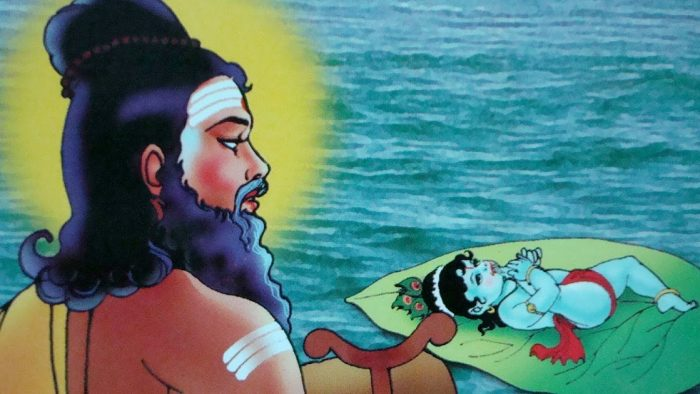
According to the Mantra Pushpam of the Taittriya Aranyaka, it is water that sustains everything in the universe.
With Narayana being the dweller of the waters, who else could be the God of Rain?
With Narayana being the dweller of the waters, who else could be the God of Rain?

But that's not all!
Since it's Krishna that Andal is worshipping, let's look at what happened between Krishna and Indra!
Indra, the Lord of thunder and lighting (and why Rainbow is called Indradhanush), in a fit of rage, orders all clouds to drown Gokula village in a deluge!
Since it's Krishna that Andal is worshipping, let's look at what happened between Krishna and Indra!
Indra, the Lord of thunder and lighting (and why Rainbow is called Indradhanush), in a fit of rage, orders all clouds to drown Gokula village in a deluge!

What starts as a trickle slowly builds up, the sky is dark with clouds, the residents of Gokula tremble in fear and appear downcast.
But...
Why fear when Krishna's here?
But...
Why fear when Krishna's here?

Krishna gathers the villagers at the Govardhana hill.
Men, women, children, cows, goats, are all gathered.
The rain continues unabated.
"Krishna! We're all here! What now?"
In a flash, Krishna picks up the Govardhana hill in his little finger and holds it above them all!
Men, women, children, cows, goats, are all gathered.
The rain continues unabated.
"Krishna! We're all here! What now?"
In a flash, Krishna picks up the Govardhana hill in his little finger and holds it above them all!

Indra arrives proudly on his elephant, hoping to see the village drowned in the deluge and the villagers begging for his mercy.
But, he sees Krishna holding Govardhana and is shocked!
His best efforts have gone in vain.
Krishna has protected the village.
But, he sees Krishna holding Govardhana and is shocked!
His best efforts have gone in vain.
Krishna has protected the village.

Here's the stunning sculpture from the Halebidu Hoysalesvara temple capturing the Govardhanadhari!
The panel behind the sculpture of Govardhanadhari has Indra arriving on his elephant Airavata (Pic 2)

The panel behind the sculpture of Govardhanadhari has Indra arriving on his elephant Airavata (Pic 2)


So, after defeating Indra, it's Krishna who is the Lord of Rain.
Andal addresses him directly and asks him to bless the lands with rain in the 4th pasuram.
Let's look at the text now!
Andal addresses him directly and asks him to bless the lands with rain in the 4th pasuram.
Let's look at the text now!

Andal tells Narayana not just to bring rain, but also how to make that rain!
She says, "Dive into the sea and take your fill of water"
What happens when you're filled with water?
Andal tells us!
She says, "Dive into the sea and take your fill of water"
What happens when you're filled with water?
Andal tells us!

"After taking your fill of water", Andal says, "Rise to the sky with your form as dark as the harbinger of the rain of the deluge"
So, she exhorts Krishna to become the gargantuan dark cloud of the deluge.
But, wouldn't that drown the world? We'll answer that in a bit.
So, she exhorts Krishna to become the gargantuan dark cloud of the deluge.
But, wouldn't that drown the world? We'll answer that in a bit.

And what happens when the cloud rises to the sky?
Andal talks about the Chakra (discus) and Shanka (conch) that Padmanabha holds, like in this majestic @Navachola bronze.
What does Andal say?
Andal talks about the Chakra (discus) and Shanka (conch) that Padmanabha holds, like in this majestic @Navachola bronze.
What does Andal say?

She says that the rain cloud should shine bright with lightning like the Sudarsana chakra and boom with thunder like the Panchajanya Shanka that Padmanabha holds. 

But of what use is mere lightning and thunder?
Andal now wants the giant, dark cloud to pour out rain. And how should it?
The rain should pour like how countless arrows are fired from Vishnu's bow Saranga.
Like this!
Andal now wants the giant, dark cloud to pour out rain. And how should it?
The rain should pour like how countless arrows are fired from Vishnu's bow Saranga.
Like this!

Look closely, the Sudarsana chakra is spinning with the thundering sound of the Panchajanya conch.
But more importantly, look at the quiver of arrows on Narayana's back.
The arrows are streaks of rain!
Salute, @keshav61!
But more importantly, look at the quiver of arrows on Narayana's back.
The arrows are streaks of rain!
Salute, @keshav61!

But, like we asked before, will such rain not drown the entire world?
Andal already makes sure that it won't happen!
She says, "Rain down, so that we may live" (and not drown), "and bathe during the month of Margazhi!"
Andal already makes sure that it won't happen!
She says, "Rain down, so that we may live" (and not drown), "and bathe during the month of Margazhi!"

So, within the 8 verses of the Pasuram, Andal describes the water cycle (originating from the ocean, rising up and falling as rain).
And also uses the weapons Vishnu holds as metaphors for lightning (Sudarsana), thunder(Panchajanya)and rain (arrows of Saranga bow)
And also uses the weapons Vishnu holds as metaphors for lightning (Sudarsana), thunder(Panchajanya)and rain (arrows of Saranga bow)

Before I conclude, allow me to take a slight detour and speak about this stunning sculpture from the DEogarh Dashavatar temple.
Vishnu as Padmanabha is in Yoga Nidra.
But look at the characters in the panel below.
Vishnu as Padmanabha is in Yoga Nidra.
But look at the characters in the panel below.
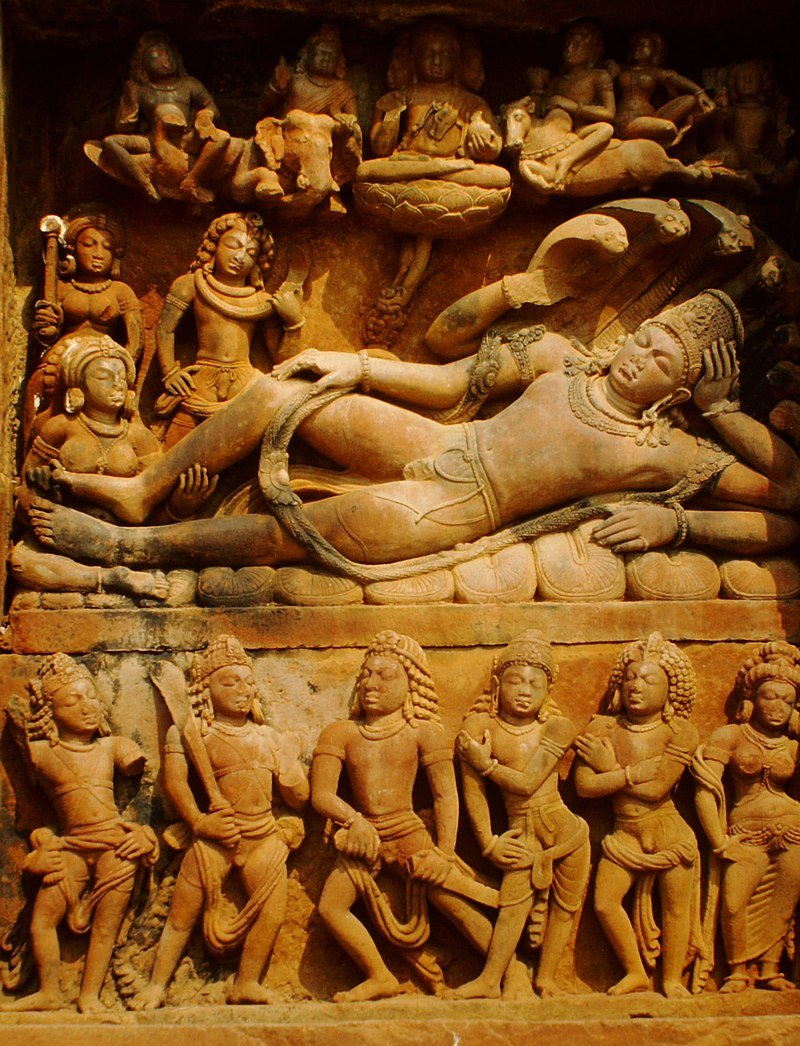
From the left, Madhu and Kaitabha are coming to attack.
But not too fast! They are challenged by the 4 on the right side.
Who are these 4?
But not too fast! They are challenged by the 4 on the right side.
Who are these 4?

Note the character 3rd from the left,
With an aggressive, fiery posture, and hand poised to pull out the sword is Nandaka, the sword of Vishnu.
With an aggressive, fiery posture, and hand poised to pull out the sword is Nandaka, the sword of Vishnu.

Moving right from Nandaka, we have the next character. Notice the slightly odd angle of his arms.
Right arm-straight ending with the palm curved like a bow.
Left arm-just below the right shoulder like it's about to pull an arrow back with bowstring.
Saranga,Vishnu's bow!
Right arm-straight ending with the palm curved like a bow.
Left arm-just below the right shoulder like it's about to pull an arrow back with bowstring.
Saranga,Vishnu's bow!

Next to Saranga, you have the figure standing with his arms folded.
Not much of an attack posture, you think?
Think again.
This is Sudarsana, the chakra of Vishnu (hence the folded hands).
Look how the intelligent sculptor has done the hair like a discus!
Not much of an attack posture, you think?
Think again.
This is Sudarsana, the chakra of Vishnu (hence the folded hands).
Look how the intelligent sculptor has done the hair like a discus!

Next to Sudarsana, you have a lady, standing in a posture as if daring Madhu and Kaitabha to attack.
Based on the previous sculpture, I'm sure you already checked her hairstyle. It's unique and interesting.
But what does the bun on her hair represent?
Based on the previous sculpture, I'm sure you already checked her hairstyle. It's unique and interesting.
But what does the bun on her hair represent?

She is Kaumodaki, the mace of Vishnu.
Look at this mace and Kaumodaki's hairstyle!
But why is a mace called Kaumodaki, you wonder?

Look at this mace and Kaumodaki's hairstyle!
But why is a mace called Kaumodaki, you wonder?


One can only wonder wistfully at how grand he Dashavatar temple may have stood in its days of glory!
Thanks for reading thus far!
We will continue with the 5th Pasuram tomorrow!
Thanks for reading thus far!
We will continue with the 5th Pasuram tomorrow!
Starting with the 5th Pasuram!
Andal begins by addressing Krishna as Maayan - the Lord of Maya!
While some have interpreted it as coming from Vishnu being worshipped as Maayon in Tamil land, there's another explanation.
What is that?
Andal begins by addressing Krishna as Maayan - the Lord of Maya!
While some have interpreted it as coming from Vishnu being worshipped as Maayon in Tamil land, there's another explanation.
What is that?

Svetasvatara Upanishad 4:10, talks about the whole world being Maya and Mahesvara being Mayin, the Lord of Maya.
It is that Maayan that Andal talks about in the 5th Pasuram.
Who is this Maayan?
He is the son of the land of Mathura in the north!
It is that Maayan that Andal talks about in the 5th Pasuram.
Who is this Maayan?
He is the son of the land of Mathura in the north!

There's yet another background to our Maayon.
After all, his is the birth that happens in prison, after his parents Devaki and Vasudeva are imprisoned by his uncle Kansa.
After all, his is the birth that happens in prison, after his parents Devaki and Vasudeva are imprisoned by his uncle Kansa.
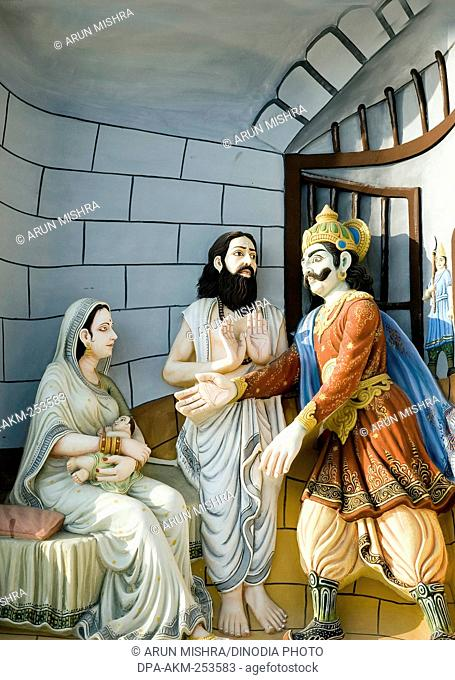
At the anointed time of the 8th night (Ashtami) of dark fortnight (Krishna Paksha) of Sravana/Bhadrapada month, Krishna, the light of the world, drives away the darkness of the prison. 

But Kansa wants to kill the child as he has killed all the children born before. So, Krishna is carried across the flooded Yamuna by his father Vasudeva.
Krishna will now be the child of his friend Nandagopa of Gokula.
Krishna will now be the child of his friend Nandagopa of Gokula.
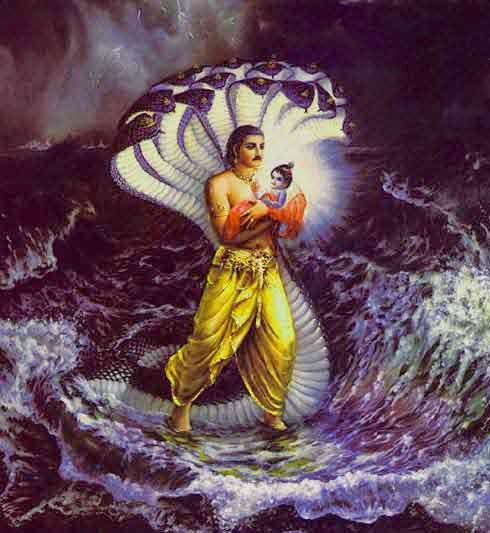
But, Kansa will know the next day that a child was born!
So, Vasudeva brings the newborn child of Nandagopa with him to prison!
Only thing is, this is no ordinary child! She is Yoga Maya Herself!
So, Vasudeva brings the newborn child of Nandagopa with him to prison!
Only thing is, this is no ordinary child! She is Yoga Maya Herself!

And as Kansa attempts to kill her, the child rises up in the sky and in a burst of flash, appears as Yoga Maya.
"Kansa!" she thunders, "Your reign of evil is over! The one to end you has already been born!"
"Kansa!" she thunders, "Your reign of evil is over! The one to end you has already been born!"

And thus, Andal addresses Krishna as Maayon, the son of Mathura!
Oh, what does our Maayan do in Mathura?
He is the master of the banks of the sacred and abundant waters of the Yamuna river!
Oh, what does our Maayan do in Mathura?
He is the master of the banks of the sacred and abundant waters of the Yamuna river!

Apologies for disappearing!
Continuing with the 5th Pasuram!
Krishna is the master of the banks of the sacred and mighty Yamuna river!
The river that's also known as Kalindi because of its dark waters.
Continuing with the 5th Pasuram!
Krishna is the master of the banks of the sacred and mighty Yamuna river!
The river that's also known as Kalindi because of its dark waters.

Krishna is the shining gem, the lamp of the Ayarkulam, the clan of Yadavas.
He is also the one who sanctified his mother's womb!
Look below Krishna's right hand in this painting to see Devaki's shackles being broken by Krishna!
He is also the one who sanctified his mother's womb!
Look below Krishna's right hand in this painting to see Devaki's shackles being broken by Krishna!

Andal then calls Krishna by the epithet Damodara.
Why so?
Why should Krishna be called the one bound by a rope around his stomach?
Why so?
Why should Krishna be called the one bound by a rope around his stomach?

Here, Andal shifts the focus from Devaki, Krishna's mother, to Yashoda, also Krishna's mother!
How can a mother raise the Lord of the Universe? How will she handle his mischievous Leela?
By tying him up from time to time!
How can a mother raise the Lord of the Universe? How will she handle his mischievous Leela?
By tying him up from time to time!

How can a simple rope tie the Jagannatha, the Lord of the Universe?
Yashoda tries and tries again, but it always falls short by an inch or two!
She's at a complete loss!
Yashoda tries and tries again, but it always falls short by an inch or two!
She's at a complete loss!

Seeing her fatigued by the ordeal, Krishna eventually lets her tie him.
After all, who can tie the Lord except by the strands of Bhakti!
Yashoda ties Jagannatha to a mortar.
The mortar is called உரல் (Ural) in Tamil.
What is it called in your language?
After all, who can tie the Lord except by the strands of Bhakti!
Yashoda ties Jagannatha to a mortar.
The mortar is called உரல் (Ural) in Tamil.
What is it called in your language?

He may have been tied to a mortar by Yashoda's love.
But is that going to stop our Krishna?
Nope.
He decides to go for a jaunt, taking the mortar with him.
But is that going to stop our Krishna?
Nope.
He decides to go for a jaunt, taking the mortar with him.

After all managing the universe is no simple task.
So, Krishna goes about his way, dragging the mortar behind him.
But, the road isn't always clear, even for Jagannatha!
There are 2 giant Arjuna trees in garden.
Will that stop him?
So, Krishna goes about his way, dragging the mortar behind him.
But, the road isn't always clear, even for Jagannatha!
There are 2 giant Arjuna trees in garden.
Will that stop him?
Krishna walks right in between the Arjuna trees.
But the mortar can't pass through. It is stuck like a wedge between the trees.
Krishna tries to keep walking. The mortar refuses to budge.
He turns and looks back at the mortar and up at the trees.
But the mortar can't pass through. It is stuck like a wedge between the trees.
Krishna tries to keep walking. The mortar refuses to budge.
He turns and looks back at the mortar and up at the trees.
A mischievous smile plays on Krishna's lips.
With one pull of his arm, the mortar is released!
But wait, what's that sound?
Is it thundering in the sky?
No. The Arjuna trees have come off their roots.
From them, emerge two beings of shining light!
With one pull of his arm, the mortar is released!
But wait, what's that sound?
Is it thundering in the sky?
No. The Arjuna trees have come off their roots.
From them, emerge two beings of shining light!

Let me introduce you to Nalakuvera and Manigriva, the sons of Kubera.
On a different occasion, they had been cursed by Narada (another story for another time, but check painting by @keshav61 ) and stood as trees.
Damodara delivered them from their curse.
On a different occasion, they had been cursed by Narada (another story for another time, but check painting by @keshav61 ) and stood as trees.
Damodara delivered them from their curse.

Andal is perhaps alluding to this story and contrasting the sins of Nalakuvera and Manigriva, with the vrata she has been observing.
She mentions what she has been doing.
Coming after a bath, we worship you with fresh flowers.
She mentions what she has been doing.
Coming after a bath, we worship you with fresh flowers.

Andal says that she and her friends sing and observe the vrata in the hope that unlike Nalakuvera and Manigriva, their mistakes from the past(Prarabdha Karma) as well as in the future (Agami Karma), will burn to ashes. 

With such fervent prayers, can Anugraha be far behind?
Krishna, the son of Mathura, the guardian of the banks of Yamuna, the bright gem of cattle-herders, the one tied by a rope, the Damodara will definitely bless Andal.
Krishna, the son of Mathura, the guardian of the banks of Yamuna, the bright gem of cattle-herders, the one tied by a rope, the Damodara will definitely bless Andal.

We come to the end of the 5th Pasuram.
Hope to see you with the 6th Pasuram tomorrow!
Thank you for reading.
Hope to see you with the 6th Pasuram tomorrow!
Thank you for reading.
Will get to the 6th Pasuram later in the day.
Since it was #ArudraDarisanam yesterday, sharing a thread I wrote last year on the Ganga Avataranam pose (Descent of Ganga)
Since it was #ArudraDarisanam yesterday, sharing a thread I wrote last year on the Ganga Avataranam pose (Descent of Ganga)
https://twitter.com/jeysundhar_d/status/1344313200653651969
Starting with 6th Pasuram.
Andal has spent the last 5 days telling her friends about the glory of Krishna & Pavai Nombu vrata.
On the morning of the 6th, the sun has barely risen. But Andal is up early.
How can she sleep?!
She begins to wake her friends.
So much is happening!
Andal has spent the last 5 days telling her friends about the glory of Krishna & Pavai Nombu vrata.
On the morning of the 6th, the sun has barely risen. But Andal is up early.
How can she sleep?!
She begins to wake her friends.
So much is happening!

And what is happening?
The birds are up and about (perhaps they too observe a vrata dedicated to their Lord, Garuda?)
The conch of the temple of Garuda is blowing loud.
"Don't you hear all this?", asks Andal
Pic - Garuda from the Srirangam Ranganathaswami temple
The birds are up and about (perhaps they too observe a vrata dedicated to their Lord, Garuda?)
The conch of the temple of Garuda is blowing loud.
"Don't you hear all this?", asks Andal
Pic - Garuda from the Srirangam Ranganathaswami temple

"How could you be sleeping, oh little girl? Get up" says Andal
And why should the little girl not sleep in?
Andal explains in the next verse.
And why should the little girl not sleep in?
Andal explains in the next verse.

The one who drank the poisonous milk of Puthana,
the one who kicked and destroyed the demon disguised as a Sakata cart
The one who is the seed of the universe,
is reclining in Yoga Nidra on the Sesha snake in the ocean of milk.
the one who kicked and destroyed the demon disguised as a Sakata cart
The one who is the seed of the universe,
is reclining in Yoga Nidra on the Sesha snake in the ocean of milk.

We saw yesterday how Kansa wanted to kill Krishna and how he was safe in Gokula.
But not all that safe! Kansa is relentless. He sends killer after killer to finish off the child born to finish him off!
Enter Puthana, disguised as a motherly maiden!
But not all that safe! Kansa is relentless. He sends killer after killer to finish off the child born to finish him off!
Enter Puthana, disguised as a motherly maiden!

It takes only a moment for Puthana to realise that she is holding the Lord of the Universe in her hands.
Death finds its way to her soon!
Death finds its way to her soon!

Kansa is undeterred!
He sends his friend Sakatasura disguised as a cart.
It's a bright, sunny day.
Yashoda is out and about carrying Krishna. Nandagopa calls her.
She hands Krishna to a young gopi there and rushes to Nanda.
He sends his friend Sakatasura disguised as a cart.
It's a bright, sunny day.
Yashoda is out and about carrying Krishna. Nandagopa calls her.
She hands Krishna to a young gopi there and rushes to Nanda.
The girl is unable to hold Krishna for long. Plus it's her turn at hopscotch.
She places him in the shade under the cart and goes to play.
This is the moment that Sakatasura has been waiting for.
She places him in the shade under the cart and goes to play.
This is the moment that Sakatasura has been waiting for.

With that, Sakatasura comes to an end.
Andal highlights that it is only after ending Puthana and Sakatasura that Krishna reclines on Seshanaga on the Ksheera saagara (Ocean of milk).
Andal highlights that it is only after ending Puthana and Sakatasura that Krishna reclines on Seshanaga on the Ksheera saagara (Ocean of milk).

Andal says that the Munis and Yogis get up slowly and hail the Lord.
The name "Hari" thunders across the universe.
Andal asks her friend to wake up to let the glory of his name bless her heart.
The name "Hari" thunders across the universe.
Andal asks her friend to wake up to let the glory of his name bless her heart.

With that we come to the end of the 6th Pasuram.
Thank you for reading!
Thank you for reading!
Andal began the 6th Pasuram by telling her friend that birds have started making noise
She begins the 7th by describing that noise.
"Keesu, keesu" say the Aanaichaathan birds amongst themselves.
Aanachaathan-generally identified with Greater Coucal (@Ethirajans may clarify?)
She begins the 7th by describing that noise.
"Keesu, keesu" say the Aanaichaathan birds amongst themselves.
Aanachaathan-generally identified with Greater Coucal (@Ethirajans may clarify?)

Andal chides her friend, you ignorant girl (Pei Penne).
Even the birds have woken up to chant Krishna's name (More on this in a bit), but look at you!
Even the birds have woken up to chant Krishna's name (More on this in a bit), but look at you!

Don't you hear the jingling rhythm of ornaments worn by the women of Gokula as they churn curd?
Don't you smell the fragrance from their dark hairs as they move keeping rhythm with their shoulders?
Don't you smell the fragrance from their dark hairs as they move keeping rhythm with their shoulders?

After seeing that the chiding doesn't work, Andal changes tactics.
She tries to encourage her friend.
"Leader among girls! Tejaswini" she says, "How can you sleep when everyone around you is singing Krishna's name?!"
She tries to encourage her friend.
"Leader among girls! Tejaswini" she says, "How can you sleep when everyone around you is singing Krishna's name?!"
And here, Andal uses the epithet Kesava for Narayana.
(as she had used the epithet Damodara in the 5th Pasuram)
What does Kesava mean?
More like, what all does Kesava mean?!
Let's look at it!
(as she had used the epithet Damodara in the 5th Pasuram)
What does Kesava mean?
More like, what all does Kesava mean?!
Let's look at it!
Since Andal is singing about Krishna, let's look at why Krishna is called Kesava.
Remember how Kansa relentlessly sends various demons to slay Krishna?
One such demon is Kesi, taking the form of a powerful horse!
Remember how Kansa relentlessly sends various demons to slay Krishna?
One such demon is Kesi, taking the form of a powerful horse!

Kesi's racing hooves scatter the soil of Gokula to the corners of the earth.
His intake of air creates a vacuum suffocating all in his wake.
His neighs shake the pillars of Indra's city Amaravati.
All this until he comes face to face with Krishna!
His intake of air creates a vacuum suffocating all in his wake.
His neighs shake the pillars of Indra's city Amaravati.
All this until he comes face to face with Krishna!

Before Kesi realises what's happening, Krishna subdues the demon, bringing him to his knees.
But it's not over. Not yet!
But it's not over. Not yet!

Undeterred Kesi attacks again.
This time, Krishna thrusts his elbow into Kesi's mouth, breaking his teeth and ripping apart his torso.
Pic: Krishna slaying Kesi (Gupta Era) - Metropolitan Museum of Art
Look at Krishna's confidence and the horror in Kesi's eyes!
This time, Krishna thrusts his elbow into Kesi's mouth, breaking his teeth and ripping apart his torso.
Pic: Krishna slaying Kesi (Gupta Era) - Metropolitan Museum of Art
Look at Krishna's confidence and the horror in Kesi's eyes!

Ok, so Krishna is Keshava because he slayed Kesi.
What does the Mahabharata say?
In the Shanti Parva (Mbh 12.328.43), Bhagavan says that the rays emanating from Him are Kesas and so, He is called Kesava!
What does the Mahabharata say?
In the Shanti Parva (Mbh 12.328.43), Bhagavan says that the rays emanating from Him are Kesas and so, He is called Kesava!

There is another equally interesting etymology for the epithet Kesava.
In Harivamsa (that has come to us as an annex of the Mahabharata), Siva says that because Ka(denoting Brahma), and Isa (denoting Siva Himself) originate from Vishnu, Vishnu is called Kesava.
In Harivamsa (that has come to us as an annex of the Mahabharata), Siva says that because Ka(denoting Brahma), and Isa (denoting Siva Himself) originate from Vishnu, Vishnu is called Kesava.

Nammazhvar (another of the 12 Azhvars), attributes Kesava to the beauty of the Lord's hair (kesa).
"I thought I could compare his hair to the darkness of the Pralaya, but even that does not do justice! I'm overwhelmed by the fragrance of his kesa!" he says.
"I thought I could compare his hair to the darkness of the Pralaya, but even that does not do justice! I'm overwhelmed by the fragrance of his kesa!" he says.

Andal makes a comparison between those observing the Paavai Nombu vrata, including
-birds that chant the name of Kesava (who killed Kesi) as best as they can, as "Keesu! Keesu!",
-birds that chant the name of Kesava (who killed Kesi) as best as they can, as "Keesu! Keesu!",

-Gopis churning curd to get butter for Krishna, as we churn our hearts to get Bhakti for Krishnanubhava. 

All through this Pasuram, it is evident that Andal sees Krishna in everything, and everything in Krishna.
Call of Aanaichaathan bird is to her Keesu Keesu, the curd-churning Gopis have hair fragrant like Kesava's, even the churning of curd is a metaphor for her Bhakti.
Call of Aanaichaathan bird is to her Keesu Keesu, the curd-churning Gopis have hair fragrant like Kesava's, even the churning of curd is a metaphor for her Bhakti.

As we had seen in the beginning of the thread, Krishna is both Upaayam (means) and Upeyam (goal) to Andal. 

With such mesmerising metaphors, adorned with alliteration, Andal exhorts her friend to wake up and open the door! 

See you tomorrow with the 8th Pasuram.
Thank you for reading!
Thank you for reading!
Starting with the 8th Pasuram!
In the last 2 Pasurams, Andal has already woken up a few of her friends.
Now, she gets to a particularly obstinate friend's house!
In the last 2 Pasurams, Andal has already woken up a few of her friends.
Now, she gets to a particularly obstinate friend's house!

Andal looks at the sleeping friend and then at the eastern sky.
The sky has already moved from dawn's crimson to the day's white, she says!
In fact, it's so late that even the lazy buffaloes have gone to graze on the dewy grass!
The sky has already moved from dawn's crimson to the day's white, she says!
In fact, it's so late that even the lazy buffaloes have gone to graze on the dewy grass!

"Even worse", says Andal,"all the other girls have also gathered.
In fact, they almost started going to the riverside, but I stopped them saying you'll join us. But you're still asleep".
Talk about peer pressure!
In fact, they almost started going to the riverside, but I stopped them saying you'll join us. But you're still asleep".
Talk about peer pressure!

Andal now appeals to the Gopi's heart.
"Aren't you Krishna's favorite? We're all waiting for you! Come, join us!"
Krishna's favorite? Who's Krishna's favorite?
Let's hear what Krishna says in the Bhagvad Gita.
"Aren't you Krishna's favorite? We're all waiting for you! Come, join us!"
Krishna's favorite? Who's Krishna's favorite?
Let's hear what Krishna says in the Bhagvad Gita.
Krishna tells Arjuna in Bhagvad Gita 7:17 that those who worship Him with knowledge (Jnana) and are steadfastly devoted to Him, they are dear to Him and He is dear to them! 

So, Andal's Gopi is also dear to Krishna.
Why should she get up?
Andal says, if she joins them, they can all sing to the music of the drum (Parai).
What will they sing?
They will sing the glory of the Lord who broke open the horse's mouth!
Remember Kesi from yesterday?
Why should she get up?
Andal says, if she joins them, they can all sing to the music of the drum (Parai).
What will they sing?
They will sing the glory of the Lord who broke open the horse's mouth!
Remember Kesi from yesterday?

Here's a sculpture from the Amrutesvara temple in Karnataka depicting Krishna slaying Kesi.
The temple has a series of sculptures depicting scenes from Krishna's life.
The temple has a series of sculptures depicting scenes from Krishna's life.

Andal goes on to describe the glory of the Lord.
Devadideva, she calls him!
On that note, here's a short rendition of the kriti Devadi Deva Sri Vasudeva of Mysore Vasudevachariar by Dr. Balamuralikrishna.
Devadideva, she calls him!
On that note, here's a short rendition of the kriti Devadi Deva Sri Vasudeva of Mysore Vasudevachariar by Dr. Balamuralikrishna.
Krishna is the Devadi Deva who has slain several wrestlers in battle!
We saw how Kansa sends several demons to kill Krishna and how Krishna defeats them all.
At one point, Krishna decides to take Kansa head on!
With his brother, he reaches Mathura!
We saw how Kansa sends several demons to kill Krishna and how Krishna defeats them all.
At one point, Krishna decides to take Kansa head on!
With his brother, he reaches Mathura!

Kansa has arranged a wrestling ground, with the mightiest wrestlers of the land standing there, rubbing mud over themselves and in their palms, warming up.
As Krishna enters the arena, Kansa gives the order.
"Attack!"
As Krishna enters the arena, Kansa gives the order.
"Attack!"
The mightiest of them, Mushtika, famed for the strength of his arms, lunges at Krishna.
He is no match for Krishna's vigour.
He is no match for Krishna's vigour.

Between the two of them, they dispatch Chanura, the powerful Kuvalayapida and the other wrestlers rapidly.
Pic: Krishna slaying Kesi from Prambanan group of temples in Indonesia.
Pic: Krishna slaying Kesi from Prambanan group of temples in Indonesia.

While we're with Prambanan, another sculpture from the west facing pediment of the northern library in the Banteay Srei temple of Cambodia.
Krishna slays the wrestlers and hops to deal with Kansa.
PC: @MumukshuSavitri
Krishna slays the wrestlers and hops to deal with Kansa.
PC: @MumukshuSavitri

Andal addresses her obstinate friend, "Aren't you Krishna's favorite? Don't you want to go see Him? Won't we all be awed singing the glory of the Devadi Deva? Why don't you join us?"
Look how Andal drags her friend to go meet Krishna!
Look how Andal drags her friend to go meet Krishna!

Or how gently she goes with her to see the God of Gods!
With even the Tamasic buffalo (underwater), turning into the Sattvic cow (above water) aspiring to reach His feet (Paramapada)!
With even the Tamasic buffalo (underwater), turning into the Sattvic cow (above water) aspiring to reach His feet (Paramapada)!
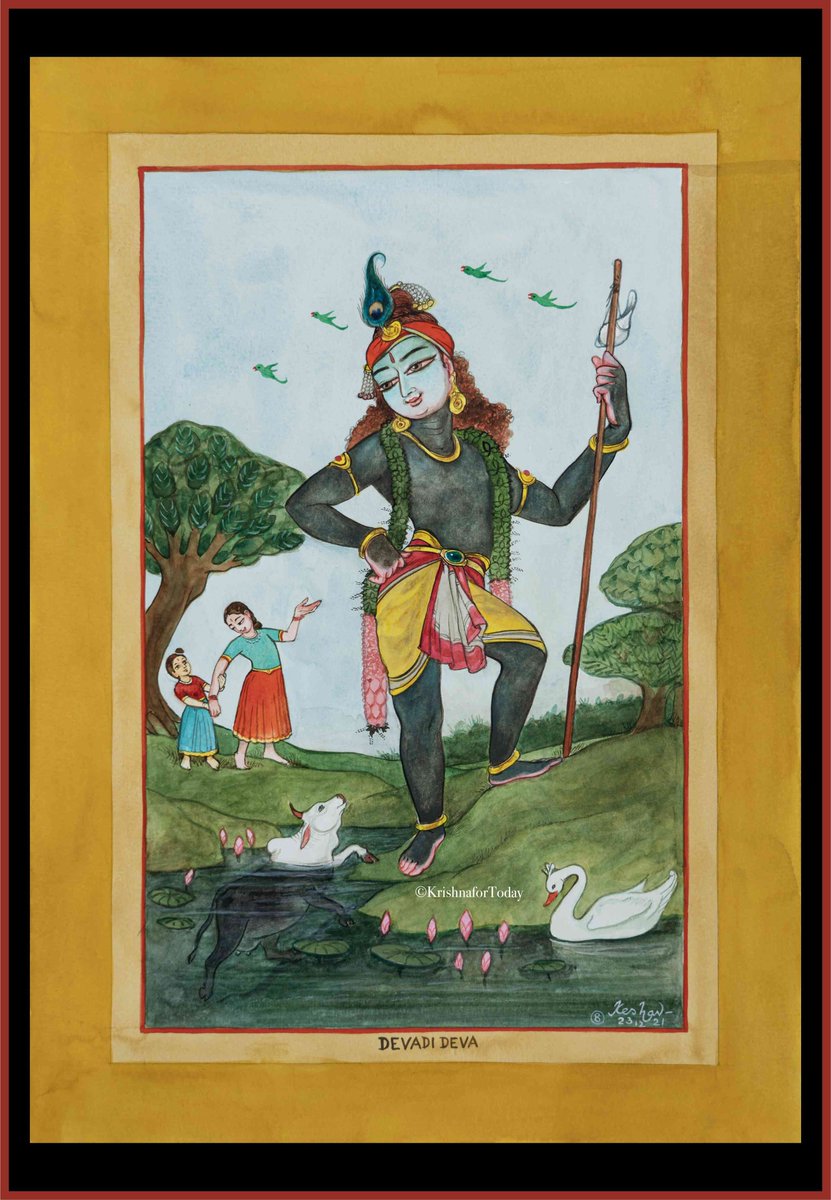
With that we come to the end of the 8th Pasuram!
Thank you for reading!
Thank you for reading!
Shall we look at the 9th Pasuram?
Andal has been going around waking up one of her friends with each Pasuram.
Today, she's outside her uncle's house, trying to wake up his daughter.
Why's her cousin still asleep?
Andal has been going around waking up one of her friends with each Pasuram.
Today, she's outside her uncle's house, trying to wake up his daughter.
Why's her cousin still asleep?
Her cousin is sleeping on the softest of beds.
But that's not all! She's floating in the fragrance of incense.
There are several lamps lit around her, but she's still asleep!
But that's not all! She's floating in the fragrance of incense.
There are several lamps lit around her, but she's still asleep!

Before we proceed, a rather uncommon rendition of the 9th Pasuram of the Thiruppavai by the uber-talented Harisha Sivaramakrishnan and Agam.
Andal pops into her friend's room through the window.
What does she see?
A hall beautifully decorated with gems, reflecting the bright light from the lamps filtered by the smoke from the fragrant incense!
And in the middle of the hall, Andal's uncle's daughter is asleep!
What does she see?
A hall beautifully decorated with gems, reflecting the bright light from the lamps filtered by the smoke from the fragrant incense!
And in the middle of the hall, Andal's uncle's daughter is asleep!
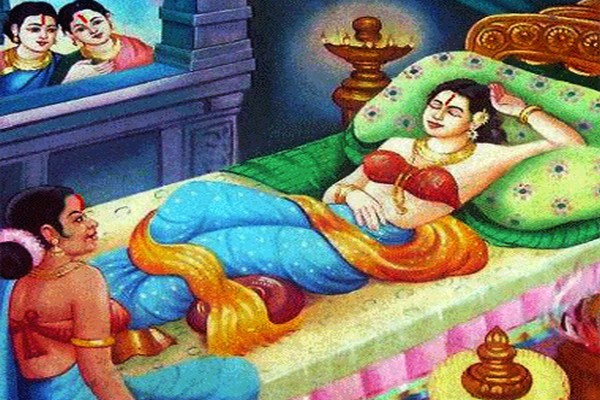
Andal tries waking her friend up herself!
"Open this beautiful, ornamental door!", she says.
She appeals to her Mami.
"Mami! What's wrong with her? Why's she not answering? Is she mute?"
A moment later, she realises that the problem could be different!
"Open this beautiful, ornamental door!", she says.
She appeals to her Mami.
"Mami! What's wrong with her? Why's she not answering? Is she mute?"
A moment later, she realises that the problem could be different!

"Mami! Wake her up! Can't she hear us? Has she become deaf?"
Mami looks at Andal and smiles in serenity.
"Wait! Your daughter is just plain lazy, right? Wake her up!" she urges.
Mami looks at Andal and smiles in serenity.
"Wait! Your daughter is just plain lazy, right? Wake her up!" she urges.

Mami continues to smile.
Andal looks from her Mami to her friend.
"Mami! What happened last night? Did the supreme wizard, the Maha Mayan (The Great Lord of Yoga Maya, Krishna, as we have seen before) come and put her to a trance?"
Andal looks from her Mami to her friend.
"Mami! What happened last night? Did the supreme wizard, the Maha Mayan (The Great Lord of Yoga Maya, Krishna, as we have seen before) come and put her to a trance?"

If it is indeed He who has put her cousin to a trance, then who can wake her up?
Andal invokes Krishna by the name Madhava, the husband of Ma Lakshmi, asking if he has put her cousin in a trance!
This is the first time Lakshmi is referred to in Tiruppavai!
Andal invokes Krishna by the name Madhava, the husband of Ma Lakshmi, asking if he has put her cousin in a trance!
This is the first time Lakshmi is referred to in Tiruppavai!

As the need of the hour is to wake the cousin from the trance, Andal calls Krishna as Vaikunta, the Lord of Vaikuntaloka, where liberated souls travel.
Remember the story of Gajendra, elephant who cried for the Lord as his leg was grabbed by a crocodile?
Pic: Dashavatar temple
Remember the story of Gajendra, elephant who cried for the Lord as his leg was grabbed by a crocodile?
Pic: Dashavatar temple

As soon as He heard Gajendra cry His name, the Lord of Vaikunta came rushing to liberate him from his ordeal and granted him Moksha.
He also came to help Draupadi in the Sabha when she called His name!
Look how the smoke from the incense shows Draupadi and Gajendra Moksha!
He also came to help Draupadi in the Sabha when she called His name!
Look how the smoke from the incense shows Draupadi and Gajendra Moksha!

"Let us worship Him by His names as Krishna, as Madhava, the husband of Lakshmi and as Vaikunta, the Lord of Vaikuntaloka" says Andal.
Krishna (behind Lakshmi), Madhava (sitting with Lakshmi) and Vaikunta above!
Krishna (behind Lakshmi), Madhava (sitting with Lakshmi) and Vaikunta above!

Thus, we come to the end of the 9th Pasuram.
Thank you for reading!
Thank you for reading!
Starting with the 10th Pasuram, a day late.
In this song, Andal speaks to a friend who has always been devoted.
In fact, Andal reminds her about it saying that this friend once performed a vrata to enter the heavens!
In this song, Andal speaks to a friend who has always been devoted.
In fact, Andal reminds her about it saying that this friend once performed a vrata to enter the heavens!

But this friend, perhaps because of the cold Margazhi morning is now sleeping so deep that forget opening the door, she does not respond to Andal calling her from the door. 

Andal describes the beauty of the Lord, hoping that would wake her friend up.
That Narayana, who wears the fragrant Tulasi in his crown and as his garland, that Narayana!
That Narayana, who wears the fragrant Tulasi in his crown and as his garland, that Narayana!

Why is Tulasi so important?
Srimad Bhagavatam says in 3:15:19 that although various flowering plants (List in next tweet) are full of transcendental fragrance, they are still conscious of the austerities performed by Tulasi.
Srimad Bhagavatam says in 3:15:19 that although various flowering plants (List in next tweet) are full of transcendental fragrance, they are still conscious of the austerities performed by Tulasi.

So, flowers like mandāra, kunda, kurabaka, utpala, campaka, arṇa, punnāga, nāgakeśara, bakula, lily and pārijāta give pride of place to Tulasi because of her austerity and Tapasya.
Not just those other flowers!
Not just those other flowers!
Bhagavan himself, as per Bhagavatam, gives special preference to Tulasi and garlands Himself with her leaves. 

The fragrance of Tulasi stirs Bhakti not just in laysouls, but even the Sanakadi Four sages, who are already brahmagnanis, experienced a change both in body and in mind when the fragrance of Tulasi from the feet of the Lord entered their nostrills.
Who are the Sanakadi Four?
Who are the Sanakadi Four?

They're the sages because of whose curse, Vishnu's Dwarapalakas, Jaya and Vijaya were forced to leave Vaikunta and take birth thrice as Asuras
(Hiranyakasipu-Hiranyaksha
Ravana-Kumbhakarna &
Kansa-Sisupala)
- more on that in a separate thread some day!
(Hiranyakasipu-Hiranyaksha
Ravana-Kumbhakarna &
Kansa-Sisupala)
- more on that in a separate thread some day!

In fact, Andal's description of the Lord wearing a crown and garland of Tulasi leaves is a direct echo of Bhagavatam 3:21:20 which is:
Let Your causeless mercy be upon us, for You have appeared before us in Your eternal form, adorned with a splendid wreath of tulasī leaves.
Let Your causeless mercy be upon us, for You have appeared before us in Your eternal form, adorned with a splendid wreath of tulasī leaves.

The Bhagvatam is full of verses that glorify Tulasi as favoured by the Lord!
Let's return to Tiruppavai, where Andal talks about the Lord adorned by Tulasi and is trying to wake her friend up.
All in vain!
Why?
Let's return to Tiruppavai, where Andal talks about the Lord adorned by Tulasi and is trying to wake her friend up.
All in vain!
Why?

Andal wonders if Kumbhakarna who was defeated by that Lord who bestows Moksha on his devotees, gifted his sleep to her friend before dying!
It's the standard taunt our parents and teachers have used every time we dozed off, isn't it?! 😁😁
It's the standard taunt our parents and teachers have used every time we dozed off, isn't it?! 😁😁

Andal goes back to pleading with her friend.
She says, "You that sleeps so sound, you are the rare jewel, why don't you wake up, get ready and come open the door?"
With that we come to the end of the 10th Pasuram.
Since we're a day behind, moving on to the 11th!
She says, "You that sleeps so sound, you are the rare jewel, why don't you wake up, get ready and come open the door?"
With that we come to the end of the 10th Pasuram.
Since we're a day behind, moving on to the 11th!
This time Andal's trying to wake up a really wealthy friend.
How wealthy?
Andal's friend comes from a family where they milk several herds of cows.
Not several cows, mind you, several herds of cows!
Not just that!
How wealthy?
Andal's friend comes from a family where they milk several herds of cows.
Not several cows, mind you, several herds of cows!
Not just that!

Her clansmen don't sit idle.
They go out of their way, and enter the lands of their enemies, fight them, defeat them and make them lose their strength.
After all, they're the clansmen of the one with the sharp spear, Krishna!
They go out of their way, and enter the lands of their enemies, fight them, defeat them and make them lose their strength.
After all, they're the clansmen of the one with the sharp spear, Krishna!

Coming from such an illustrious clan, Andal's friend is flawless, comparable to a slender golden creeper (Swarnalatha, one would have said).
But despite such eminent credentials, what is she doing?
Andal says she's sleeping coiled like a snake in its hole!
But despite such eminent credentials, what is she doing?
Andal says she's sleeping coiled like a snake in its hole!
Andal doesn't stop with the flattery!
She says all her friends have gathered in the yard of this girl's house and are singing the glory of Krishna, who is blue as the cloud!
She says all her friends have gathered in the yard of this girl's house and are singing the glory of Krishna, who is blue as the cloud!

"When we have all gathered here to sing about Krishna, you're lying there, not moving, not talking, just lying there idly!
How could you do this, my dear one?" says Andal.
This "lying there, not moving, not talking" is important because it ties to the earlier reference 2 Tulasi
How could you do this, my dear one?" says Andal.
This "lying there, not moving, not talking" is important because it ties to the earlier reference 2 Tulasi

Bhagavatam 2:3:23 says that the person who has never experienced the aroma of the tulasī leaves from the lotus feet of the Lord is also a dead body, although breathing.
Andal draws upon this by her earlier reference to Tulasi and saying how her friend is lying idle!
Andal draws upon this by her earlier reference to Tulasi and saying how her friend is lying idle!

With that, we come to the end of the 11th Pasuram.
Thank you for reading!
Thank you for reading!
Starting with the 12th Pasuram!
This time Andal finds herself at the doorstep of a rich friend (in Andal's Gokula, everyone's wealthy!)
How rich is this friend?
Andal says the buffalos in the house are shedding so milk that the entire mud floor has become slushy!
Why so?
This time Andal finds herself at the doorstep of a rich friend (in Andal's Gokula, everyone's wealthy!)
How rich is this friend?
Andal says the buffalos in the house are shedding so milk that the entire mud floor has become slushy!
Why so?

Because, the person who was supposed to milk them, the Gopi's brother, is also the Apthamitra, close friend of Krishna.
In fact, it is his shoulder that Krishna always leans on when they stand!
So, he has gone with Krishna, while the buffalos have their udders full!
In fact, it is his shoulder that Krishna always leans on when they stand!
So, he has gone with Krishna, while the buffalos have their udders full!
With such blessed udders, the buffalos think of their calves and just the thought makes them shower milk all over the household!
Andal is standing in the yard made slushy by that flood of milk!
Andal is standing in the yard made slushy by that flood of milk!
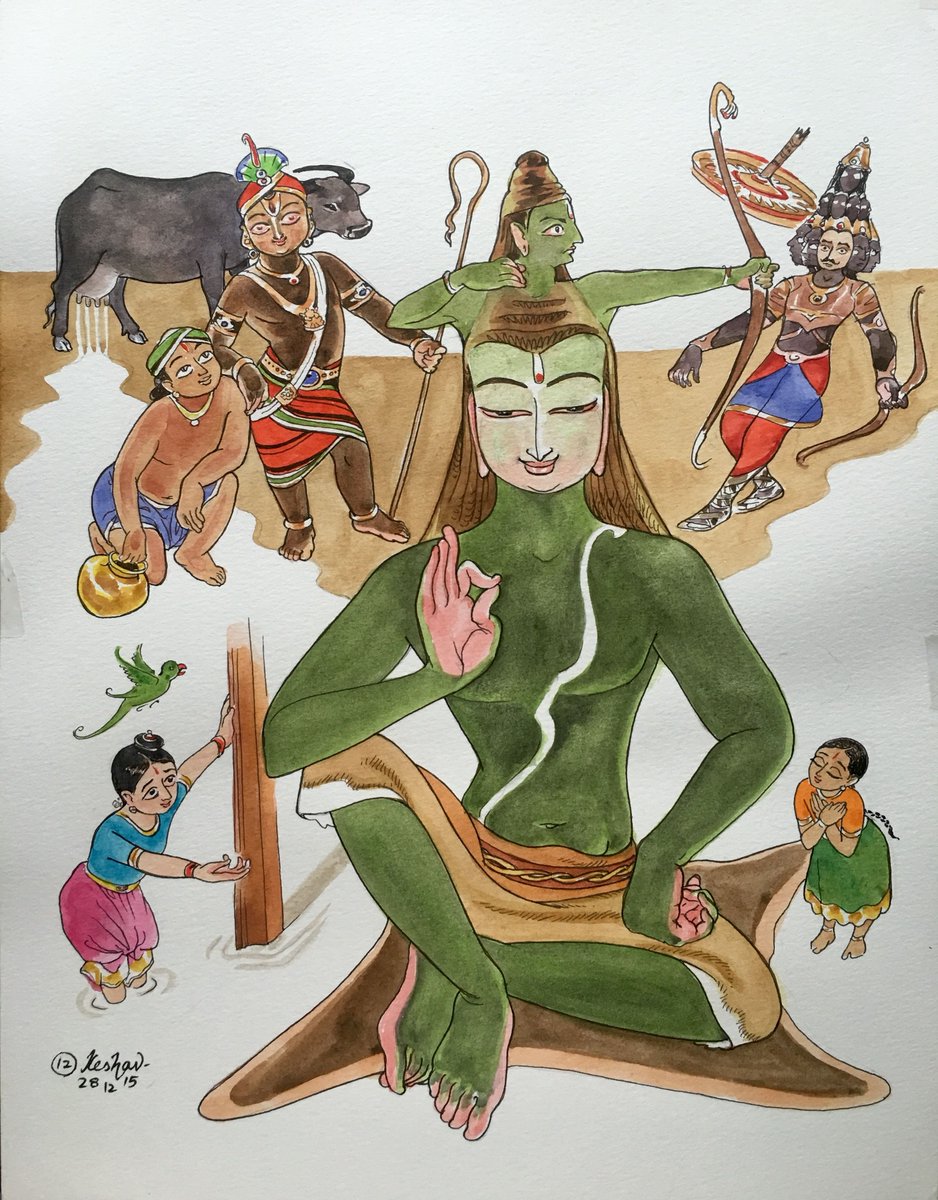
So Andal's feet are stuck in the milky slush.
Her head is being drenched by the snow falling from above!
Altogether, not a comfortable situation.
But, Andal does not mind as she is singing the glory of the Lord!
Her head is being drenched by the snow falling from above!
Altogether, not a comfortable situation.
But, Andal does not mind as she is singing the glory of the Lord!
She stands there with the other Gopis, singing the name of the Lord who defeated the King of Lanka (Ravana).
Andal exhorts her friend to open her mouth, if not to answer their calls, but at least to sing the glory of the Lord who is dearest to their hearts!
Andal exhorts her friend to open her mouth, if not to answer their calls, but at least to sing the glory of the Lord who is dearest to their hearts!

This epithet of dear/sweet to the heart is interesting because it could roughly relate to the epithet of Krishna being Manamohana.
But Krishna being Krishna, is involved in His Leela.
He does not show up when called, but plays hide and seek with the hearts of His devotees.
But Krishna being Krishna, is involved in His Leela.
He does not show up when called, but plays hide and seek with the hearts of His devotees.

It is for this reason that Andal invokes the name of Rama, the one who killed the King of Lanka, out of anger.
What anger?
When Ravana fires a thousand arrows at Rama, Rama calmly counters them with arrows of his own.
What anger?
When Ravana fires a thousand arrows at Rama, Rama calmly counters them with arrows of his own.

But then, out of desperation, Ravana fires arrows at Hanuman, who is carrying Rama on his shoulders (remember the brother of the Gopi, on whose shoulder Krishna leans on?)
It is then that an enraged Rama, kills Ravana!
It is then that an enraged Rama, kills Ravana!

It is because of such affection for His devotees that Andal chooses to invoke Rama as she addresses her friend, asking her to wake up and sing the glory of Rama! 

The sleeping Gopi, the buffalos showering milk in the yard, the bow-wielding Rama with the brother and Andal with them, all captured in this magnificent work of devotion by @keshav61 

Andal concludes the 12th Pasuram by saying the entire neighbourhood is up and aware of their Paavai nombu vrata, except this sleeping Gopi!
Thank you for reading! We'll get to the 13th Pasuram in a bit!
Thank you for reading! We'll get to the 13th Pasuram in a bit!
Starting with the 13th Pasuram!
First she hailed Krishna.
In the last Pasuram, she hailed Rama.
In this Pasuram, she takes the name of both Rama&Krishna in the same verse!
Look at this painting!
Rama on the right, Krishna on the left!
What are they doing?
Andal tells us!
First she hailed Krishna.
In the last Pasuram, she hailed Rama.
In this Pasuram, she takes the name of both Rama&Krishna in the same verse!
Look at this painting!
Rama on the right, Krishna on the left!
What are they doing?
Andal tells us!
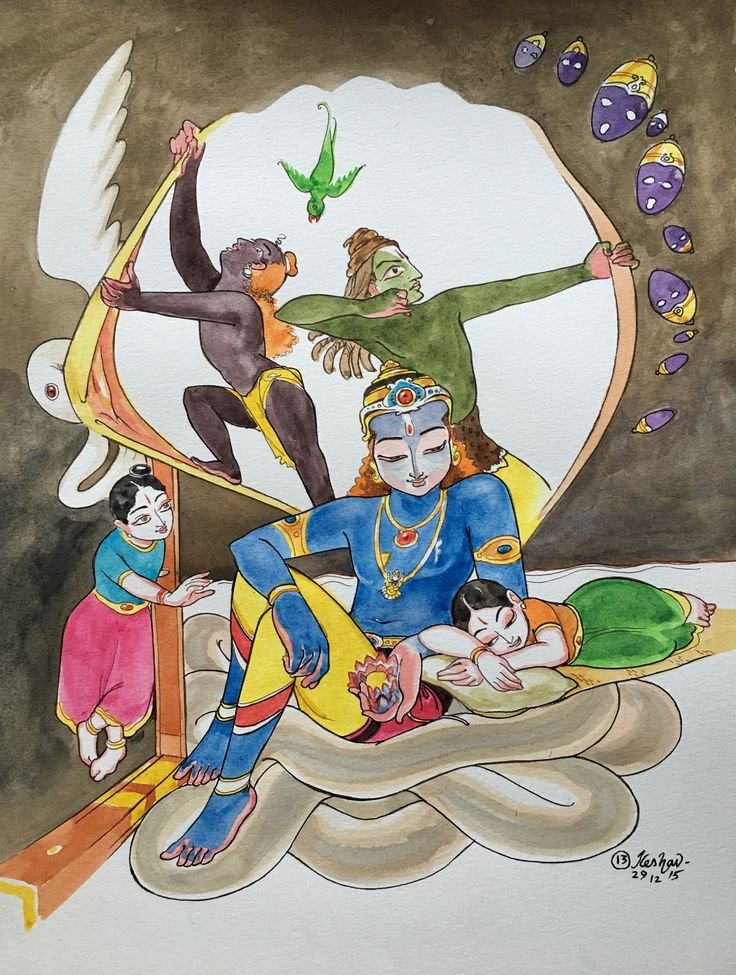
The dream bubble of the sleeping Gopi is held up by Rama's bow on the right.
Andal says, Rama is the one who eliminated the cruel
Asuran, with a mere pinch of His nails.
Pinch of His nails?
Let's look at what the Desika Prabandha of Swami Desikan says!
Andal says, Rama is the one who eliminated the cruel
Asuran, with a mere pinch of His nails.
Pinch of His nails?
Let's look at what the Desika Prabandha of Swami Desikan says!

Swami Desikan says that "எழில் தனுவின் உய்த்தகணையால் அத்திர அரக்கர்முடி பத்தும் ஒரு கொத்து என உதிர்த்த திறலோன்"
Rama is the one who, with the raised arrow of His elegant bow shred the ten heads of Ravana as if they were just one bunch!
Look at the 10 falling heads of Ravana!
Rama is the one who, with the raised arrow of His elegant bow shred the ten heads of Ravana as if they were just one bunch!
Look at the 10 falling heads of Ravana!

But what was that bit about pinch of the nail, you ask?
In Valmiki Ramayana Yuddha Kanda 18:22, as Vibhishana seeks refuge in Rama, Sugreeva and the others advise Rama to turn Vibhishana down.
"He is sent by Ravana, the enemy. It may be dangerous!"
In Valmiki Ramayana Yuddha Kanda 18:22, as Vibhishana seeks refuge in Rama, Sugreeva and the others advise Rama to turn Vibhishana down.
"He is sent by Ravana, the enemy. It may be dangerous!"

Rama responds with a smile "Even if the Pishaachas, Daanavas, Yakshas and the Rakshasas of the world gather together, if I wish, I can finish them with just the tip of my finger" 

After all, how can the Purushottama Rama turn down someone seeking refuge?
Remember yesterday's Pasuram, where Rama was enraged by Ravana firing arrows at Hanuman and responded by killing Ravana?
Remember yesterday's Pasuram, where Rama was enraged by Ravana firing arrows at Hanuman and responded by killing Ravana?

So, that's Rama.
What about Krishna?
Look at Sesha's head, which is also the dream bubble.
The left side of the bubble is framed by the mouth of the crane split open by Krishna!
What about Krishna?
Look at Sesha's head, which is also the dream bubble.
The left side of the bubble is framed by the mouth of the crane split open by Krishna!

In his relentless attempts to Krishna, Kansa sends an Asura in the form of a giant crane.
Finding Krishna with his friends, the crane immediately swallows Him!
With his yogagni, Krishna starts burning the innards of the crane.
In pain, the crane spits Krishna out!
Finding Krishna with his friends, the crane immediately swallows Him!
With his yogagni, Krishna starts burning the innards of the crane.
In pain, the crane spits Krishna out!

Hopping out of the crane's mouth, Krishna immediately turns around and splits open the beak of the crane! 
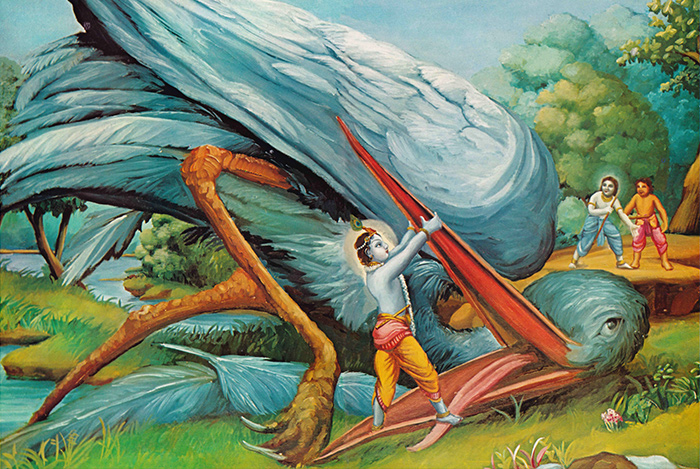
Andal says the Gopis, at least those that have woken up, have been singing songs praising the one (Krishna) who broke open the mouth of the crane and the one (Rama) who killed the cruel Asura.
Some have reached the place of the Pavai nombu vrata as well.
Some have reached the place of the Pavai nombu vrata as well.

But what time is it? Is it so late?
Andal says Venus, the morning star, has already risen in the sky.
Jupiter has gone to sleep (sunk below the horizon).
This is a scenario, where both Venus and Jupiter were visible in the morning sky.
More- moas.org/Conjunction-of…
Andal says Venus, the morning star, has already risen in the sky.
Jupiter has gone to sleep (sunk below the horizon).
This is a scenario, where both Venus and Jupiter were visible in the morning sky.
More- moas.org/Conjunction-of…

This is the 13th Pasuram, which means it was sung by Andal on the Trayodashi(13th Tithi) of the Margazhi month.
Using this and the Venus-Jupiter conjecture data, Mahavidvan Mugavai Raghava Iyengar has stated that Andal's time period was likely to be 885/886CE
Using this and the Venus-Jupiter conjecture data, Mahavidvan Mugavai Raghava Iyengar has stated that Andal's time period was likely to be 885/886CE

Returning to the 13th Pasuram, Andal says the birds have also started singing with the morning sky breaking into light.
When all this is happening, Andal asks her friend how she can be sleeping inside of waking up and bathing in cold water!
When all this is happening, Andal asks her friend how she can be sleeping inside of waking up and bathing in cold water!

"It's a good day! Shed your pretence! Wake up, let's observe the Pavai Nombu vrata"
Thus ends the 13th Pasuram!
Thus ends the 13th Pasuram!

Starting with the 14th Pasuram!
As I've said before, Andal's Pasurams are a GREAT example of the writer's toolkit on "Show, don't tell".
Remember how the abundant richness of the village is brought out through the fields, cows and buffalos!
As I've said before, Andal's Pasurams are a GREAT example of the writer's toolkit on "Show, don't tell".
Remember how the abundant richness of the village is brought out through the fields, cows and buffalos!
Remember how Andal said the buffalos showed enough milk to make the entire yard slushy?
Look @ how Andal shows time of day in the 14th Pasuram!
She says the Senkazhuneer flower that blooms in the morning is opening up, while the Ambal flower that blooms at night is closing!
Look @ how Andal shows time of day in the 14th Pasuram!
She says the Senkazhuneer flower that blooms in the morning is opening up, while the Ambal flower that blooms at night is closing!

All this is happening in the garden pond behind the house of the Gopi she is trying to wake up in the 14th Pasuram!
Still half-asleep, the Gopi says, "No no. It can't be that late. You're mistaken!"
"Oh, it's quite late! Can't you see?"
"I won't open my eyes!"
Still half-asleep, the Gopi says, "No no. It can't be that late. You're mistaken!"
"Oh, it's quite late! Can't you see?"
"I won't open my eyes!"

"It's alright if you won't open your eyes", says Andal, "can't you hear?"
"Hear what?"
"The holy sages clad in their robes red as brick, wearing white tilak on their foreheads, are sounding the conch of the temples as they open"
"Hear what?"
"The holy sages clad in their robes red as brick, wearing white tilak on their foreheads, are sounding the conch of the temples as they open"
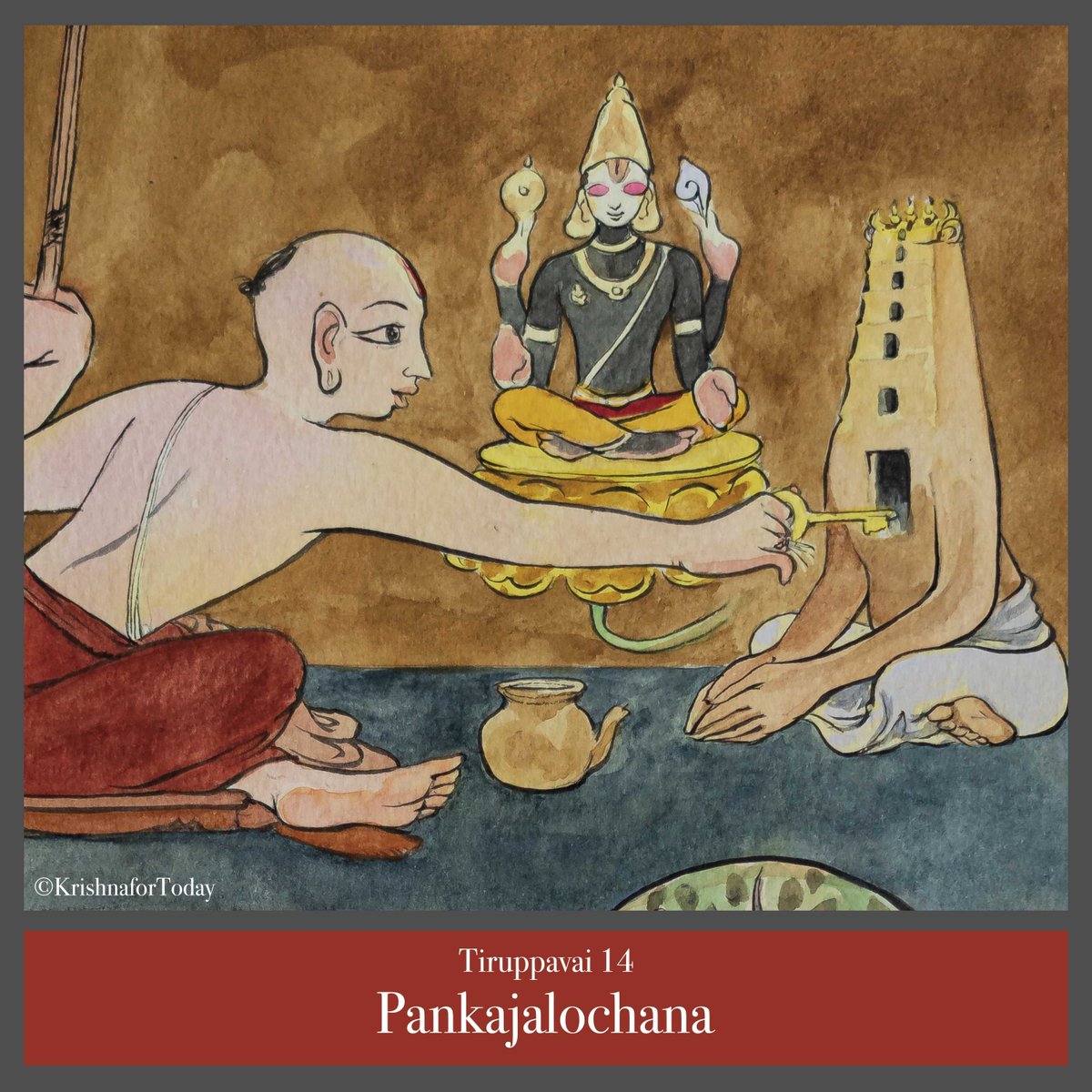
Now, according to Andal, this Gopi is doing something especially ignominious.
She is not joining them, despite having been the one who promised to wake them all up!
She's the alarm clock that has fallen asleep!
Andal asks if she's not ashamed after making such tall claims!
She is not joining them, despite having been the one who promised to wake them all up!
She's the alarm clock that has fallen asleep!
Andal asks if she's not ashamed after making such tall claims!

"Why should I wake up? What's so important?"
"How can you ask that? Come join us!
We'll sing the glory of the one with the great shoulders holding both Shanka and Chakra, He whose eyes are like blooming lotuses!"
"How can you ask that? Come join us!
We'll sing the glory of the one with the great shoulders holding both Shanka and Chakra, He whose eyes are like blooming lotuses!"

Calling the Lord as one with great shoulders is a common epithet.
In the beginning of the Aditya Hridayam from the Valmiki Ramayana, Agastya addresses Rama as Rama Rama Mahabaho, Rama, one with the great shoulders!
Old thread on Aditya Hridayam here:

In the beginning of the Aditya Hridayam from the Valmiki Ramayana, Agastya addresses Rama as Rama Rama Mahabaho, Rama, one with the great shoulders!
Old thread on Aditya Hridayam here:
https://twitter.com/jeysundhar_d/status/1349730589138538496

We have already seen how the Chandogya Upanishad describes the eyes of the Lord as lotuses 
https://twitter.com/jeysundhar_d/status/1471398224267259904

The Vishnu Sahasranama also describes the Lord as Aravindaksha, the one with lotus eyes.
But of course, that's how a bhakta would describe the Lord! As handsome and with Lotus eyes.
With Rama, even those that detest him, like Surpanakha describe his beauty thus!
But of course, that's how a bhakta would describe the Lord! As handsome and with Lotus eyes.
With Rama, even those that detest him, like Surpanakha describe his beauty thus!

In the Aranya Khanda 19:14 of Valmiki Ramayana, Surpanakha is so captivated by Rama that she describes him-"good-looking, gentle yet greatly mighty, eyes broad like lotuses, dressed in jute-cloths and deerskin, subsistent on fruits and tubers, composed, sagacious and celibate" 

With that we come to the end of the 14th Pasuram!
I know that we are behind by a day.
Promise to catch up!
Thank you for reading!
I know that we are behind by a day.
Promise to catch up!
Thank you for reading!
Starting with the 15th Pasuram!
Andal has been gathering the Gopis from the 6th Pasuram.
She is now at the last one's house and also at the end of her patience!
Andal has been gathering the Gopis from the 6th Pasuram.
She is now at the last one's house and also at the end of her patience!
She calls her friend as "Elle!" perhaps a rough equivalent would be a very rash "Heyo!"
But then, she softens up a bit and addresses her friend as the young parrot!
But then, she softens up a bit and addresses her friend as the young parrot!

Andal's friend sitting inside is no less agitated.
"Shhh! It's early in the morning. What's with the ruckus? Speak softly. What's wrong?"
"Shhh! It's early in the morning. What's with the ruckus? Speak softly. What's wrong?"
"It's time to go for the Paavai Nombu Vrata. Come!" says Andal.
"Yes, yes. I'm coming. You guys carry on. I'll catch up!"
"Yes, yes. I'm coming. You guys carry on. I'll catch up!"
Having woken up several of her friends, Andal is now wise to such tricks.
"Haha! I know you have a smart mouth! We know all your excuses. Come out!"
The Gopi goes all passive-aggressive.
"No, no! You all are the smart ones! I'm the one at fault. So, let me be"
Interesting.Why?
"Haha! I know you have a smart mouth! We know all your excuses. Come out!"
The Gopi goes all passive-aggressive.
"No, no! You all are the smart ones! I'm the one at fault. So, let me be"
Interesting.Why?
Because in the Ramayana, after Rama, Lakshmana and Sita have departed to the forest, Dasaratha dies.
Bharata and Shatrughna, at their grandfather's place arrive in Ayodhya.
Bharata tries to find out what happened.
Kaikeyi tells him how she sent Rama away to make Bharata king!
Bharata and Shatrughna, at their grandfather's place arrive in Ayodhya.
Bharata tries to find out what happened.
Kaikeyi tells him how she sent Rama away to make Bharata king!
Engulfed by anger at his mother's actions, Bharata goes on a tirade!
Eventually he calms down and tells Shatrughna that it isn't Kaikeyi's fault.
"Oh! If not hers, then whose fault is it?" asks Shatrughna.
Eventually he calms down and tells Shatrughna that it isn't Kaikeyi's fault.
"Oh! If not hers, then whose fault is it?" asks Shatrughna.

"It is mine, dear Shatrughna. I am the one at fault!" says Bharata.
Shatrughna doesn't understand.
"WHAT? You weren't even here. How could you be at fault?"
"But, I WAS here, Shatrughna. It is because I am here that Rama is not!"
Shatrughna is even more confused.
Shatrughna doesn't understand.
"WHAT? You weren't even here. How could you be at fault?"
"But, I WAS here, Shatrughna. It is because I am here that Rama is not!"
Shatrughna is even more confused.
"Hear me, O Shatrughna, destroyer of foes. If I, Bharata, had never existed, my mother Kaikeyi would have nobody to demand the throne for.
If I had never been born, Rama wouldn't have had to go to forest!
So, it is I who am at fault" says Bharata, the most loyal of brothers.
If I had never been born, Rama wouldn't have had to go to forest!
So, it is I who am at fault" says Bharata, the most loyal of brothers.

It is with that overwhelming sense of guilt that Bharata goes to find Rama.
He begs Rama to return to Ayodhya. Rama refuses.
Upon Bharata's insistence, he hands over his sandals to Bharata.
He begs Rama to return to Ayodhya. Rama refuses.
Upon Bharata's insistence, he hands over his sandals to Bharata.

So Andal uses the same phrase, famously known as Bharata Vakyam, in this Pasuram.
As her friend is reluctant, she says,
"Everyone has gone. What's your problem?"
"Oh, has everyone gone? Did you double-check?"
"Yes, you take my word. Assume that they have all gone!" says Andal
As her friend is reluctant, she says,
"Everyone has gone. What's your problem?"
"Oh, has everyone gone? Did you double-check?"
"Yes, you take my word. Assume that they have all gone!" says Andal
"But why should I come? Why should anyone of us come?"
It is here that Andal, the poet handholds Andal the Bhaktaa.
A nice little piece of wordplay.
"We need to sing the glory of the mighty one who slayed the mighty elephant"
What is the wordplay?
It is here that Andal, the poet handholds Andal the Bhaktaa.
A nice little piece of wordplay.
"We need to sing the glory of the mighty one who slayed the mighty elephant"
What is the wordplay?

At Kansa's tournament, the entrance is blocked by the mighty elephant Kuvalayapida.
We have already seen about Krishna and Kuvalayapida here
We have already seen about Krishna and Kuvalayapida here
https://twitter.com/jeysundhar_d/status/1474023588214849543
The Bhagavatam in 10:48:2 says Kansa stationed the elephant Kuvalayapida at entrance to arena (Rangadwara).
As it attempted to attack, Krishna snuck under it, took it by tail and whirled it round and round before smashing it.
You've heard #HulkSmash? This is Krishna Smash!
As it attempted to attack, Krishna snuck under it, took it by tail and whirled it round and round before smashing it.
You've heard #HulkSmash? This is Krishna Smash!

Ok, so that's the mighty elephant, Val Aanai, as Andal says.
What's the wordplay?
In the next line, she says, let's worship the mighty one, the Vallaan, "Vallaanai, Maayanai" she says.
Remember how mighty Krishna held up the Govardhana hill?
From Hosoholalu, KA
What's the wordplay?
In the next line, she says, let's worship the mighty one, the Vallaan, "Vallaanai, Maayanai" she says.
Remember how mighty Krishna held up the Govardhana hill?
From Hosoholalu, KA

Like we have Suprabhatam for waking up the Bhagavan, these Pasurams 6-15 of Andal are for waking up the Bhagavatas.
The sleeping is of course, a metaphor for the maaya that all beings dwell under and need the voice of a blessed soul like Andal to wake us up!
The sleeping is of course, a metaphor for the maaya that all beings dwell under and need the voice of a blessed soul like Andal to wake us up!

We are the sleeping Gopi, we are the distraught Bharata, we are the mad elephant Kuvalayapida.
With a touch of His fingernail, with a glance of His eyes, with a gentle pat on the back, Bhagavan wakes us up from our slumber.
With a touch of His fingernail, with a glance of His eyes, with a gentle pat on the back, Bhagavan wakes us up from our slumber.

After all, as Bheeshma tells Yudhishtra in the Anushasana Parva of the Mahabharata, His is the name, that releases from the bonds of Janma Samsara. 

With this we come to the end of the 15th Pasuram.
Midway through our Thiruppavai thread, the year comes to an end on the Gregorian calendar.
Margazhi continues.
See you tomorrow!
Thank you for reading!
Midway through our Thiruppavai thread, the year comes to an end on the Gregorian calendar.
Margazhi continues.
See you tomorrow!
Thank you for reading!
Starting with the 16th Pasuram!
Pasurams 1-5 explained the paavai nombu vrata, its rules and ultimate objective.
In Pasurams 6-15, Andal gathered the Gopis by going to their houses and waking them up.
By the end of Pasuram 15, she has gathered all of them!
What next?
Pasurams 1-5 explained the paavai nombu vrata, its rules and ultimate objective.
In Pasurams 6-15, Andal gathered the Gopis by going to their houses and waking them up.
By the end of Pasuram 15, she has gathered all of them!
What next?

Having bathed and purified themselves in thought as well, they are now heading to the house of Krishna (Remember Andal visualises them as Gopis in Gokula).
House of Krishna is also a metaphor for both the Vadapatrasayi temple in Srivilliputhur, as well as...
Vaikunta itself!

House of Krishna is also a metaphor for both the Vadapatrasayi temple in Srivilliputhur, as well as...
Vaikunta itself!


But then, is it so easy to enter the House of the Lord?
Can anyone walk in?
Aren't there gatekeepers and guards?
Of course.
With so many attacks on Krishna from Putana to Kesi, Nandagopa has placed guards all the way to the entrance.
So,Andal has to negotiate her way in!
Can anyone walk in?
Aren't there gatekeepers and guards?
Of course.
With so many attacks on Krishna from Putana to Kesi, Nandagopa has placed guards all the way to the entrance.
So,Andal has to negotiate her way in!
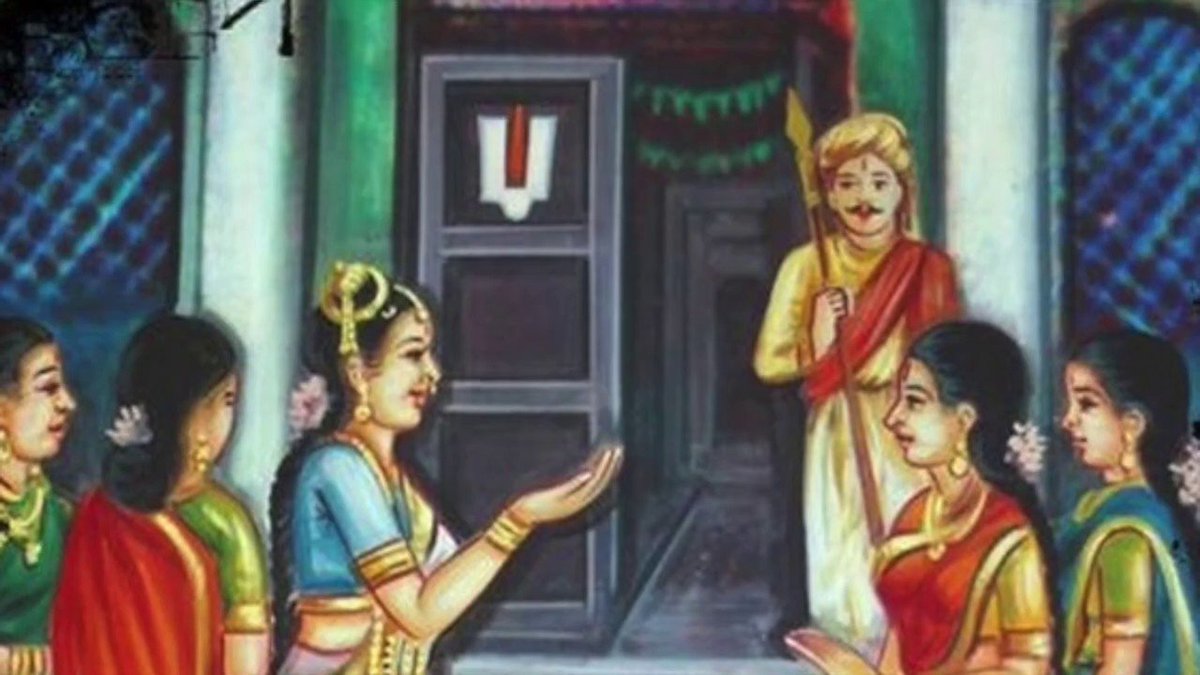
But what if it's Vaikunta? Will she be walking in there?
Oh no!
Remember the Sanakadi Four being stopped by Jaya and Vijaya?
If that's what happens to sons of Brahma, what can a poor girl like Andal do?
Oh no!
Remember the Sanakadi Four being stopped by Jaya and Vijaya?
https://twitter.com/jeysundhar_d/status/1475115582655713280
If that's what happens to sons of Brahma, what can a poor girl like Andal do?
So, we need the guidance and blessing of the Acharya, the Guru, for us to even get near the door of Vaikunta. 

Even Arjuna, having known Krishna to be a friend, bows down to him in the Bhagavad Gita.
In BG 2:7, he says शिष्यस्तेऽहं शाधि मां त्वां प्रपन्नम्
Confused about my duty and faint of heart, I surrender to you as your disciple.
Please instruct me on what is good.
In BG 2:7, he says शिष्यस्तेऽहं शाधि मां त्वां प्रपन्नम्
Confused about my duty and faint of heart, I surrender to you as your disciple.
Please instruct me on what is good.
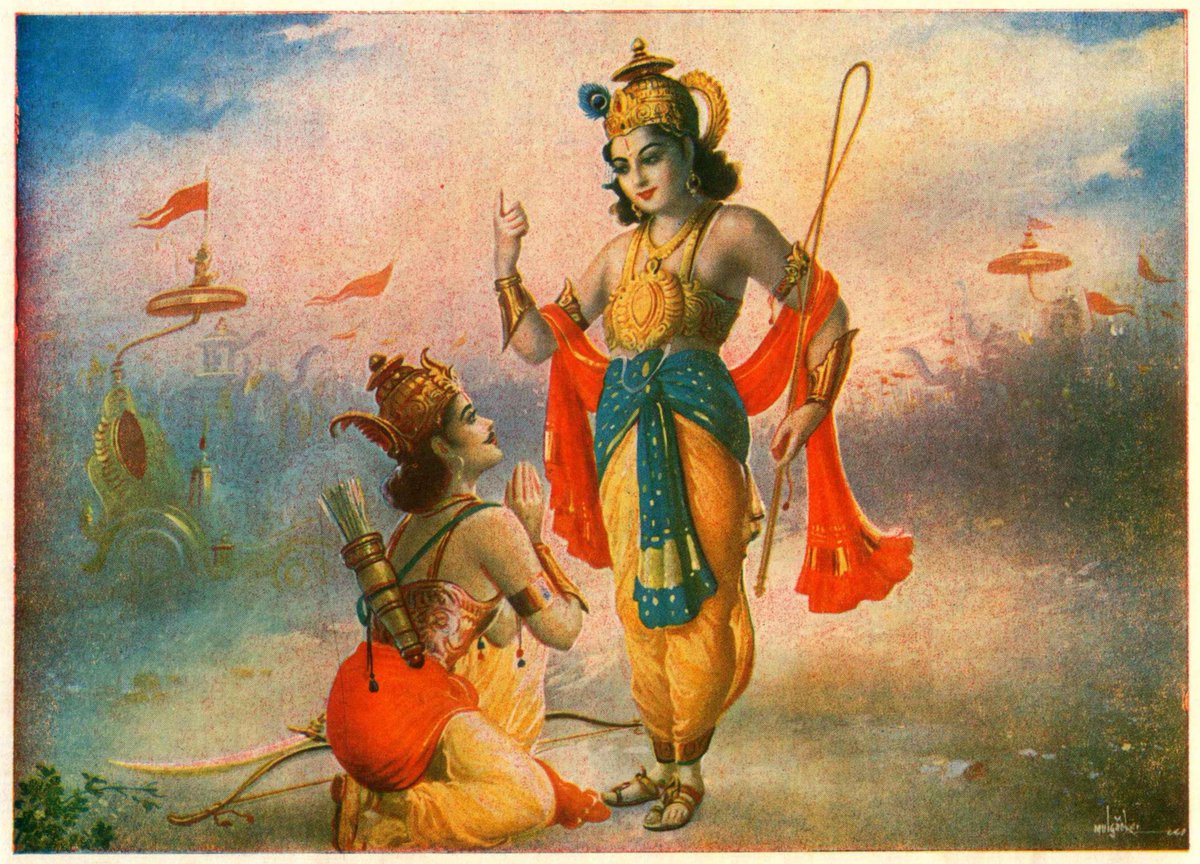
So, Andal in a manner of speaking, visualises herself as Arjuna and tells the gatekeeper (Dwarapalaka) about the time He taught her.
"He is my Guru! Please let me in, so I can meet Him!"
"He is my Guru! Please let me in, so I can meet Him!"
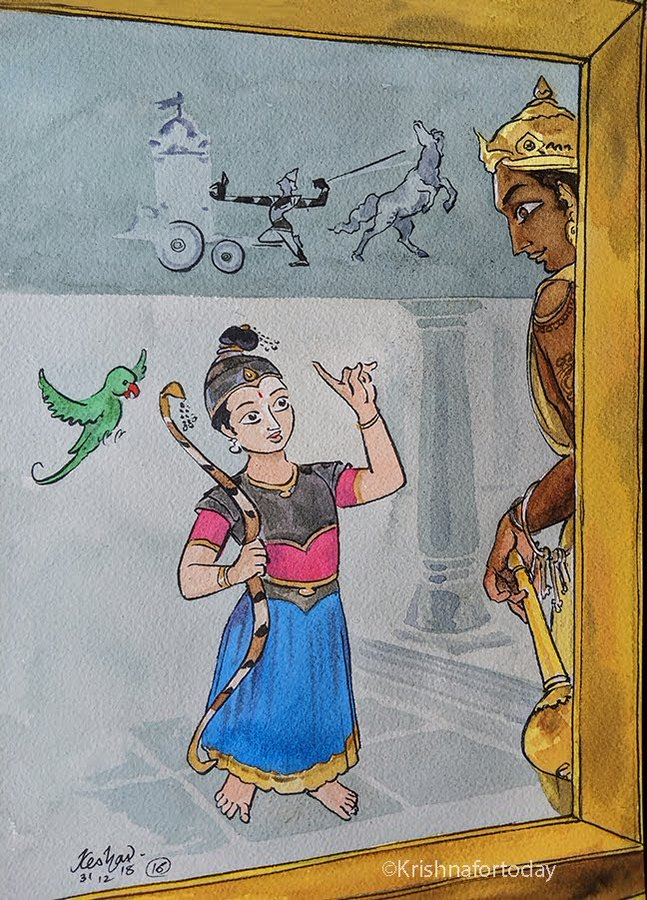
Andal tells the guard "Oh mighty one! Please open the beautiful door decorated with bells! I seek my Acharyan's blessings!"
Remember the sages clad in clothes red as the brick, who went to open temples and blow conches.
Remember the sages clad in clothes red as the brick, who went to open temples and blow conches.

The Dwarapalaka is suspicious.
"Who are you people? You've come so early in the morning and are asking to be let in! How can I do that?"
"Who are you people? You've come so early in the morning and are asking to be let in! How can I do that?"

Andal blinks her big doe-like eyes and says, "Sire! We're but little girls! Look at us! How could we harm Krishna?"
The guard is amused. He bends down to listen to her.
"In fact" she continues, "it is Krishna who came to us yesterday and promised to give us Parai"
The guard is amused. He bends down to listen to her.
"In fact" she continues, "it is Krishna who came to us yesterday and promised to give us Parai"

"Oh he did, did he?" the bemused guard asks Andal, "What does this Krishna look like?"
"He is the enchanter(Maayan), dark as the gem, he is the one who promised us!"
"He is the enchanter(Maayan), dark as the gem, he is the one who promised us!"
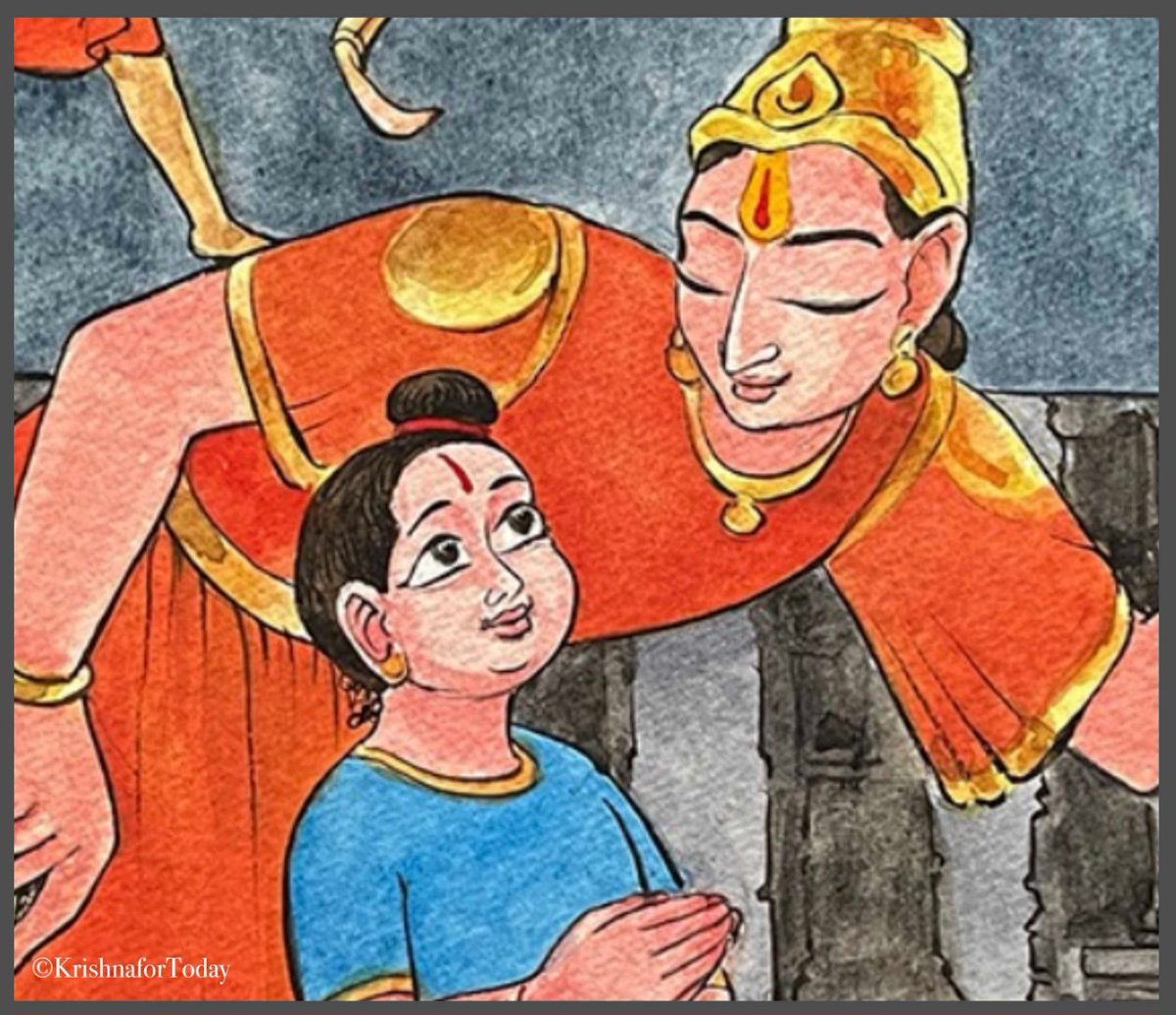
"Because He promised us, we bathed, purified ourselves, and came all the way here"
Andal tries to convince the Dwarapalaka about their piety, and says, "So, please don't turn us down now! Please open the door for us!"
Andal tries to convince the Dwarapalaka about their piety, and says, "So, please don't turn us down now! Please open the door for us!"

Thus we come to the end of the 16th Pasuram.
Thank you for reading!
Thank you for reading!
After convincing the Dwarapalaka in Pasuram 16, Andal now sings the 17th Pasuram as a Suprabhatam, a திருப்பள்ளியெழுச்சி to Krishna.
Only and directly to Krishna?
How could that be?
Only and directly to Krishna?
How could that be?
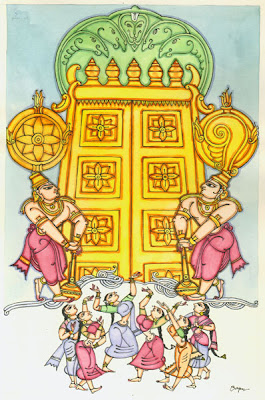
There's a protocol to be followed for everything, right?
Andal stands by the bed where the family is sl
eeping.
There's Nandagopa at the beginning.
Then protected by Yashoda and his elder brother Balarama is Andal's hero, Krishna!
Andal stands by the bed where the family is sl
eeping.
There's Nandagopa at the beginning.
Then protected by Yashoda and his elder brother Balarama is Andal's hero, Krishna!

Andal decides to begin with Nandagopa, Krishna's father.
She already took his name in Pasuram 16, when talking to the gatekeeper.
How does she address him in Pasuram 17?
She already took his name in Pasuram 16, when talking to the gatekeeper.
How does she address him in Pasuram 17?

Andal targets Nanda's generosity of heart.
"Nandagopala! Aren't you the one who donates clothes, water and food to those in need? Wake up!"
After all, Nanda may share his material wealth(பொருட்ச்செல்வம்), but will he share his spiritual wealth(அருட்ச்செல்வம்) i.e. Krishna?
"Nandagopala! Aren't you the one who donates clothes, water and food to those in need? Wake up!"
After all, Nanda may share his material wealth(பொருட்ச்செல்வம்), but will he share his spiritual wealth(அருட்ச்செல்வம்) i.e. Krishna?

What Andal is perhaps implying is that Nanda may be donating that which is needed for survival (water), sustenance(food) and comfort(clothes).
To Gopis, all 3 are found in one form, that of Krishna!
Will Nanda be kind enough?
What about the others in the family?
Let's see!
To Gopis, all 3 are found in one form, that of Krishna!
Will Nanda be kind enough?
What about the others in the family?
Let's see!

Andal now turns to the mother, Yashoda!
She addresses Yashoda as the first one (Kozhundu) of the women who are tender and blooming like the Vanji tree.
She calls Yashoda the bright lamp of the cowherd clan!
Pic: Yashoda listening to complaints about Krishna - Raja Ravi Varma
She addresses Yashoda as the first one (Kozhundu) of the women who are tender and blooming like the Vanji tree.
She calls Yashoda the bright lamp of the cowherd clan!
Pic: Yashoda listening to complaints about Krishna - Raja Ravi Varma

Next in line on the bed is Krishna Himself!
Andal revives the imagery of Trivikrama, the giant form that Vamana took covering all worlds with his feet.
But there's an interesting touch here.
She refers to Trivikrama piercing the sky with his toe!
What is that?
Check this!
Andal revives the imagery of Trivikrama, the giant form that Vamana took covering all worlds with his feet.
But there's an interesting touch here.
She refers to Trivikrama piercing the sky with his toe!
What is that?
Check this!

Here's a zoom-in.
Trivikrama's leg goes up along various worlds all the way to Satyaloka, Brahma's abode (Note Brahma at the end of the foot)
What does Brahma do?
He immediately washes Bhagavan's feet with water from his Kamandala.
Trivikrama's leg goes up along various worlds all the way to Satyaloka, Brahma's abode (Note Brahma at the end of the foot)
What does Brahma do?
He immediately washes Bhagavan's feet with water from his Kamandala.

Look at the sculptor capturing this detail of the story by putting a Kamandala in Brahma's hand.
This becomes the Akasa Ganga (The Ganga of the sky)
As Trivikrama's toe pierces the fabric of the sky (Ambara), Ganga flows through the tear.
Check fish in the river below Brahma!
This becomes the Akasa Ganga (The Ganga of the sky)
As Trivikrama's toe pierces the fabric of the sky (Ambara), Ganga flows through the tear.
Check fish in the river below Brahma!

One could say that Andal alludes to Ganga emerging from Trivikrama's feet, to convey that she too wants to find place in the Paramapada, the feet of the Lord. 

Krishna says in the Bhagvad Gita 10:31 that among rivers, He is Ganga.
"strotasaamasmi jaahnavee", He says.
"strotasaamasmi jaahnavee", He says.

After having addressed Nandagopa, Yashoda and Krishna Himself as Trivikrama, Andal speaks to Balarama, the elder brother and eternal companion!
"Baladeva, who wears golden anklets in your feet, will you please wake up along with your brother?"
"Baladeva, who wears golden anklets in your feet, will you please wake up along with your brother?"

Balarama, as the avatara of Anantasesha, watches over the Lord in His Yoganidra.
Just like Balarama looks after his younger brother Krishna.
Look how our @keshav61 shows Balarama's palm forming a protective snake's hood over Krishna.
Just like Balarama looks after his younger brother Krishna.
Look how our @keshav61 shows Balarama's palm forming a protective snake's hood over Krishna.

So, it is with Balarama's approval that Andal approaches Krishna!
As you may have noted, the Vamana/Trivikrama avatara is mentioned repeatedly through the Pasurams.
Why? What's so special?
As you may have noted, the Vamana/Trivikrama avatara is mentioned repeatedly through the Pasurams.
Why? What's so special?

Because, as Vamana transforms to Trivikrama,He covers all worlds.
With the touch of His feet, all beings are blessed.
It is for the Krishnanubhava of this universal blessing that Andal prays for.
With the touch of His feet, all beings are blessed.
It is for the Krishnanubhava of this universal blessing that Andal prays for.

I had started Pasuram 17 with a painting by the blessed Telugu artist Bapu (Sattiraju Lakshminarayana), (
Let me conclude the Pasuram with another painting of Bapu - Vamana blessing Andal and the Gopis. (Thank you, @auldtimer, for the reminder)
https://twitter.com/jeysundhar_d/status/1477636590818279428)
Let me conclude the Pasuram with another painting of Bapu - Vamana blessing Andal and the Gopis. (Thank you, @auldtimer, for the reminder)

Let's continue with Tiruppavai Pasuram 18 (We are a Pasuram behind!)
In Pasuram 17, Andal has already addressed Nandagopa, Yashoda and Baladeva.
In this Pasuram, she speaks to Lakshmi, Bhagavan's consort!
In Pasuram 17, Andal has already addressed Nandagopa, Yashoda and Baladeva.
In this Pasuram, she speaks to Lakshmi, Bhagavan's consort!

But why should Andal speak to Lakshmi, you ask?
For this, let's take a look at the venerable Yamunacharya's Chatusloki.
In 4 stanzas, Yamunacharya propounds on the concept of Eka Seshitvam, that of oneness and there being no difference between Vishnu and Lakshmi.
For this, let's take a look at the venerable Yamunacharya's Chatusloki.
In 4 stanzas, Yamunacharya propounds on the concept of Eka Seshitvam, that of oneness and there being no difference between Vishnu and Lakshmi.

This draws from Lakshmi being addressed as Vishnoresha Anapaayini (Inseparable from Vishnu) in Vishnu Purana 1.9.144. 

So, Andal begins by invoking the strong Nandagopa and then addresses Lakshmi as Nappinnai, his daughter-in-law.
She says Lakshmi's dark tresses emit fragrance and requests Her to open the door for Andal to enter!
Andal's praise of Lakshmi continues!
She says Lakshmi's dark tresses emit fragrance and requests Her to open the door for Andal to enter!
Andal's praise of Lakshmi continues!

But before that, Andal says that the roosters are up and crowing, the koels are singing from the jasmine pandals!
Since so much activity is already on, Andal talks to She who plays with a ball (of flowers perhaps, as in this painting).
Since so much activity is already on, Andal talks to She who plays with a ball (of flowers perhaps, as in this painting).

Andal asks the Padmahastaa (the one with palms like the blooming lotus, as invoked in the Sri Suktam), who wears tingling bangles in Her hands, to come and open the door for Andal! 
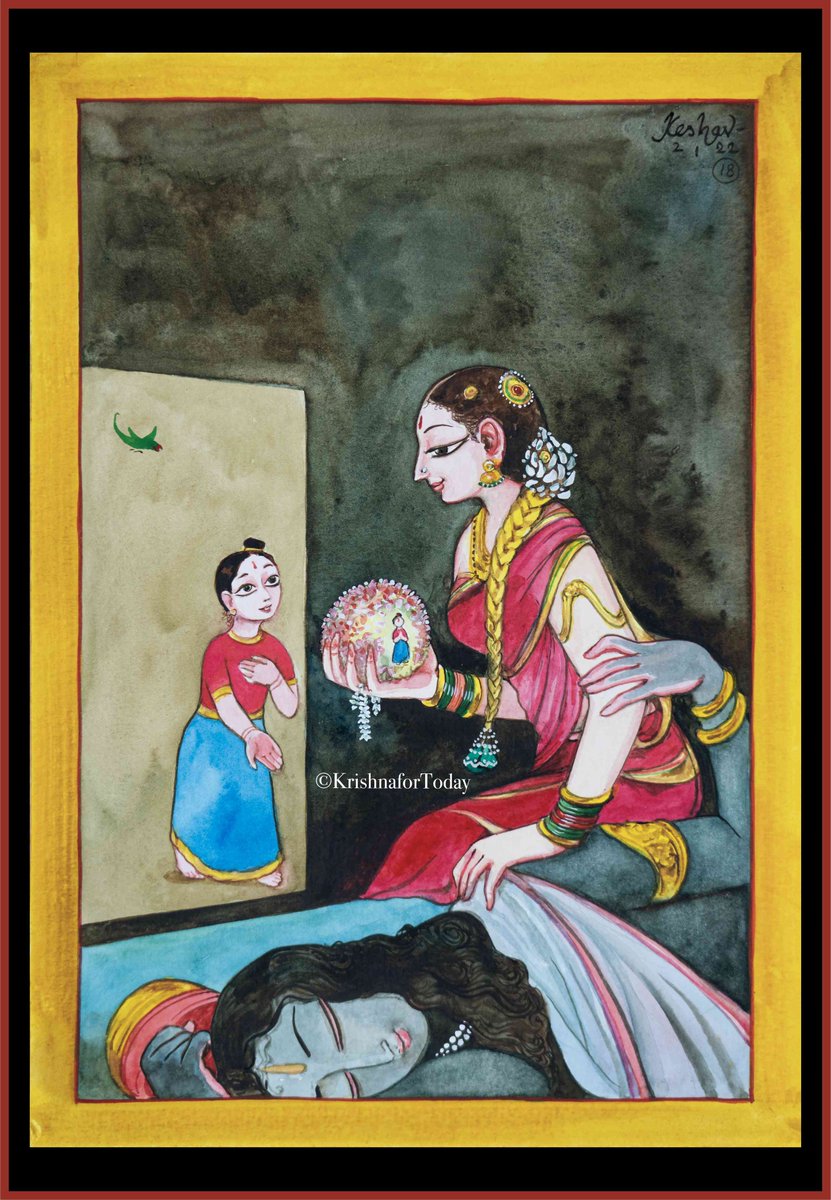
Thus we come to the end of Pasuram 18.
See you on the 19th day of Margazhi with the 19th Pasuram.
Thank you for reading.
See you on the 19th day of Margazhi with the 19th Pasuram.
Thank you for reading.
Starting with the 19th Pasuram!
In Pasurams 18,19 and 20 (that we'll see tomorrow), Andal addresses Lakshmi, seeking her approval to approach the Lord.
With each Pasuram, she gets one step closer!
In Pasurams 18,19 and 20 (that we'll see tomorrow), Andal addresses Lakshmi, seeking her approval to approach the Lord.
With each Pasuram, she gets one step closer!

Before speaking to Lakshmi, as she had done in Pasuram 18, Andal addresses Bhagavan first.
She describes the scene in the room.
With a lamp burning by the side (as the Guru guiding us), the center of the room houses a grand bed.
How grand?
She describes the scene in the room.
With a lamp burning by the side (as the Guru guiding us), the center of the room houses a grand bed.
How grand?
The bed is so grand that its 4 legs are made of ivory!
On it is a soft cotton mattress, where Lakshmi (Nappinnai) sits.
Her hair is adorned with flowers.
On her soft bosom, the Lord is resting his head.
On it is a soft cotton mattress, where Lakshmi (Nappinnai) sits.
Her hair is adorned with flowers.
On her soft bosom, the Lord is resting his head.

Andal addresses Vishnu as "மலர் மார்பா"(the one with a flowers on his chest).
She requests Him to open His mouth and allow her entry.
The epithet used here is interesting.
Bhagavan is resting on Lakshmi's lap, but He is also Srivatsa, the one with Sri (Lakshmi) in his chest!
She requests Him to open His mouth and allow her entry.
The epithet used here is interesting.
Bhagavan is resting on Lakshmi's lap, but He is also Srivatsa, the one with Sri (Lakshmi) in his chest!

So, Lakshmi is the flower that adorns His heart!
As we have discussed the concept of Eka Seshitvam yesterday, we know that Bhagavan and Lakshmi are inseparable from each other.
They are together the means and the objective!
As we have discussed the concept of Eka Seshitvam yesterday, we know that Bhagavan and Lakshmi are inseparable from each other.
They are together the means and the objective!

Despite Andal's requests, Bhagavan does not respond.
She turns to Lakshmi again.
"Nappinnai! The one with kohl in her eyes! I know that you will never let Him wake up!"
Now, why would Lakshmi not let the Lord wake up?
For that, let's enter the Ramayana!
She turns to Lakshmi again.
"Nappinnai! The one with kohl in her eyes! I know that you will never let Him wake up!"
Now, why would Lakshmi not let the Lord wake up?
For that, let's enter the Ramayana!
Remember Sundara Kanda of Valmiki Ramayana where Hanuman meets Sita?
He submits his credentials to a distrusting Sita by presenting the jewel Rama had given him.
Sita is convinced. She requests Hanuman to bring Rama and save her from Lanka.
But now, Hanuman has a problem!
He submits his credentials to a distrusting Sita by presenting the jewel Rama had given him.
Sita is convinced. She requests Hanuman to bring Rama and save her from Lanka.
But now, Hanuman has a problem!

Hanuman has convinced Sita that he has been sent by Rama.
But now, how to convince Rama that he has indeed met Sita?
Hanuman asks Sita to share something that would convince Rama.
What does Sita share?
But now, how to convince Rama that he has indeed met Sita?
Hanuman asks Sita to share something that would convince Rama.
What does Sita share?

Bereft of any markers that could identify her to Rama, Sita uses the one thing she has with her, her memory.
She recalls an incident that happened when they were in the forest.
Sita says that Rama rested his head on her lap and slept.
But a crow kept flying by!
She recalls an incident that happened when they were in the forest.
Sita says that Rama rested his head on her lap and slept.
But a crow kept flying by!

No matter how much she tried, the crow kept coming back and pecking her.
At one point, Rama woke up disturbed, and saw a bleeding Sita.
"Sita! What happened? Who did this?" he thundered.
At one point, Rama woke up disturbed, and saw a bleeding Sita.
"Sita! What happened? Who did this?" he thundered.
Learning what happened, Rama realised that the crow was son of Indra.
He picked up a darba grass from his mat and invoked the Brahmastra.
The arrow from Rama's bow chased the crow across worlds.
Indra's son (Jayanta is not named such in the Ramayana) begged for forgiveness.
He picked up a darba grass from his mat and invoked the Brahmastra.
The arrow from Rama's bow chased the crow across worlds.
Indra's son (Jayanta is not named such in the Ramayana) begged for forgiveness.

Rama said Brahmastra cannot be made ineffective.
The crow agreed to make his right eye the target.
So, Sita recalls this story to Hanuman and laments.
"Rama!You fired Brahmastra on a crow that merely pecked me. Why have you not rescued me from Ravana yet?"
The crow agreed to make his right eye the target.
So, Sita recalls this story to Hanuman and laments.
"Rama!You fired Brahmastra on a crow that merely pecked me. Why have you not rescued me from Ravana yet?"

Andal is perhaps drawing upon this by referring to Bhagavan sleeping on Lakshmi's lap.
"You couldn't help waking Him up that day because of the crow. So, you will definitely not wake Him up today!"
"You couldn't help waking Him up that day because of the crow. So, you will definitely not wake Him up today!"

Lakshmi is perhaps making up for that day when the crow disturbed Rama's sleep by not waking Him up now.
"I understand that the 2 of you are 1 & that you don't want to separate from Him even for a moment!
This does not help us. Please be kind enough, dear Lady, open the door!"
"I understand that the 2 of you are 1 & that you don't want to separate from Him even for a moment!
This does not help us. Please be kind enough, dear Lady, open the door!"
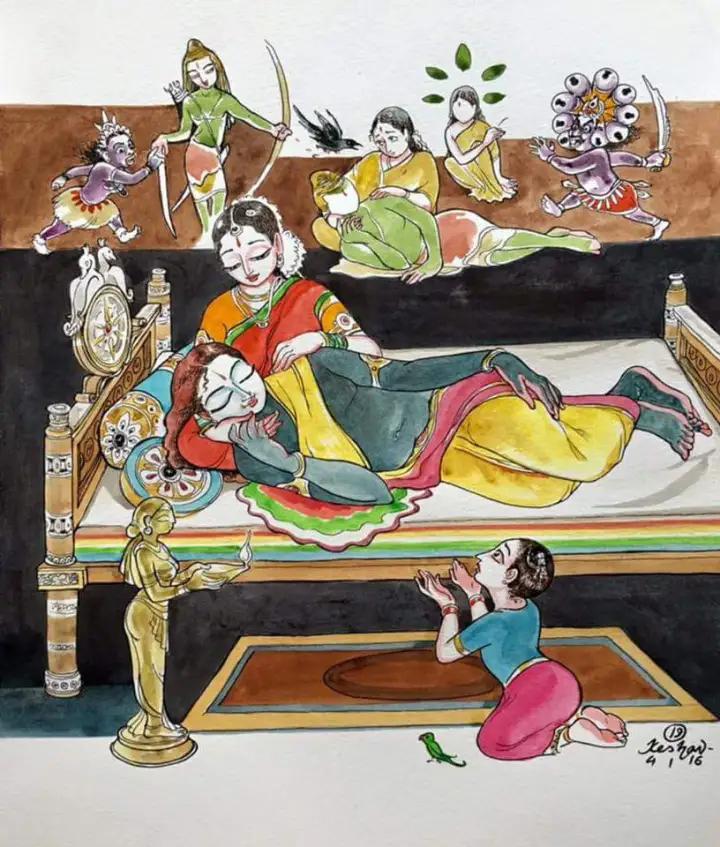
What are Surpanakha and Ravana doing in the painting here, you ask?
They never understood the oneness of Bhagavan &Lakshmi as Rama&Sita.
So, Surpanakha wanted Rama, but not Sita.
Ravana wanted Sita, but not Rama!
They never understood the oneness of Bhagavan &Lakshmi as Rama&Sita.
So, Surpanakha wanted Rama, but not Sita.
Ravana wanted Sita, but not Rama!

We come to the end of the 19th Pasuram!
Thank you for reading!
Thank you for reading!
Continuing with the Tiruppavai thread, after an inevitable break.
Let's look at Pasuram 20, the 3rd of the three Pasurams where Andal speaks to Lakshmi!
Let's look at Pasuram 20, the 3rd of the three Pasurams where Andal speaks to Lakshmi!
Nevertheless, she begins with Bhagavan.
What does Andal say?
She implores Him to wake up. He is the one who goes ahead of the 33, in order to save them from their trembling (fear).
Who are the 33?
What does Andal say?
She implores Him to wake up. He is the one who goes ahead of the 33, in order to save them from their trembling (fear).
Who are the 33?

Remember how we were repeatedly told that Hinduism has 33 crore gods?!
That's a mis-translation of these 33 eminent gods (the word Koti in Sanskrit means crore. It also means apex, excellence and eminence)
So, who are these 33?
That's a mis-translation of these 33 eminent gods (the word Koti in Sanskrit means crore. It also means apex, excellence and eminence)
So, who are these 33?
Yajnavalkya says in the Brihadaranyaka Upanishad that these are the 12 Adityas, the 11 Rudras, the 8 Vasus and the 2 Asvins, who combined together form the 33 Koti Devas!
Shall we look at these categories one by one?
Shall we look at these categories one by one?
The 12 Adityas are
Vivasvan (whose son is Manu and therefore, this age is Vaivasvata Manvantara),
Tvashta (who crafted Indra's Vajra),
Savitr (to whom the famous Gayatri mantra is dedicated),
Bhaga,
Data,
Mitra,
Varuna (the two are usually invoked together),
Vivasvan (whose son is Manu and therefore, this age is Vaivasvata Manvantara),
Tvashta (who crafted Indra's Vajra),
Savitr (to whom the famous Gayatri mantra is dedicated),
Bhaga,
Data,
Mitra,
Varuna (the two are usually invoked together),

The 11 Rudras have different names based on different sources.
The list in the Matsya Purana is:
Kapali, Bhima, Pingala, Virupaksha, Vilohita, Ajeta, Shasana, Shasta, Shambhu, Chanda and Dhruva.
The list in the Matsya Purana is:
Kapali, Bhima, Pingala, Virupaksha, Vilohita, Ajeta, Shasana, Shasta, Shambhu, Chanda and Dhruva.

The 8 Vasus are those who are born as humans to Shantanu and Ganga in the Mahabharata.
Why were the Vasus, of the 33 Koti devas born as mortals?
The Mahabharata says that they tried to abduct the cow Nandini, belonging to Vasishta.
Why were the Vasus, of the 33 Koti devas born as mortals?
The Mahabharata says that they tried to abduct the cow Nandini, belonging to Vasishta.

So, they were cursed by Vasishta to be born on the earth.
Upon profusely apologising, Vasishta forgave them and said that 7 out of the 8 will die soon after birth.
But Prabhasa who led the abduction of Nandini will have to live a long and painful life.
Upon profusely apologising, Vasishta forgave them and said that 7 out of the 8 will die soon after birth.
But Prabhasa who led the abduction of Nandini will have to live a long and painful life.
However, Vasishta blessed that Prabhasa's life will be filled with valour and glory despite pain and misery.
So, which character from the Mahabharata lived such a life? With valour and glory, but also pain and misery?
So, which character from the Mahabharata lived such a life? With valour and glory, but also pain and misery?
Devavrata/Bhishma of course!
The grand sire of the Kuru clan was the human form of the Vasu Prabhasa.
The other 7 Vasus were born as the children of Shantanu and Ganga. Ganga killed them immediately, to fulfill Vasishta's curse.
Why did Shantanu not stop her?
The grand sire of the Kuru clan was the human form of the Vasu Prabhasa.
The other 7 Vasus were born as the children of Shantanu and Ganga. Ganga killed them immediately, to fulfill Vasishta's curse.
Why did Shantanu not stop her?

Because those were the terms on which Ganga married Shantanu, that he would not question/stop her no matter what she did.
After all 7 Vasus were drowned, Shantanu could no longer control himself.
He stopped Ganga, as she was about to drown the 8th.
Pic: Ravi Varma
After all 7 Vasus were drowned, Shantanu could no longer control himself.
He stopped Ganga, as she was about to drown the 8th.
Pic: Ravi Varma

The 8th child, Prabhasa, was saved.
Ganga took him with her, promising Shantanu that she'll bring him back worthy of being the most righteous king.
Pic: Ravi Varma
Ganga took him with her, promising Shantanu that she'll bring him back worthy of being the most righteous king.
Pic: Ravi Varma

And how did Ganga fulfill the promise?
She brought the son Devavrata as the royal heir to the kingdom of the Kurus!
Pic: Bamapada Banerjee painting.
She brought the son Devavrata as the royal heir to the kingdom of the Kurus!
Pic: Bamapada Banerjee painting.

Bound by his sense of duty, Devavrata became Bheeshma of the terrible vow.
As guardian to the throne, he watched his clan of Kurus wasted by fratricide.
A life of valour and glory was spent filled with pain, suffering and misery out of the inability to stop the inevitable.
As guardian to the throne, he watched his clan of Kurus wasted by fratricide.
A life of valour and glory was spent filled with pain, suffering and misery out of the inability to stop the inevitable.

Perhaps one of the finest moments of Bheeshma's life comes not from when he stood guard, but from when he lay on the bed of arrows.
Unable to prevent the carnage, Bheeshma watched and waited.
After the war, Yudhishtra approached the grandfather for advice.
Unable to prevent the carnage, Bheeshma watched and waited.
After the war, Yudhishtra approached the grandfather for advice.

It is then that Bheeshma speaks to Yudhishtra, teaching him the lessons that neither Dhritarashtra, nor Duryodhana had bothered to learn from him.
Interestingly, the popular text of Vishnu Sahasranama also comes to us as a part of this conversation.
How?
Interestingly, the popular text of Vishnu Sahasranama also comes to us as a part of this conversation.
How?
As part of his questions about the duties of a ruler, administration of a kingdom, Dharma etc., he arrives at an important juncture.
He says Kim Ekam Daivatam Loke - Who's the One Lord of the World
Kim Vap Ekam Parayanam - Who is the singular last refuge+
He says Kim Ekam Daivatam Loke - Who's the One Lord of the World
Kim Vap Ekam Parayanam - Who is the singular last refuge+

Stuvantam kam kam archantah praapnuyuhmaanavah subham - By glorifying and worshipping whom can man reach Auspiciousness? 

It is in response to this that Bheeshma says,
Jagatprabhum devadevam anantam purushottamam
stuvan naama-sahasrena purushah satotthitah
The Lord of the world, the God of Gods, the Purushottama, it is by chanting his 1000 names that one attains Shubham.
Jagatprabhum devadevam anantam purushottamam
stuvan naama-sahasrena purushah satotthitah
The Lord of the world, the God of Gods, the Purushottama, it is by chanting his 1000 names that one attains Shubham.
After this, Bheeshma chants the 1000 names of Lord Vishnu, the Vishnu Sahasranama.
According to Bheeshma,
Anaadi-nidhanam vishnum sarvaloka-mahesvaram Lokaadhyaksham stuvan nityam sarva dukha atigo bhavet
Vishnu is without beginning and end, is the Lord of all worlds, +
According to Bheeshma,
Anaadi-nidhanam vishnum sarvaloka-mahesvaram Lokaadhyaksham stuvan nityam sarva dukha atigo bhavet
Vishnu is without beginning and end, is the Lord of all worlds, +
+ It is by chanting daily the glory of this Lokadhyaksha that one goes beyond all sorrow.
Since Bheeshma Himself states this, Andal is invoking the same Lord Vishnu in his form as Krishna.
Since Bheeshma Himself states this, Andal is invoking the same Lord Vishnu in his form as Krishna.
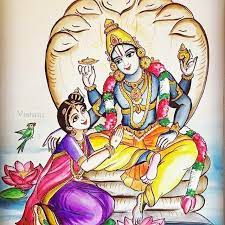
More importantly, Andal says Vishnu goes ahead of the 33 Devas and relieves them of their trembling (fear).
Through this reference, Andal is perhaps asking if Vishnu would turn up only for devotees as great as the 33 Devas, and not for a young girl!
But then!!
Through this reference, Andal is perhaps asking if Vishnu would turn up only for devotees as great as the 33 Devas, and not for a young girl!
But then!!

But then, we know that the Lord never forgets his devotees!
After all, He is the one who came down swiftly to rescue an elephant Gajendra who was attacked by the crocodile!
As the elephant cried His name in pain, the Lord came on Garuda to his rescue!
After all, He is the one who came down swiftly to rescue an elephant Gajendra who was attacked by the crocodile!
As the elephant cried His name in pain, the Lord came on Garuda to his rescue!

So, the Lord goes to protect Devas, He goes to save an elephant.
Will He not wake up from his Yoga Nidra for Andal?
Pic - Gajendra moksham from the Dashavatar temple of Deogarh
Will He not wake up from his Yoga Nidra for Andal?
Pic - Gajendra moksham from the Dashavatar temple of Deogarh

Gajendra moksham caught in bronze - from the Mathura Museum.
Interestingly, the placement of Vishnu's legs in Gajendra moksham is similar to Siva's during Gajasamhara.

Interestingly, the placement of Vishnu's legs in Gajendra moksham is similar to Siva's during Gajasamhara.


Returning to Andal.
After referring to Vishnu going ahead of the Devas, Andal follows Bheeshma's advice and sings the glory of the Lord.
She says, "You are of unmatched valour and splendour. You invoke fear in the hearts of your enemies! And yet, you are Vimala, blemishless!"
After referring to Vishnu going ahead of the Devas, Andal follows Bheeshma's advice and sings the glory of the Lord.
She says, "You are of unmatched valour and splendour. You invoke fear in the hearts of your enemies! And yet, you are Vimala, blemishless!"

Andal turns to Lakshmi.
She praises Lakshmi's appearance, her "soft charming breasts, slim waist and refined red lips" and requests Lakshmi to wake up.
And what should Lakshmi do after waking up?
She praises Lakshmi's appearance, her "soft charming breasts, slim waist and refined red lips" and requests Lakshmi to wake up.
And what should Lakshmi do after waking up?
Andal requests Lakshmi to wake up and give a mirror, a fan, and her husband (subtly included in the list of items that Lakshmi can provide), so that Andal and her gopi friends can observe the Paavai Nombu vrata.
This request is in line with what we have seen earlier!
How?
This request is in line with what we have seen earlier!
How?

Because Vishnu and Lakshmi are together the Upayam and the Upeyam (Means and end to Krishnanubhava).
So, it is no surprise that Andal requests Lakshmi to provide fan, mirror and Vishnu as well, so that they can observe their vrata.
So, it is no surprise that Andal requests Lakshmi to provide fan, mirror and Vishnu as well, so that they can observe their vrata.

If Vishnu can come for the undying (amar) 33 Devas, and the dying elephant (Gajendra), will He not come for Andal?
Let's see!
Let's see!

We come to the end of the 20th Pasuram!
I know I'm behind by 5 days! Promise to catch up soon!
Thank you for reading!
I know I'm behind by 5 days! Promise to catch up soon!
Thank you for reading!
PS - Looks like I did not give the list of names of the 8 Vasus.
Since we saw their role in the Mahabharata, let's look at the list of names of the Vasus from Mahabharata.
They are-Dharaa, Aapa, Anala, Anila, Pratyusha, Prabhasa, Soma and Dhruva.
The 8 Vasus and Ganga
Since we saw their role in the Mahabharata, let's look at the list of names of the Vasus from Mahabharata.
They are-Dharaa, Aapa, Anala, Anila, Pratyusha, Prabhasa, Soma and Dhruva.
The 8 Vasus and Ganga

PPS - The 2 Asvins are Nasatya and Dhaara. who fathered the twins Nakula and Sahadeva with Queen Madri. 

Starting with Pasuram 21!
As we enter the third decad of Tiruppavai, a quick recap.
In Pasurams 1-5, Andal spoke about the Paavai Nombu vrata, its rules, and objective.
In Pasurams 6-15, she gathered her Gopi friends to join her in observing the vrata.
As we enter the third decad of Tiruppavai, a quick recap.
In Pasurams 1-5, Andal spoke about the Paavai Nombu vrata, its rules, and objective.
In Pasurams 6-15, she gathered her Gopi friends to join her in observing the vrata.

In Pasurams 16-17, Andal sought the permission of the gatekeeper of the household, and Krishna's family -> Nandagopa, Yashoda and Balarama to approach Krishna. 

As we cross the 2/3rd mark of Tiruppavai, Andal speaks to Krishna directly.
Nevertheless, she still addresses Krishna through his father Nandagopa.
She calls Krishna as the son of the one who owns generous cows which give so much milk that it overflows all vessels
Nevertheless, she still addresses Krishna through his father Nandagopa.
She calls Krishna as the son of the one who owns generous cows which give so much milk that it overflows all vessels

Krishna is also the one who is full of flowing mercy, like the cows and their milk.
He is also the big one (The one who measured the three worlds as Trivikrama).
The next part is interesting.
Pic from the Ulagalantha Perumal (Trivikrama) temple in Kanchi.
He is also the big one (The one who measured the three worlds as Trivikrama).
The next part is interesting.
Pic from the Ulagalantha Perumal (Trivikrama) temple in Kanchi.
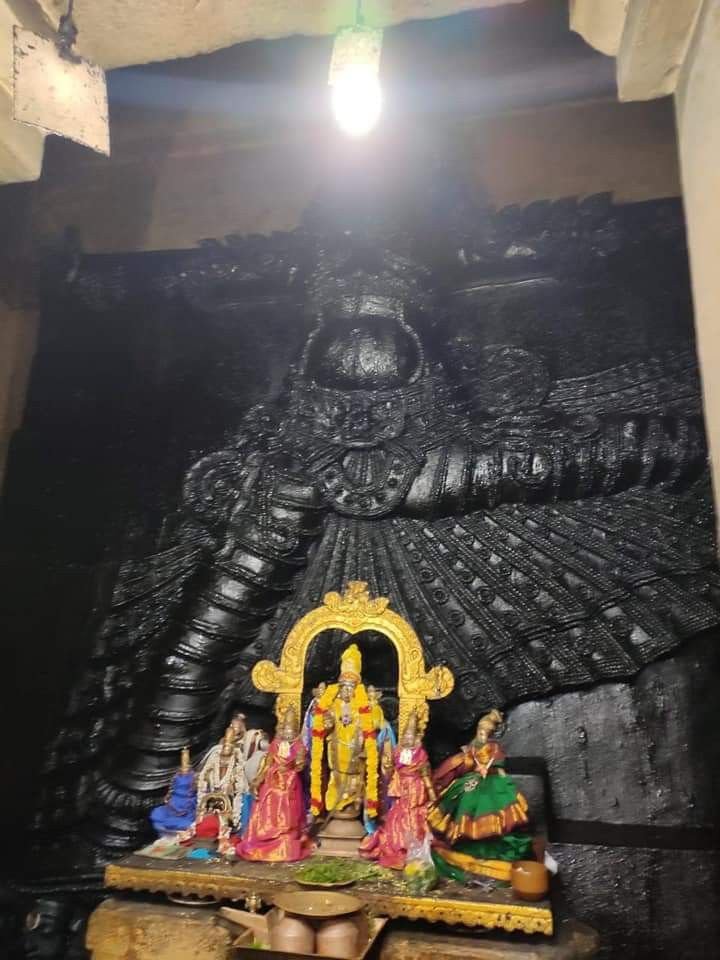
Krishna is also the one who stood at the beginning of the world.
This is a reference to the Narayana Suktam which says
Yacca kincign-jagat sarvam drshyate shrooyate api vaa
Antar bahish-ca tatsarvam vyaapya naaraayaNa: sthitha:
This is a reference to the Narayana Suktam which says
Yacca kincign-jagat sarvam drshyate shrooyate api vaa
Antar bahish-ca tatsarvam vyaapya naaraayaNa: sthitha:

This is the Visvatvam of Narayana - All worlds are in Him.
He is all creation, all of which has emerged from Him, as we can see in the Visvaroopa Darisanam.
At the same time...
He is all creation, all of which has emerged from Him, as we can see in the Visvaroopa Darisanam.
At the same time...

All creation has emerged from Him. He pervades the universe through his presence.
At the same time, all creation is also within him.
At the same time, all creation is also within him.

Andal then addresses Krishna as "Sudar" as the flame of light.
This is again from a very popular verse of the Narayana Suktam.
Neela thoyadha madhyastha dwidyullekheva bhaswaraa,
Neevara sooka vathanvee peetha bhaswat yanoopama.
+
This is again from a very popular verse of the Narayana Suktam.
Neela thoyadha madhyastha dwidyullekheva bhaswaraa,
Neevara sooka vathanvee peetha bhaswat yanoopama.
+
+ Like a crack of lightning from inside a dark cloud
Like the sprout of red paddy
Like the smallest atom
The eternal flame (which is Narayana) continues burning.
Like the sprout of red paddy
Like the smallest atom
The eternal flame (which is Narayana) continues burning.

His greatness is such that even those who are His enemies, come all the way to His doorstep, and bow down to His feet.
I'd like to digress into a thread on how Vali questions Rama and then bows to Him, but let's keep that for another day.
I'd like to digress into a thread on how Vali questions Rama and then bows to Him, but let's keep that for another day.

Andal concludes the 21st Pasuram by saying, "We come singing your glory, as part of the Paavai Nombu vrata.
Starting with the 22nd Pasuram!
Andal continues to address Krishna directly in Pasurams 21-25.
This time, she does away with the reference to Nandagopa.
But again, she draws a description, not of Krishna, but of his bed!
What does she say?
Andal continues to address Krishna directly in Pasurams 21-25.
This time, she does away with the reference to Nandagopa.
But again, she draws a description, not of Krishna, but of his bed!
What does she say?
The mighty kings of this wide world, shorn of their pride, gather below Krishna's bed!
Andal says she &other humble Gopis have also gathered likewise there!
Look at the king emerging after shedding his crown!
But this isn't a random metaphor! Has any metaphor been random?
Andal says she &other humble Gopis have also gathered likewise there!
Look at the king emerging after shedding his crown!
But this isn't a random metaphor! Has any metaphor been random?

In the Mahabharata, the best efforts to stop the war fail.
A peace mission by Krishna Himself seeking a mere 5 villages for the Pandavas also fails.
War is imminent!
Preparations begin!
A peace mission by Krishna Himself seeking a mere 5 villages for the Pandavas also fails.
War is imminent!
Preparations begin!

Each side begins to look for allies.
Having affinity to both Kauravas and Pandavas, the Yadavas cannot take sides that easily.
However, their powerful presence makes them worthwhile allies.
So, both sides send emissaries to Dvaraka to meet Krishna!
Having affinity to both Kauravas and Pandavas, the Yadavas cannot take sides that easily.
However, their powerful presence makes them worthwhile allies.
So, both sides send emissaries to Dvaraka to meet Krishna!
The Pandavas send Krishna's friend, Arjuna, the Nara to His Narayana.
Duryodhan goes on behalf of the Kauravas.
Yes, the same Duryodhana who had wanted to take Krishna prisoner not too long ago, during the peace mission.
Pic: Ravi Varma
Duryodhan goes on behalf of the Kauravas.
Yes, the same Duryodhana who had wanted to take Krishna prisoner not too long ago, during the peace mission.
Pic: Ravi Varma

Remember how Andal said in Pasuram 21 that even Krishna's enemies come to his doorstep in surrender?
That's where Duryodhana is, at Krishna's doorstep.
https://twitter.com/jeysundhar_d/status/1480414659236691969
That's where Duryodhana is, at Krishna's doorstep.
He enters Krishna's house, sees him asleep, sees a chair next to the head of the bed.
He is after all, the prince of Hastinapura.
He occupies the chair and waits for Krishna to wake up.
He is after all, the prince of Hastinapura.
He occupies the chair and waits for Krishna to wake up.
As Duryodhana waits, Arjuna enters the room.
He sees Krishna asleep. He spots Duryodhana sitting by the head of the bed.
He folds his hands, bows his head and stands waiting for Krishna to wake up.
He sees Krishna asleep. He spots Duryodhana sitting by the head of the bed.
He folds his hands, bows his head and stands waiting for Krishna to wake up.

As Krishna wakes up with a knowing smile, His eyes glance upon Arjuna.
"Oh, dear Arjuna! When did you arrive? Welcome to Dvaraka!"
"Oh, dear Arjuna! When did you arrive? Welcome to Dvaraka!"
"I am also here. I've been waiting longer than he has!" grunts Duryodhana from the chair.
Krishna turns his neck around with seeming difficulty, "Oh Duryodhana! You are here too! I didn't notice you sitting here!"
"Yes, well now you have! We're both here for your help!"
Krishna turns his neck around with seeming difficulty, "Oh Duryodhana! You are here too! I didn't notice you sitting here!"
"Yes, well now you have! We're both here for your help!"

"Oh, is that right, Arjuna? Are you here to seek my help?"
Arjuna nods.
"Both of you know that I'm close to both sides. But since you are here to seek my help, I will make you an offer."
Arjuna and Duryodhana look intently at Krishna.
Arjuna nods.
"Both of you know that I'm close to both sides. But since you are here to seek my help, I will make you an offer."
Arjuna and Duryodhana look intently at Krishna.
"I have decide to divide my forces into two parts, perhaps not equal halves. On one side, you have my Narayani Sena, the dreaded army of a million fighters of Dvaraka. There is no better army in the world right now."
Krishna pauses to let that sink in.
Krishna pauses to let that sink in.

"On the other side, you will have me, just me. And I will not carry any weapons or fight in this war. This is my offer and as such is not subject to change."
Krishna takes a deep breath, looks at Arjuna and Duryodhana.
"Arjuna, what would you like to choose?"
Krishna takes a deep breath, looks at Arjuna and Duryodhana.
"Arjuna, what would you like to choose?"
Duryodhana's voice roars in protest,
"Krishna! This is not fair. You said you are close to both of us. Why does HE get to choose first? Are you playing favourites as usual?"
"No, dear Duryodhana. How can you say that? Anyway,why do you think Arjuna should not choose first?"
"Krishna! This is not fair. You said you are close to both of us. Why does HE get to choose first? Are you playing favourites as usual?"
"No, dear Duryodhana. How can you say that? Anyway,why do you think Arjuna should not choose first?"
"I am the older one. I came to you first. So, fairness dictates that you ask me first."
"Duryodhana, Duryodhana, calm down! Even if you came first, my eyes fell first on Arjuna. To me, he was first! And don't you have the generosity of heart to let the younger one choose first?"
"Duryodhana, Duryodhana, calm down! Even if you came first, my eyes fell first on Arjuna. To me, he was first! And don't you have the generosity of heart to let the younger one choose first?"
Arjuna obviously chooses Krishna.
Duryodhana's delighted. He gets mighty Narayani Sena! He thanks Krishna &leaves.
It isn't much later that he realises यतः कृष्णस्ततो धर्मो यतो धर्मस्ततो जयः
Where there is Krishna, there is Dharma.
Where there is Dharma, there is victory.
Duryodhana's delighted. He gets mighty Narayani Sena! He thanks Krishna &leaves.
It isn't much later that he realises यतः कृष्णस्ततो धर्मो यतो धर्मस्ततो जयः
Where there is Krishna, there is Dharma.
Where there is Dharma, there is victory.
This story tells us who the Lord chooses first!
Which is why Andal says that like the kings shorn of their pride (like Arjuna himself did), she and the Gopis are waiting at the foot Krishna's bed.
Which is why Andal says that like the kings shorn of their pride (like Arjuna himself did), she and the Gopis are waiting at the foot Krishna's bed.

Andal asks Krishna to open His eyes, and how?
Like the lotus buds on the salangai/ghunguroo, holding the bead inside, He should open his pundareekaksha (lotus eyes) to look at them
Like the lotus buds on the salangai/ghunguroo, holding the bead inside, He should open his pundareekaksha (lotus eyes) to look at them

Andal implores Krishna that His two eyes open like Surya and Chandra and glance upon Andal and the Gopis.
After all, Vishnu is called "chandra sooryau cha netre" (the one with Chandra and Surya as eyes) in the Vishnu Sahasranama.
Why should He do that? Andal tells us.
After all, Vishnu is called "chandra sooryau cha netre" (the one with Chandra and Surya as eyes) in the Vishnu Sahasranama.
Why should He do that? Andal tells us.

Andal says that if His two eyes were to glance upon them, their sins and curses will be washed away.
As Krishna says in the last verse of the last chapter of the Bhagavad Gita (Charama Sloka), "Maam Ekam Saranam Vraja"– I am alone the One who can give moksha.
As Krishna says in the last verse of the last chapter of the Bhagavad Gita (Charama Sloka), "Maam Ekam Saranam Vraja"– I am alone the One who can give moksha.

If you were to act like a king, like Duryodhana or Kalinga did, He would dance on your heads!
Stand at his feet, and He would bless you with Krishnanubhava!
Stand at his feet, and He would bless you with Krishnanubhava!

After all, He is the Krishna who rejected the royal palaces of the Kauravas, and chose to stay in the humble house of Vidura, and ate his food.
May He bless us all!
We come to the end of Pasuram 22.
Thank you for reading!
May He bless us all!
We come to the end of Pasuram 22.
Thank you for reading!

Starting with Pasuram 23!
As we saw earlier, in Pasurams 21-25, Andal addresses Krishna directly.
In 21 and 22, we saw her exhorting Krishna to wake up.
In Pasuram 23, she tells Him HOW He should wake up!
How's that?
As we saw earlier, in Pasurams 21-25, Andal addresses Krishna directly.
In 21 and 22, we saw her exhorting Krishna to wake up.
In Pasuram 23, she tells Him HOW He should wake up!
How's that?
Andal says Krishna should wake up like how a lion wakes up in his cave at the end of the rainy season.
This stems from the idea that during rainy season, the lion stays in his cave and emerges at the end of the season.
But why cave? Why lion?
This stems from the idea that during rainy season, the lion stays in his cave and emerges at the end of the season.
But why cave? Why lion?

Why cave?
The Taittriya Upanishad (TU) says "Satyam Jnanam Anantam Brahma"
The Brahman is the truth, the knowledge, and the infinite.
Ok, where is this Brahman?
TU says that this Brahman is "nihitam guhaayaam", in the inner cave of our heart!
The Taittriya Upanishad (TU) says "Satyam Jnanam Anantam Brahma"
The Brahman is the truth, the knowledge, and the infinite.
Ok, where is this Brahman?
TU says that this Brahman is "nihitam guhaayaam", in the inner cave of our heart!

Ok, so why lion?
Well, Andal has already told us in the 1st Pasuram, that she worships the young lion of Yashoda!
Well, Andal has already told us in the 1st Pasuram, that she worships the young lion of Yashoda!
https://twitter.com/jeysundhar_d/status/1471397645730131977
But between Pasuram 1 and Pasuram 23, the description of the lion undergoes a transformation.
In 23, Andal says that the lion should wake up at the end of the rainy season.
The lion would wake up with its eyes flaming with the eternal fire!
In 23, Andal says that the lion should wake up at the end of the rainy season.
The lion would wake up with its eyes flaming with the eternal fire!

It would shake its fiery mane and stand up with a thundering roar that shakes the entire cave!
Bhagavatam (7:8:30) describes Narasimha thus!
"With his fiery mane sprinkled with blood, and his fierce eyes full of anger, and Hiranyakasipu's intestines garlanded Him."
Check pic!
Bhagavatam (7:8:30) describes Narasimha thus!
"With his fiery mane sprinkled with blood, and his fierce eyes full of anger, and Hiranyakasipu's intestines garlanded Him."
Check pic!

"With the intestines garlanding Him, Narasimha stood there like a lion that has slain an elephant in battle!"
Pic: Narasimha from Belur Chennakesava temple.
Pic: Narasimha from Belur Chennakesava temple.

Andal says this fearsome form of Narasimha, sleeping deep in the cave of our very being, during the rainy season of Maya, should awaken and stride majestically out!
And as the Lion marches forward, the description changes!
And as the Lion marches forward, the description changes!

Andal invokes Krishna as the one in the colour of the blue lotus.
She says, "Come to us from temple (the temple of our heart),&adorn this majestic Sinhasana".
See how the Lion woke up in the cave, walked majestically, became the beloved blue God, and sat on Lion throne?
She says, "Come to us from temple (the temple of our heart),&adorn this majestic Sinhasana".
See how the Lion woke up in the cave, walked majestically, became the beloved blue God, and sat on Lion throne?

And what should the Lord do once he adorns the Lion throne?
Why, He should listen to Andal of course! She's going to tell Him why they have all come here!
Why, He should listen to Andal of course! She's going to tell Him why they have all come here!

With that we come to the end of the 23rd Pasuram!
Looks like we'll catch up after all!
Thank you for reading!
Looks like we'll catch up after all!
Thank you for reading!
Starting the morning with the 24th Pasuram.
But before we go to the text, let's take a moment to adore this handsome Chennakesava wax model made by @Navachola
Chennakesava is depicted with 4 arms holding chakra, shanka, lotus and gada, and stands on 2 legs.
Why this form?
But before we go to the text, let's take a moment to adore this handsome Chennakesava wax model made by @Navachola
Chennakesava is depicted with 4 arms holding chakra, shanka, lotus and gada, and stands on 2 legs.
Why this form?

In Pasuram 24, Andal extols the greatness of Vishnu through His grand exploits.
What are these exploits?
Andal begins with the Krita yuga and the Vamana Avatara.
She also begins with Vishnu's foot!
What are these exploits?
Andal begins with the Krita yuga and the Vamana Avatara.
She also begins with Vishnu's foot!

Andal says, "We worship your feet which scaled the worlds back in the day."
Vamana sought Bali Chakravarti to provide 3 feet of land.
Bali looks at Vamana's feet.
"Are you sure? Doesn't seem like much! I am Mahabali, you know. I can offer you more!"
"3 feet is all I need!"
Vamana sought Bali Chakravarti to provide 3 feet of land.
Bali looks at Vamana's feet.
"Are you sure? Doesn't seem like much! I am Mahabali, you know. I can offer you more!"
"3 feet is all I need!"

Bali's guru Sukracharya intervenes.
"Bali! This is a trick. Don't agree to the request. Ask Vamana to seek something else."
"Bali! This is a trick. Don't agree to the request. Ask Vamana to seek something else."

Bali looks at Sukracharya and smiles.
"I am Chakravarti Mahabali. I rule the worlds. There's nothing that I cannot give. He asks but for 3 feet of land. And honestly, look at his feet. How much land can he measure with those?"
"I am Chakravarti Mahabali. I rule the worlds. There's nothing that I cannot give. He asks but for 3 feet of land. And honestly, look at his feet. How much land can he measure with those?"

Bali proceeds to pour water from the jug to Vamana's hands, in order to finish the Dana.
The relentless Sukracharya, turns into a bee and blocks the spout of the jug.
Vamana picks up a darbha grass and pokes the spout, blinding Sukracharya and removing the block.
The relentless Sukracharya, turns into a bee and blocks the spout of the jug.
Vamana picks up a darbha grass and pokes the spout, blinding Sukracharya and removing the block.
Once the dana is complete, Vamana transforms into Trivikrama and scales the three worlds, and places the third foot on Bali's head. 

As we have discussed before, Vamanavatara finds mention repeatedly in the Tiruppavai.
Andal accords this Avatara a special status because in this Avatara, Vishnu as Trivikrama touches all worlds and beings with His feet, thus blessing them all.
Andal accords this Avatara a special status because in this Avatara, Vishnu as Trivikrama touches all worlds and beings with His feet, thus blessing them all.
https://twitter.com/jeysundhar_d/status/1477652144216023048
So, that's the first foot that Andal captures through the Vamana/Trivikrama Avatara.
What about the other one?
Andal speaks about the time Krishna kicked Sakatasura who was disguised as the wheel of the cart.
What about the other one?
Andal speaks about the time Krishna kicked Sakatasura who was disguised as the wheel of the cart.

We have already discussed this here.
https://twitter.com/jeysundhar_d/status/1473307096804470784
She says, "Oh Krishna! We worship your greatness in winning over Lanka (after defeating Ravana in Ramavatara)" 

"We worship your greatness in turning the Govardhana hill into an umbrella to protect your village and kin"
We discussed this here.
We discussed this here.
https://twitter.com/jeysundhar_d/status/1472591766016638977
Andal also says, "We worship your strength in throwing the calf on the tree"
This is a reference to the Vatsasura episode in the Krishna Avatara, where Kansa sends Vatsasura and Kapitthasura to kill Krishna!
This is a reference to the Vatsasura episode in the Krishna Avatara, where Kansa sends Vatsasura and Kapitthasura to kill Krishna!
Vatsasura disguises himself as a calf and mixes with the flock that Krishna is herding.
Kapitthasura, as the name suggests, stands as a wood apple tree, a little distance away.
Krishna spots one of the calves behaving strangely and informs Balarama.
Kapitthasura, as the name suggests, stands as a wood apple tree, a little distance away.
Krishna spots one of the calves behaving strangely and informs Balarama.

Their suspicions confirmed, Krishna drags the calf (Vatsasura in disguise) and hurls it at the woodapple tree, destroying them both.
It is this strength that Andal extols!
It is this strength that Andal extols!

For the 4th hand, Andal revisits the theme of the spear (from the 1st Pasuram) and worships the Vel that defeats enemies and brings victory to Krishna. 

Andal concludes Pasuram 24 by saying that they (Andal and the Gopis) have come to sing forever the praise of the Lord, be his Sevaks and in return, seek the Parai He would give them. 

Starting with the 25th Pasuram!
Andal continues to extol the glories of the Lord. This time, she gets straight to His birth.
She says "Oh Krishna! You were born as the son of one lady (Devaki)" at once, "hidden as the son of another lady(Yashoda)"
Andal continues to extol the glories of the Lord. This time, she gets straight to His birth.
She says "Oh Krishna! You were born as the son of one lady (Devaki)" at once, "hidden as the son of another lady(Yashoda)"

Born in prison, Krishna was transported overnight by Vasudeva to his friend Nandagopa's house!
There he is hidden as the son of Yashoda and Nandagopa!
There he is hidden as the son of Yashoda and Nandagopa!

We had discussed this here
Unlike Rama's father Dasaratha, who was blessed with four sons, Krishna has 4 parents - Devaki-Vasudeva and Yashoda-Nandagopa!
https://twitter.com/jeysundhar_d/status/1472891622643970049
Unlike Rama's father Dasaratha, who was blessed with four sons, Krishna has 4 parents - Devaki-Vasudeva and Yashoda-Nandagopa!
Thus, in this Pasuram, Andal discusses the Krishna Avatara Rahasyam!
So, how does the evil Kansa feel with Krishna escaping from right under his nose?
He burns with rage! But what is the fire that burns in Kansa?
It is the eternal fire, Krishna Himself!
So, how does the evil Kansa feel with Krishna escaping from right under his nose?
He burns with rage! But what is the fire that burns in Kansa?
It is the eternal fire, Krishna Himself!

Andal says, "We come praying to you!"
And why are they doing that?
Because, Bhagavan will give them the Parai (Drum and Moksha)
Andal says they will sing the glory of the wealth.
What wealth? Why praise wealth during a vrata?
Isn't that strange?
Let's see what Andal says!
And why are they doing that?
Because, Bhagavan will give them the Parai (Drum and Moksha)
Andal says they will sing the glory of the wealth.
What wealth? Why praise wealth during a vrata?
Isn't that strange?
Let's see what Andal says!
Andal says that they will sing praise of the wealth that is worth of Thiru (Sri).
Sri (Lakshmi) is the Goddess of wealth.
It is She that blesses us with wealth.
She is the one that showered 1000s of golden gooseberries (Amalakas) when Sankara sang the Kanakadhara Stotram!
Sri (Lakshmi) is the Goddess of wealth.
It is She that blesses us with wealth.
She is the one that showered 1000s of golden gooseberries (Amalakas) when Sankara sang the Kanakadhara Stotram!
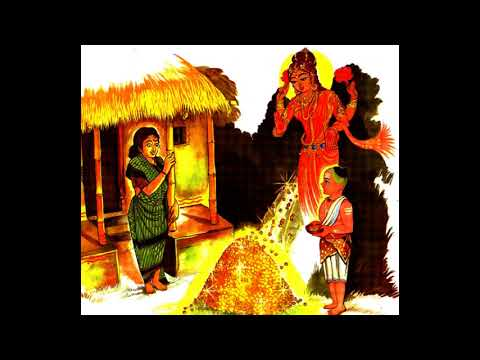
So, this is similar to the paradigm of "What do you give the man who has everything?"
What is the wealth that is worthy of the Goddess of Wealth?
Bhagavan, of course!
She and He are One!
What is the wealth that is worthy of the Goddess of Wealth?
Bhagavan, of course!
She and He are One!

So, Andal says we sing your praise, to be free of our sorrows and observe the Paavai Nombu vrata!
Thus, we come to the end of the 25th Pasuram!
Thank you for reading!
Thus, we come to the end of the 25th Pasuram!
Thank you for reading!

Starting with Pasuram 26!
Andal begins this Pasuram with a clear invocation of the Lord, not a circuitous attribute, but directly!
She begins by saying, "Maale!"(A name of Vishnu -Thirumaal).
She calls Him as one who is color of the gem (Mostly interpreted as Blue Sapphire).
Andal begins this Pasuram with a clear invocation of the Lord, not a circuitous attribute, but directly!
She begins by saying, "Maale!"(A name of Vishnu -Thirumaal).
She calls Him as one who is color of the gem (Mostly interpreted as Blue Sapphire).

She says, "We'd like to observe the vrata the way the great elders did! And for that we seek a few things from you!"
What things?
Andal says that they need conches.
Of what kind?
What things?
Andal says that they need conches.
Of what kind?

Andal says that they need conches like Vishnu's Panchajanya!
Why so?
Because it is the Panchajanya which is white as the milk swan and shakes the worlds when it blows!
But that's not all!
Why so?
Because it is the Panchajanya which is white as the milk swan and shakes the worlds when it blows!
But that's not all!

So several conches like the Panchajanya, several drums (Parai), and several musicians so they can sing the Pallaandu hymn!
And that's not all!
And that's not all!

Ok, so conches, drums,musicians, what else?
The list is long!
Andal seeks a decorated lamp (Guru for guidance), Flags (to hail Krishna) and a hall under His protection to sing His glory!
The list is long!
Andal seeks a decorated lamp (Guru for guidance), Flags (to hail Krishna) and a hall under His protection to sing His glory!

Towards the end of the Pasuram, Andal addresses Krishna as the one on the banyan leaf.
This is a reference to the Vatapatrasayee (Krishna on Vata Patra - banyan leaf) temple in Srivilliputhur, Andal's home town.
This is a reference to the Vatapatrasayee (Krishna on Vata Patra - banyan leaf) temple in Srivilliputhur, Andal's home town.

But why banyan leaf?
For that we need to go to the Vana Parva of the Mahabharata!
In the Vana Parva, Yudhishtra asks the sage Markandeya,
"Sire! By virtue of being a Chiranjeevi, you have seen 1000s of ages pass away"+
For that we need to go to the Vana Parva of the Mahabharata!
In the Vana Parva, Yudhishtra asks the sage Markandeya,
"Sire! By virtue of being a Chiranjeevi, you have seen 1000s of ages pass away"+
+"When neither sun, nor moon, nor fire, nor earth, nor air, nor sky remains, when all the world looks like one vast ocean, when Brahma remains on the Lotus floor, you alone are left to worship Him.
So, explain to me the cause of all things!"
So, explain to me the cause of all things!"

So, Markandeya tells Yudhishtra about the time he sat by the banks of the Subhadra river and contemplated on all existence.
He entered a vision, finding himself in the great infinite deluge that stretched as far as the eyes could see.
He entered a vision, finding himself in the great infinite deluge that stretched as far as the eyes could see.

"Oh wise Yudhishtra! I swam in that deluge for thousands of years, forgetting that even Time existed!
All I saw around me was water, and there was no sign of land. I continued to swim around!"
All I saw around me was water, and there was no sign of land. I continued to swim around!"
"After several eons had passed by me, I noticed in the distance a large banyan leaf.
I immediately swam towards it. As I got closer to the leaf, I saw a child, a mere baby floating on top of the leaf.
Seeing me, his dark form moved. I swam faster towards the leaf."
I immediately swam towards it. As I got closer to the leaf, I saw a child, a mere baby floating on top of the leaf.
Seeing me, his dark form moved. I swam faster towards the leaf."

"As I got closer, the child looked at me and smiled. In that smile, the desolateness of the deluge disappeared and I felt protected by the grace of that smile.
The baby picked up his leg and sucked his big toe, perhaps to see if its sweetness had passed into the water!"
The baby picked up his leg and sucked his big toe, perhaps to see if its sweetness had passed into the water!"
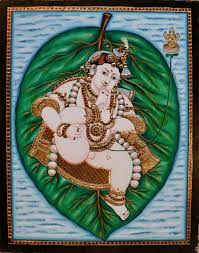
"I was lost in the grace of the child.He took me in. And in a flash, I saw all worlds, all beings, living and non-living, all that the universes had been, were all in Him.
I delved deeper only to see the Subhadra river and me sitting on its banks.
It is then that I realised."
I delved deeper only to see the Subhadra river and me sitting on its banks.
It is then that I realised."
Yudhishtra listened with rapt attention as Markandeya continued, overwhelmed by the recollection of his vision.
"It is then that I realised that the child was none other than Narayana Himself"
"It is then that I realised that the child was none other than Narayana Himself"

"I heard a thundering voice inside my head", Markandeya continued, "asking me what I wanted"
"Having realised the infinity of the Lord, what more can one want? But then, I sought to understand His Maya"
"Having realised the infinity of the Lord, what more can one want? But then, I sought to understand His Maya"
"Before the thought could form in my head, He sent me out from within Him. I found myself back on the banks of the Subhadra river.
The Lord spoke: I am the Narayana, the beginning and the end. I am the waters from which all creation comes and into which it all returns"
The Lord spoke: I am the Narayana, the beginning and the end. I am the waters from which all creation comes and into which it all returns"

As she comes to the last few Pasurams of Tiruppavai, Andal invokes this form of Krishna as the child on the banyan leaf, seeking Him to provide them with conch, drums, lamp, flag and a hall for them to observe the Pavai Nombu Vrata. 

Thus, we come to the end of Pasuram 26.
Thank you for reading.
Thank you for reading.
Starting with Pasuram 27!
There is a definite shift in the tone of this Pasuram.
As the Pavai Nombu vrata draws to an end, a sense of celebration enters the Gopis.
There is a definite shift in the tone of this Pasuram.
As the Pavai Nombu vrata draws to an end, a sense of celebration enters the Gopis.

Andal addresses Krishna as the one who wins over even those that are not on His side.
We already saw how Indra tried to drown the village and Krishna raised the Govardhana Hill and humbled Indra.
We already saw how Indra tried to drown the village and Krishna raised the Govardhana Hill and humbled Indra.
https://twitter.com/jeysundhar_d/status/1472591766016638977
We also saw how the arrogant Duryodhana was forced to come to Krishna's doorstep seeking his support before the Kurukshetra war.
https://twitter.com/jeysundhar_d/status/1480515543878696960
We also saw how the Chiranjeevi Markandeya swam the deluge for thousands of years and learnt about the avatara rahasya and srishti rahasya of the Lord.
But...
https://twitter.com/jeysundhar_d/status/1480943686418460672
But...
But, the same Krishna showed the presence of the universes in Him, to the humble Yashoda.
And without making her face the deluge or overwhelming her.
All she had to do was look into His mouth!
And without making her face the deluge or overwhelming her.
All she had to do was look into His mouth!

Speaking of the Kurukshetra war. we also saw how Krishna had taken a vow to not bear weapons during the war.
However, the parama bhagavata Bheeshma had also taken another vow!
What was that?
https://twitter.com/jeysundhar_d/status/1480521007244853249
However, the parama bhagavata Bheeshma had also taken another vow!
What was that?
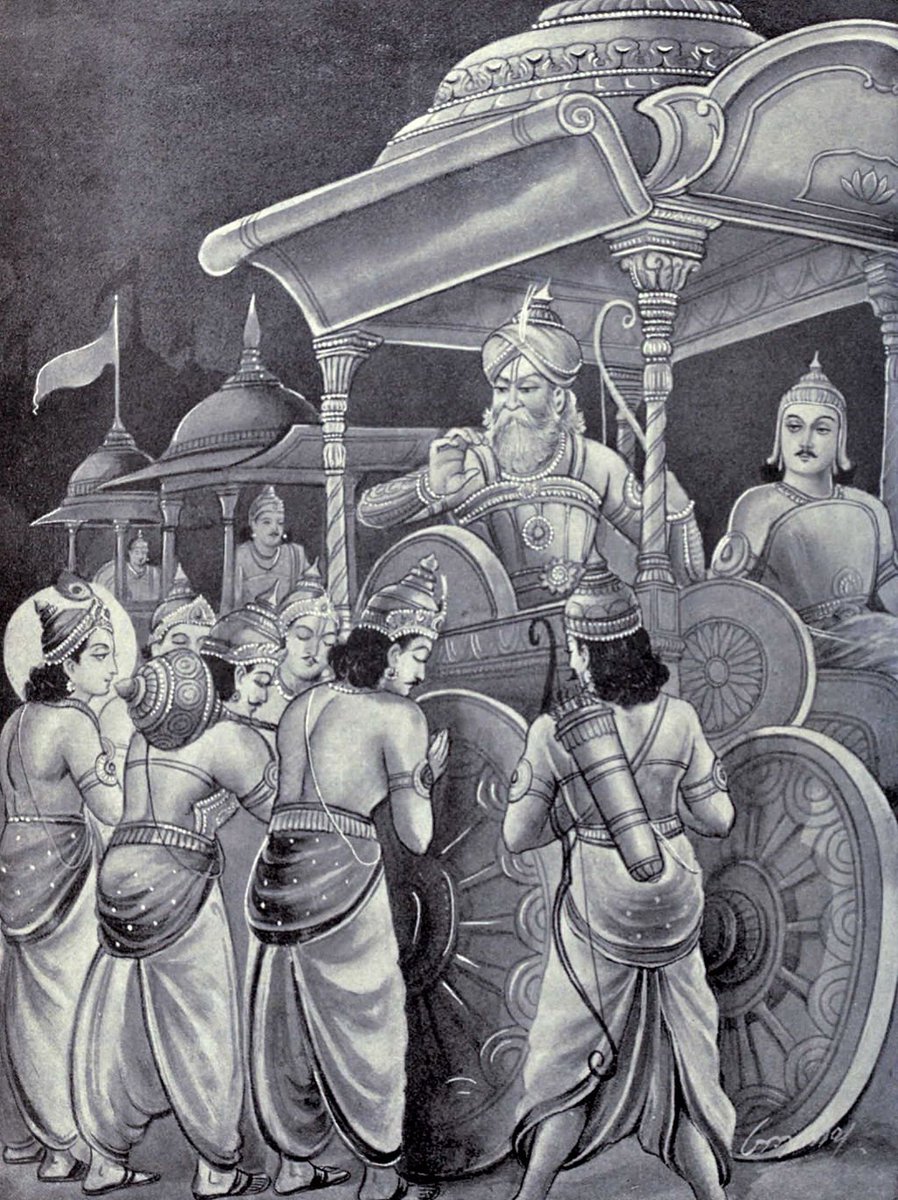
So, Bheeshma known for his terrible vows, had vowed that he will make Krishna bear weapons during the war.
Almost half the war passes by, with the unrelenting Bheeshma leading the Kaurava forces.
Almost half the war passes by, with the unrelenting Bheeshma leading the Kaurava forces.

Bheeshma had promised to not harm the Pandavas. Despite that, he is destroying the Pandava army by the thousands.
On 9th day, Krishna chides Arjuna on his inability to defeat the Grand Sire!
"You are too easy on him! Your love for the old man is slowing down your arrows!"
On 9th day, Krishna chides Arjuna on his inability to defeat the Grand Sire!
"You are too easy on him! Your love for the old man is slowing down your arrows!"

"I'm trying, Krishna! Can't you see? The grandfather is too strong!"
In the meantime, Bheeshma's arrows destroy another battalion of the Kaurava army.
"Arjuna! If YOU don't do it, I'm going to!"
With that, Krishna gets down from the chariot.
What does He do?!
In the meantime, Bheeshma's arrows destroy another battalion of the Kaurava army.
"Arjuna! If YOU don't do it, I'm going to!"
With that, Krishna gets down from the chariot.
What does He do?!
In a supposed fit of anger, Krishna picks up the wheel of a broken chariot
Carrying it over His head,He rushes towards Bheeshma
Seeing Bhaktavatsala rushing towards Him, Bheeshma throws down all his weapons and turns towards Krishna!
"Janardana! Have you come to liberate me?"
Carrying it over His head,He rushes towards Bheeshma
Seeing Bhaktavatsala rushing towards Him, Bheeshma throws down all his weapons and turns towards Krishna!
"Janardana! Have you come to liberate me?"

Before Krishna could go any further, Arjuna falls on His feet.
"Krishna! Please don't break your vow on my account. I promise to slay Bheeshma, come what may!"
Krishna drops the wheel, and with a smile at the Pitamaha, returns to his chariot!
"Krishna! Please don't break your vow on my account. I promise to slay Bheeshma, come what may!"
Krishna drops the wheel, and with a smile at the Pitamaha, returns to his chariot!
So, the question is, was Krishna actually overwhelmed by anger to break His vow?
No! Of course not!
He was merely ensuring that the vow of Bheeshma was fulfilled.
After all, He is the ultimate Bhakta Vaatsalya!
No! Of course not!
He was merely ensuring that the vow of Bheeshma was fulfilled.
After all, He is the ultimate Bhakta Vaatsalya!

If His Bhakta had vowed to make Him bear weapons, He will even break His own vow in order to see the Bhakta succeed!
What more can the devotee ask for?!
What more can the devotee ask for?!

So, the Lord tests his enemies before bringing them over to His side.
He also goes out of His way to protect His devotees!
It is the latter treatment that Andal seeks from the Lord!
He also goes out of His way to protect His devotees!
It is the latter treatment that Andal seeks from the Lord!

So, we saw that Andal began the Vrata by saying they would refrain from ghee, from wearing kohl in the eyes, flowers in the hair, and other ornamental embellishments.
https://twitter.com/jeysundhar_d/status/1471789414863056904
As they near the end of Vrata, Andal goes the other way!
She says, "Govinda, who wins over enemies! By singing your glory, we will earn drum and many gifts. We will now wear flowers in our hair, bracelets, earrings, anklets and other ornaments, even new clothes!"
What after?
She says, "Govinda, who wins over enemies! By singing your glory, we will earn drum and many gifts. We will now wear flowers in our hair, bracelets, earrings, anklets and other ornaments, even new clothes!"
What after?

"We would eat rice mixed with milk, and then we will eat rice mixed with ghee" (Remember they had agreed to not eat milk and ghee during the beginning of the vrata).
And how much ghee?
"So much ghee that it flows from the rice through our forearms down our elbows!"
And how much ghee?
"So much ghee that it flows from the rice through our forearms down our elbows!"

Why this indulgence all of a sudden, after such an austere vrata through the month of Margazhi?
Because, the fruits of the vrata are at hand!
Because, Krishnanubhava is near!
Because, the fruits of the vrata are at hand!
Because, Krishnanubhava is near!

With the sweetness (Madhuram) of Krishnanubhava at hand, all other sweet things also join in!
There's delicious Akkara Vadisal (Jaggery Pongal) that's traditionally made on the 27th day of Margazhi, celebrated as Koodaravalli, to mark the end of the vrata austerities!
There's delicious Akkara Vadisal (Jaggery Pongal) that's traditionally made on the 27th day of Margazhi, celebrated as Koodaravalli, to mark the end of the vrata austerities!

But even the sweetest of Jaggery Pongal, with ghee flowing from the rice through the elbow, is a mere addition, a modest metaphor, to the sweetness of Krishnanubhava.
After all, as Vallabhacharya says in Madhurashtakam, मधुरधिपतेर अखिलं मधुरं
Everything about the Lord is sweet!
After all, as Vallabhacharya says in Madhurashtakam, मधुरधिपतेर अखिलं मधुरं
Everything about the Lord is sweet!
And while we're speaking of Vallabhacharya's Madhurashtakam, do listen to this wonderful rendition by Sikkil Gurucharan and @anilsrinivasan
Andal concludes the 27th Pasuram by saying that with such sweetness in abundance, we will be together and happy!
Thank you for reading!
Thank you for reading!

Starting with Pasuram 28!
The shift in tone from the conduct of the vrata to Krishnanubhava continues in this Pasuram as well!
More importantly, the overarching theme of this Pasuram is Saranagati!
Why Saranagati?
Remember the comparison of Andal with Arjuna?
The shift in tone from the conduct of the vrata to Krishnanubhava continues in this Pasuram as well!
More importantly, the overarching theme of this Pasuram is Saranagati!
Why Saranagati?
Remember the comparison of Andal with Arjuna?

In Bhagavad Gita 2:7, Arjuna loses his composure.
He laments, "Krishna!I'm confused about my duty. I ask you to tell me what is my duty. Consider me your disciple, as a soul that has completely surrendered to you. Please instruct me!"
He laments, "Krishna!I'm confused about my duty. I ask you to tell me what is my duty. Consider me your disciple, as a soul that has completely surrendered to you. Please instruct me!"
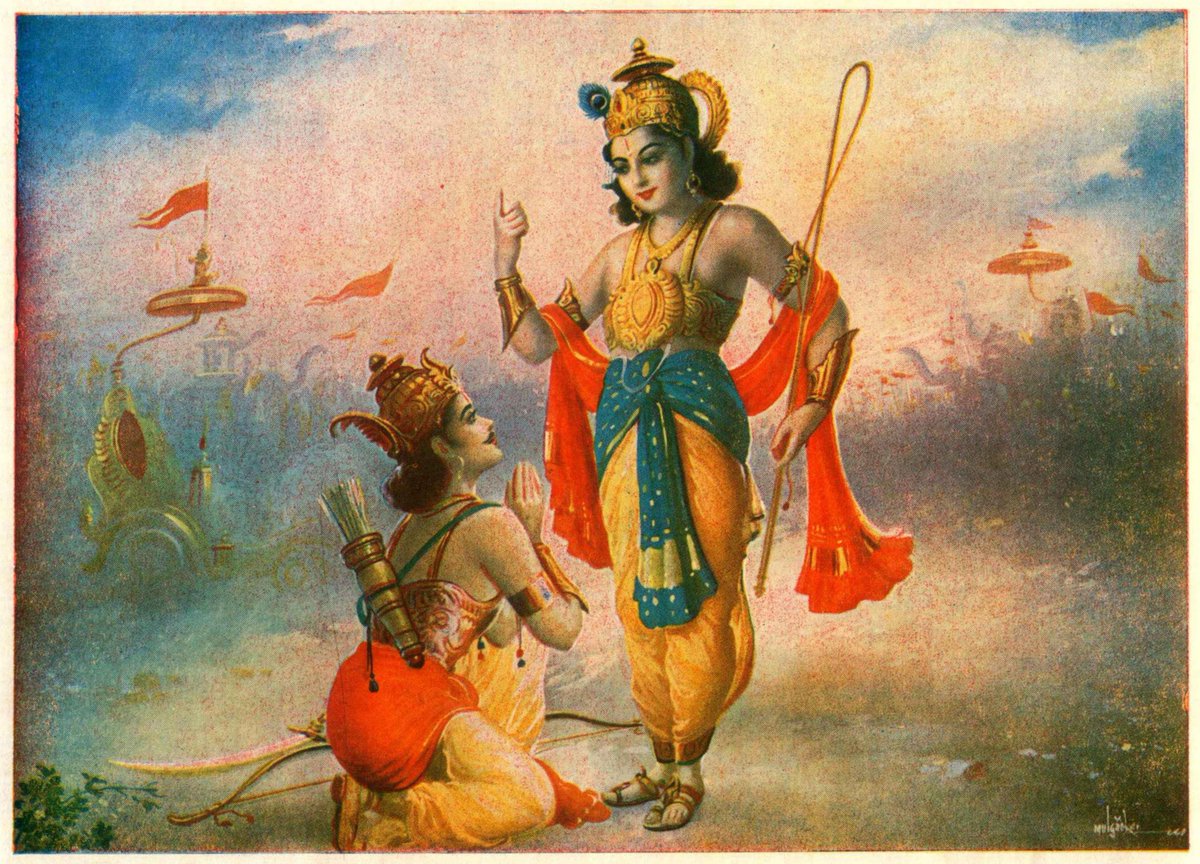
Why does Andal have to feel this way? Hasn't she dutifully observed the Pavai Nombu vrata through the month?
She says, "We are but simple, ignorant cow herders who follow cattle into the forest and eat together with them!
It is our blessing that You too are one of us!"
She says, "We are but simple, ignorant cow herders who follow cattle into the forest and eat together with them!
It is our blessing that You too are one of us!"

"Even if You too are from the same clan as us, you are faultless, immaculate, Govinda!" says Andal.
By implying kinship with Krishna by being from the same clan of cattleherders, Andal is referring to the 4 stages of going towards Paramapada.
What's that?
By implying kinship with Krishna by being from the same clan of cattleherders, Andal is referring to the 4 stages of going towards Paramapada.
What's that?
What are the 4 stages of Mukti?
Salokya (To be on same plane), Samipya(get near), Sarupya (sameness of form) and Sayujya( Complete union)
As the vrata nears completion, from Pasuram 27, Andal is focusing on Sayujya through Krishnanubhava.
Salokya (To be on same plane), Samipya(get near), Sarupya (sameness of form) and Sayujya( Complete union)
As the vrata nears completion, from Pasuram 27, Andal is focusing on Sayujya through Krishnanubhava.

But why does she address Krishna as the faultless, immaculate one?
Because she contrasts that with the faults she and the Gopis may have committed during the vrata!
Because she contrasts that with the faults she and the Gopis may have committed during the vrata!
So, Andal says "Govinda! We cannot live without You. Our bond with You is eternal.
As you know, we are simple, innocent girls.
So, if we have taken liberties during the Vrata and called You with modest epithets, don't be angry with us!"
As you know, we are simple, innocent girls.
So, if we have taken liberties during the Vrata and called You with modest epithets, don't be angry with us!"

"Forgive our faults of ignorance and of love towards You!
Accept us and give us Parai!"
Why would Bhagavan be angry with Andal?!
He is Bhaktavatsala,Deenadayala!
He is the cowherd who accepts cattle despite their faults!
He readily accepts Andal's vrata born out of Bhakti!
Accept us and give us Parai!"
Why would Bhagavan be angry with Andal?!
He is Bhaktavatsala,Deenadayala!
He is the cowherd who accepts cattle despite their faults!
He readily accepts Andal's vrata born out of Bhakti!

With that we come to the end of 28th Pasuram!
Thank you for reading!
Thank you for reading!
Starting with the 29th Pasuram!
In a manner of speaking, this is the last Pasuram of Andal as a Gopi girl.
She has already entered the radiant glow of Krishnanubhava.
So, what does she say in this Pasuram?
In a manner of speaking, this is the last Pasuram of Andal as a Gopi girl.
She has already entered the radiant glow of Krishnanubhava.
So, what does she say in this Pasuram?
She says, "Oh Govinda! We come early in the morning, to worship You and praise Your golden feet!
Why are we doing all this?"
"Uh huh!" says Krishna, listening eagerly!
Why are we doing all this?"
"Uh huh!" says Krishna, listening eagerly!

"You know. Govinda, You took birth in our clan of cowherds! Aren't You our clansman? We are here but to take orders from You!" 

Classic reversal at play here!
Andal imagined herself as a Gopi, because Krishna was born in the Yadava clan.
Now she says He's their clansman because He was born in their clan!
The chronology of events is inverted!
Andal imagined herself as a Gopi, because Krishna was born in the Yadava clan.
Now she says He's their clansman because He was born in their clan!
The chronology of events is inverted!
"So, Govinda", says Andal, "we have come to collect Parai from you, but not just that.
Forever and for every one of our births, we will be only Yours and will be forever in your Seva!"
Forever and for every one of our births, we will be only Yours and will be forever in your Seva!"

With that being the wish of the Gopis, what do they ask of Govinda?
"We are going to be in Your service this birth and every one after, so rid us of all other desires!"
That's the wish of the Gopis!
"We are going to be in Your service this birth and every one after, so rid us of all other desires!"
That's the wish of the Gopis!

Thus we come to the end of the 29th Pasuram, and the Paavai Nombu Vrata as well!
Let's see how Andal concludes the Tiruppavai tomorrow!
Thank you for reading!
Let's see how Andal concludes the Tiruppavai tomorrow!
Thank you for reading!
Before we start with Pasuram 30, let's do a quick recap of Tiruppavai.
In the 1st Pasuram, Andal spoke about the Paavai Nombu Vrata and what the objective of the Vrata was.
In the 1st Pasuram, Andal spoke about the Paavai Nombu Vrata and what the objective of the Vrata was.

In Pasuram 2, Andal gathered her friends, visualised herself and them as Gopis, and spoke about the rules and regulations, dos and don'ts of the vrata.
In Pasuram 3, she discussed benefits (Rain, abundance of harvest, and milk) that would accrue to society if vrata is observed!
In Pasuram 3, she discussed benefits (Rain, abundance of harvest, and milk) that would accrue to society if vrata is observed!

In Pasuram 4, she sought for copious rains, for the right conditions to observe the vrata.
In Pasuram 5, she sought her friends to sing the praise of the Lord, in order to burn sins of past and future.
In Pasuram 5, she sought her friends to sing the praise of the Lord, in order to burn sins of past and future.

As we have seen, the objective (Upeya) of the Vrata is Krishnanubhava.
The means (Upaaya) towards this objective is also Krishna Himself.
The means (Upaaya) towards this objective is also Krishna Himself.

In Pasurams 6-15, Andal went from house to house waking up her Gopi friends for them to jointly observe the Pavani Nombu vrata! 

In Pasurams 16-17, Andal and the Gopis seek the approval of the Dvarapalakas, Nandagopa, Yashoda, Balarama.
In Pasurams 18-20, Andal addresses Nappinnai (Lakshmi) to approach Krishna, as the Two are One (Eka Seshitvam)
In Pasurams 18-20, Andal addresses Nappinnai (Lakshmi) to approach Krishna, as the Two are One (Eka Seshitvam)

As we can see, with each Pasuram, Andal moves a step closer to the objective of Krishnanubhava.
In the last 9 Pasurams, she addresses Krishna directly, seeking the blessings of the items the Gopis need to complete their fast.
In the last 9 Pasurams, she addresses Krishna directly, seeking the blessings of the items the Gopis need to complete their fast.
There is a distinct shift of tone in the last few Pasurams, with loops opened in the first 5 Pasurams are closed.
Thus, avoiding ghee and milk etc., is brought to an end, with an indulgence in the Madhuram of Akkara Vadisal (Sweetness of Jaggery Pongal)
Thus, avoiding ghee and milk etc., is brought to an end, with an indulgence in the Madhuram of Akkara Vadisal (Sweetness of Jaggery Pongal)
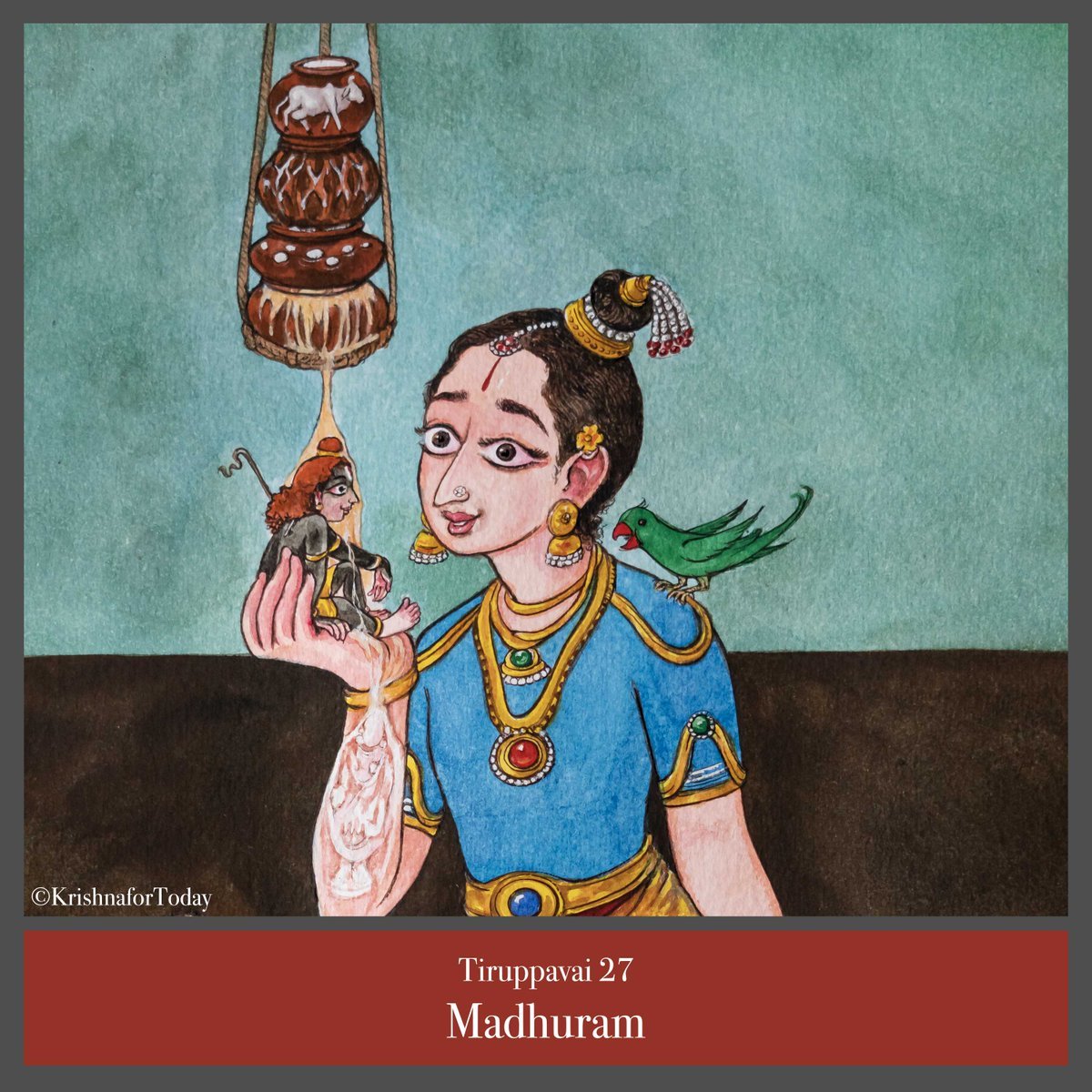
In Pasuram 29, Andal vows eternal service to the Lord, in every birth they take and request Him to rid them of all other desires. 
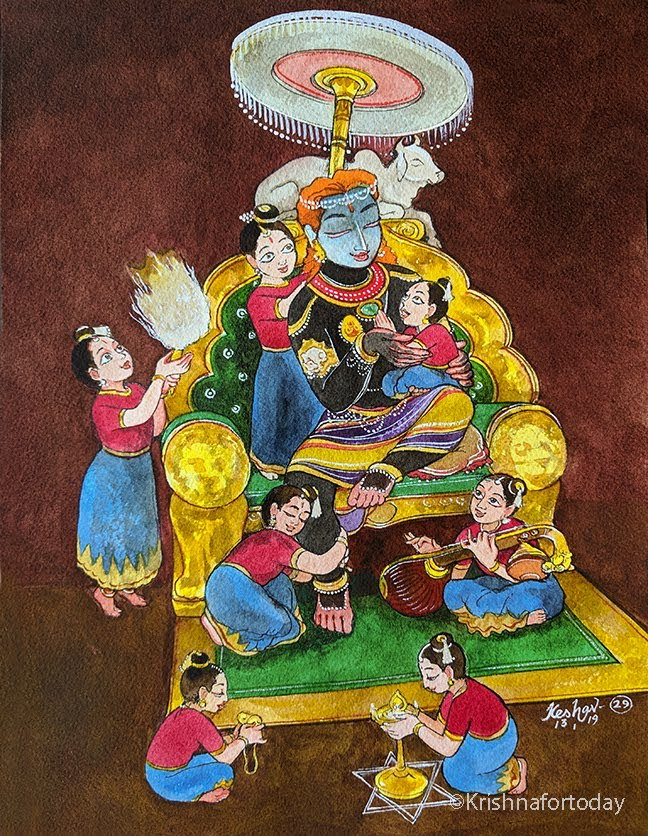
The author who became the Gopi to observe Paavai Nombu Vrata through Pasurams 1-29, now returns to the fore.
It is only in the last Pasuram that the author introduces herself by the name her father gave her, Kodhai!
So, what does she say?
It is only in the last Pasuram that the author introduces herself by the name her father gave her, Kodhai!
So, what does she say?

Gopis with faces as beautiful as the moon went to meet the one who churned the Ocean in which Vangam boats travel.
Who is He?
He is Madhava, the husband of Ma Lakshmi!
Who is He?
He is Madhava, the husband of Ma Lakshmi!
https://twitter.com/jeysundhar_d/status/1474380764213035029

How was Vishnu involved in Samudra Manthan, you ask?
He was the tortoise (Kurma Avatara) on whose back sat Mount Mandara as the churning rod.
He was the tortoise (Kurma Avatara) on whose back sat Mount Mandara as the churning rod.

But that wasn't the only churning, is it?
Here he is!
After all, if life is the churning process, the sweet butter that emerges out of it is the Krishnanubhava!
Here he is!
After all, if life is the churning process, the sweet butter that emerges out of it is the Krishnanubhava!

Andal perhaps uses the metaphor of churning to compare it with the arduous vrata that they have been observing during the month of Margazhi.
Like how Vishnu became one with Sri (Lakshmi), they too would like to be inseparable from Him!
Like how Vishnu became one with Sri (Lakshmi), they too would like to be inseparable from Him!

As we had seen in Pasuram 7, Gopis churning curd to get butter for Krishna, as we churn our hearts to get Bhakti for Krishnanubhava
And this is also why Andal once again invokes the name of Kesava in Pasuram 30, as she had done in Pasuram 7.
https://twitter.com/jeysundhar_d/status/1473648540253626369
And this is also why Andal once again invokes the name of Kesava in Pasuram 30, as she had done in Pasuram 7.
Ok, so Gopis with faces bright as the moon (Remember Pasuram 1 starts with the full moon in the month of Margazhi? That loop completes here with the reference to Gopis faces being as bright as the full moon!)
These Gopis have worn rich ornaments.
Why?
These Gopis have worn rich ornaments.
Why?

Because, they went to meet the Madhava and Kesava who churned the Ocean!
What did they do when they met Him?
They prostrated and prayed to Him!
What for?
What did they do when they met Him?
They prostrated and prayed to Him!
What for?
Andal, the author, enters.
The way in which Gopis observed the Paavai Nombu Vrata
went to Krishna
prayed and received in return the blessing of Krishnanubhava
is explained in these 30 Pasurams by Kodhai, daughter of Bhattar (Vishnu Chithar -Periyazhvar)
in Tamil
The way in which Gopis observed the Paavai Nombu Vrata
went to Krishna
prayed and received in return the blessing of Krishnanubhava
is explained in these 30 Pasurams by Kodhai, daughter of Bhattar (Vishnu Chithar -Periyazhvar)
in Tamil

So, now comes the message for us.
Andal says, upon those who recite these Pasurams, the one with
4 mountainous shoulders (Chatur Bhuja Vishnu),
red lotus-like eyes,
i.e. Vishnu, the Lord of Sri
will grant His blessings for all eternity.
Andal says, upon those who recite these Pasurams, the one with
4 mountainous shoulders (Chatur Bhuja Vishnu),
red lotus-like eyes,
i.e. Vishnu, the Lord of Sri
will grant His blessings for all eternity.
Thus, in addition to observing Paavai Nombu vrata and attaining her goal of Krishnanubhava, Andal has also left behind the 30 beautiful Pasurams of Tiruppavai,
for us to recite during Margazhi and receive the blessings of Krishna!
for us to recite during Margazhi and receive the blessings of Krishna!
With this, we come to the end of the month of Margazhi and our Tiruppavai thread.
Reaching just over 500 tweets, this is the longest thread I've written so far.
A big thanks to all of you who have stayed with the thread over the course of the last month. 🙏🙏
Reaching just over 500 tweets, this is the longest thread I've written so far.
A big thanks to all of you who have stayed with the thread over the course of the last month. 🙏🙏
While written in Tamil, the Tiruppavai draws upon various works ranging from the Shruti literature(Vedas and Upanishads), Itihasa-Puranas including the Bhagavad Gita and Srimad Bhagavatam.
Writing this thread gave me the opportunity to study, if only at surface, these works!
Writing this thread gave me the opportunity to study, if only at surface, these works!
I'm sure I have made errors natural to a beginner, while attempting this thread. I seek forgiveness of the learned.
I know that the thread is only a beginning &I hope it has stirred enough interest in the reader, as it has in me, to explore works by Acharyas on the Tiruppavai.
I know that the thread is only a beginning &I hope it has stirred enough interest in the reader, as it has in me, to explore works by Acharyas on the Tiruppavai.
As I conclude, I would like to thank the blessed @keshav61, for it is upon his depictions of Pasurams that I have placed great reliance in attempting to make my humble attempt seem meaningful.
May Andal's Tiruppavai bless us all with Krishnanubhava!
Thank you.
May Andal's Tiruppavai bless us all with Krishnanubhava!
Thank you.
@threadreaderapp Please compile.
• • •
Missing some Tweet in this thread? You can try to
force a refresh










